Business Plan Examples for Students
Ajay Jagtap
- December 29, 2023
26 Min Read
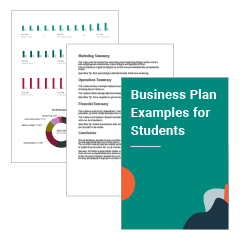
Do you know what’s the most common mistake students and rookie entrepreneurs make while preparing their first business plan?
Of course, it’s the first business plan we’re talking about; there’ll definitely be a few. However, overcomplicating things and failing to consider a business plan example still remains the most common one.
That’s why we decided to come up with a solution. We’ve curated this list of top business plan examples for students to help you get going.
So whether you need a business plan for a college project, start a side hustle, or win a business competition, these examples are just what you need to create business plans that stand out.
Ready to dive in? Let’s start by understanding the key elements of a business plan example:

Key Elements of a Business Plan Example
Business planning is not as complicated of a process as people think it is; they’re just overcomplicating things. (Don’t think so?)
Let’s simplify the key elements that make up a comprehensive business plan; you’ll understand it better that way.
- Executive Summary: A high-level overview or summary of your plan.
- Company Overview: A detailed description of your business idea, its fundamental elements, history, and future goals.
- Market Analysis: A study of your external business environment that includes details about your industry, competitors, and target market.
- Products and Services: Description of the products or services you intend to exchange for money.
- Sales and Marketing Strategies: A section outlining sales and marketing strategies your business will implement to achieve its financial goals.
- Operations Plan: A section outlining the business processes and daily activities involved in ensuring seamless business operations.
- Management Team: Introduction to your founders, key management, and their compensation plan.
- Financial Plan: Your financial plan is a detailed breakdown of your business’s financial projections and financing needs.
That’s pretty much it about the key elements of a business plan example. Next, let’s explore the best business plan examples for students.
Say goodbye to boring templates
Build your business plan faster and easier with AI assistant
Get 30% off for Students and educators

Top Business Plan Examples for Students
Now that you already know about the components of a business plan template, let’s review some of the best business plan examples for students.
1. Startup Business Plan Example
Upmetrics’ startup business plan example is the ideal solution for students planning to start up or participate in a business plan competition. This business plan template follows the SBA-approved business planning format used by thousands of successful entrepreneurs.
Whether your startup is about a new-age AI-based application, an online shopping site, or traditional IT consulting—this sample business plan is just what you need.
Unlike any traditional small business plan, this example of a startup business plan is lean and agile in approach, focuses on innovation, and emphasizes market validation.
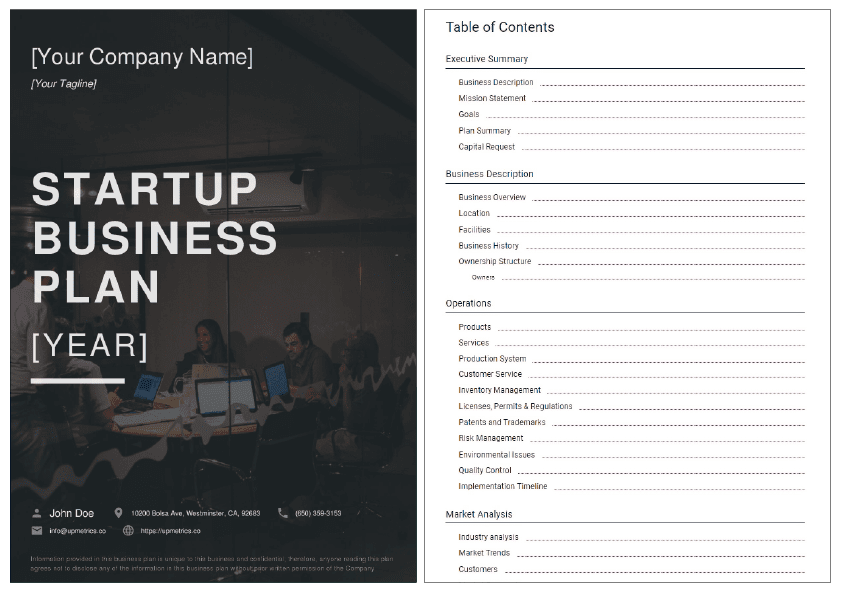
2. Lean Business Plan Example
Since you’re transitioning from a student to an entrepreneur, you may not have enough time to spend on creating a detailed business plan. That’s where this lean business plan template can help.
It’s a condensed version of a traditional plan summarizing all its sections with a primary focus on covering only the critical aspects of the business.
This template is best for startups or businesses uncertain about business planning and student-turned-entrepreneurs with limited time and resources to prepare a business plan.
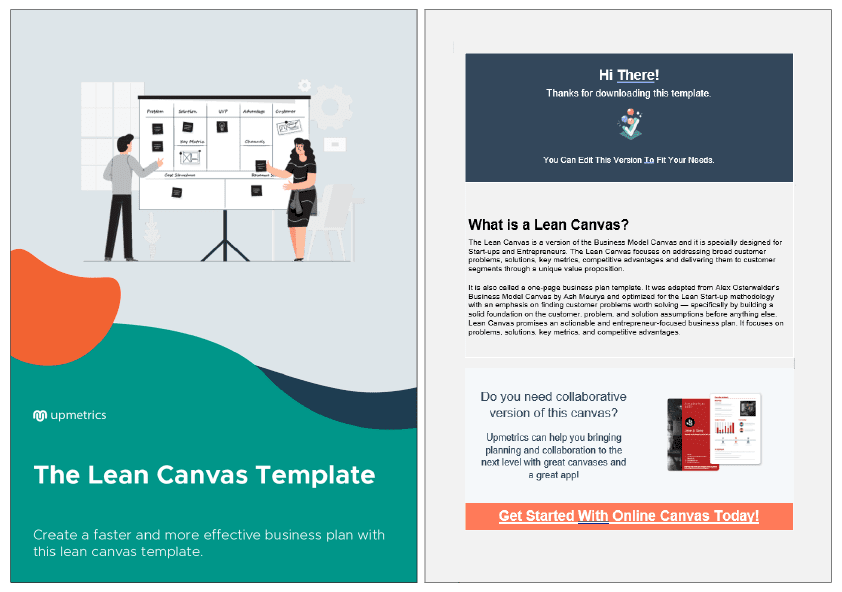
3. SBA Business Plan Example
Following an SBA-recommended business plan format is key to securing bank loans and business grants. Since it can be time-consuming to find a template that follows a similar outline as the SBA, this SBA-approved business plan example is the way to get started.
This SBA business plan template has nine primary sections, that include executive summary, company description, market analysis, organization, product description, marketing, funding request, and financial projections.
SBA business plan examples ensure you stay on track and don’t deviate from your funding needs.
4. One-Page Business Plan Example
As you may have already guessed, a one-page business plan is a one-page version of a traditional business plan. Since it’s a condensed version of a business plan, drafting it can be quite easy and quick compared to a lean or traditional plan.
Employees, partners, and vendors often use one-page business plans as a quick overview of your company and banks and investors as a summary of your operations.
While it may not be the ideal choice for entrepreneurs seeking investment or bank loans, students with side hustles and idea-stage startups can consider this option.
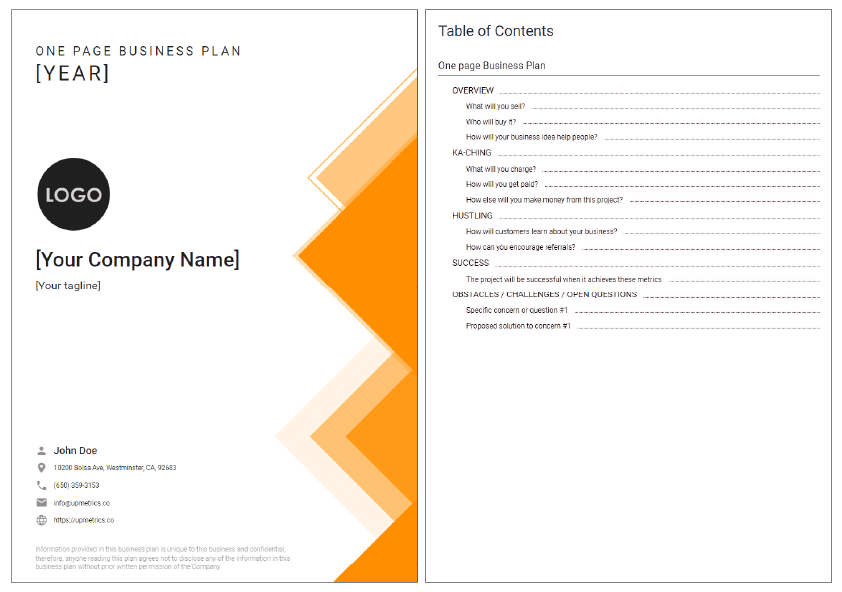
5. HBS Sample Business Plan
Harvard Business School’s new venture competition selected this sample business plan as a finalist in 2011.
This is a business plan of App Success, a collaborative web-based platform that connects low-income high school seniors with college students from top universities; this business will enable them to collaborate on college selection, college applications, and financial aid applications.
This example can be a great reference for those planning to start a mobile or web-based solution.
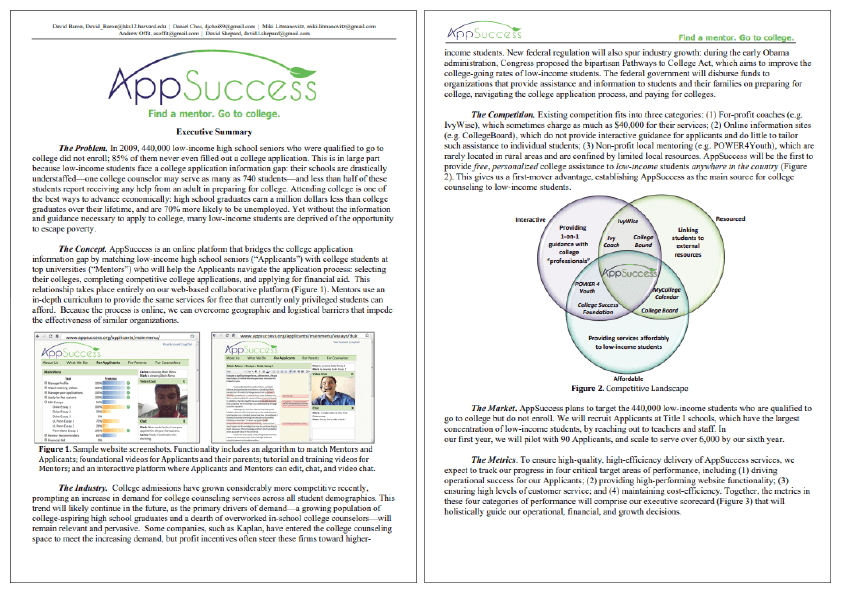
6. Kean University Sample Business Plan
Kean University organizes a business plan competition every year for its students where students prepare and present business plans to compete, and this is one of the sample business plans the University provides to participants to understand the format.
It’s a business plan of Blue Water Boatworks, Inc., a boat detailing and cleaning company specializing in servicing recreational fiberglass and aluminum watercraft.
This example can be a great reference for those planning to start a business related to housekeeping, cleaning, or maintenance.
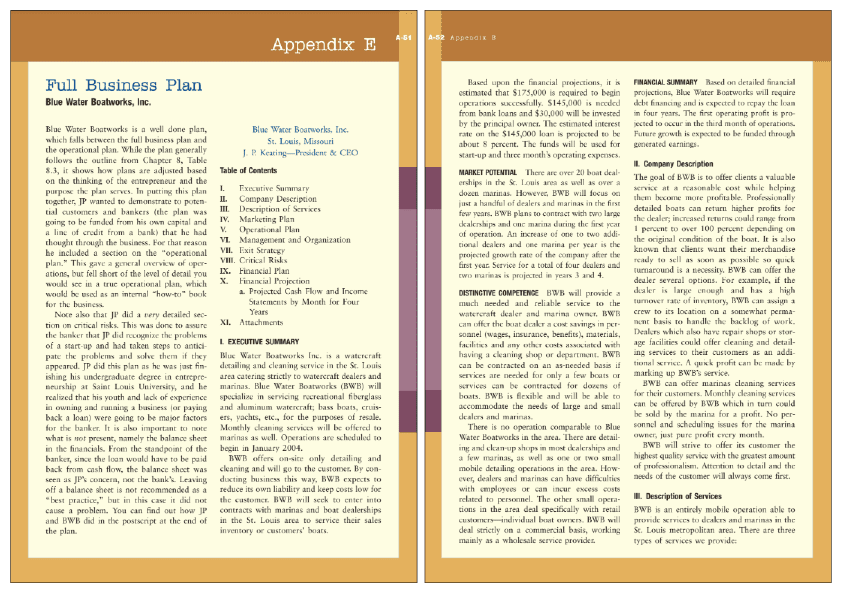
7. UVM Sample Business Plan
If you are looking for a strategic business plan for a food business, the University of Vermont’s Fancy Foods Business Plan can be a guiding resource for you.
Despite the fact that it can be a good reference for detailed planning, it was written in 1998, so any statistics and numbers may not seem relevant to today’s market landscape. Make sure you keep that in mind.
You may closely follow this example as a reference if planning to start a food truck, restaurant, or any other business that serves food.
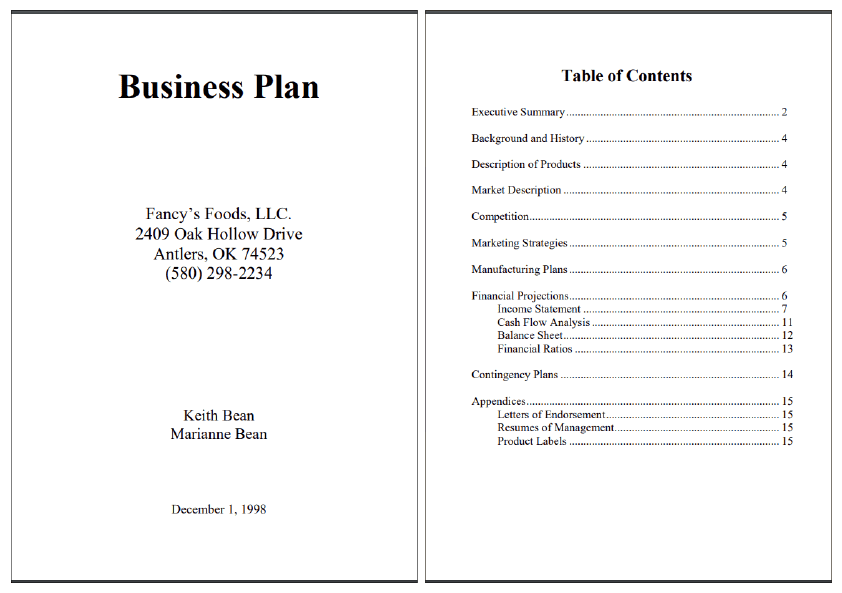
That was the list of best sample business plans for students. However, there’s more to talk about. You now have a business plan example, but what about pitching to investors? Let’s explore free pitch deck examples for students.
Free Pitch Deck Example for Students
Pitching to investors as a first-time founder can be exciting but also overwhelming at times. Worry not; we’ve got a solution—investor pitch templates. We’ve prepared a set of 8 investor pitch templates and examples for students and entrepreneurs to help create winning business pitches.
Whether you need a pitch to find an opportunity, ask for subject matter knowledge, or a problem-solving pitch, these investor pitch examples have got you covered. Download now.
How to write a winning plan for a business plan competition?
Creating a business plan is no different than creating one for a real business. Similar to how entrepreneurs prepare and present business plans to investors, Students in business plan competitions pitch to judges.
In short, the business planning process remains exactly the same. Let’s discuss how you can write a winning plan to help you win a business plan competition.
- Select a compelling business idea : everything starts with a compelling idea. Make sure you have a viable business idea to compete in the competition.
- Refer to winning business plan examples : Once you are sure about your business concept, refer to business plan examples from previous winners and how they planned the sections of their plan.
- Market Research & Industry Analysis : After referring to business plan examples, conduct industry research and market analysis to make your statistical and financial numbers accurate and realistic.
- Understand business model and revenue streams : Since you are preparing a business plan for a company that doesn’t exist, be sure about the business model and how the business will generate profit.
- Use AI business plan generator : Using an AI business plan generator like Upmetrics can be incredibly helpful in speeding up the business planning process. With industry-specific business plan templates and AI assistance to write your plan, you can write the first draft of your plan in literally no time.
- Presentation and visuals : Prepare visuals and graphs to make your business plan visually appealing and numbers digestible. You may not need to prepare these visuals if you use business plan software manually.
- Proofread and edit : Grammatical errors are the last thing judges want to see in a business plan. Make sure you proofread and edit your draft thoroughly before submitting it.
Easy as that, that’s the way to write a perfect business plan that can lead you to victory in any business plan competition on planet Earth. Let’s have a look at a real-life business and financial plan example.

Business and Financial Plan Example for Students
Having learned about business planning for students, let’s quickly discuss a coffee shop sample business plan and financial statements prepared using Upmetrics.
1. Executive Summary
The Cooper’s Cup will be a new cafe in Phoenix, Arizona. The 1,500 square foot café will be located in the newly constructed Market Square Plaza on the northeast corner of 135th Street and Mission Street. The anchor tenant, the Price Chopper grocery store, has already taken occupancy, and the excellent location brings more than 10,000 shoppers weekly.
The Cooper’s Cup, aptly named for the aromatic brown liquid that will fill the cup, fills the void of original cafes in the market and stands out from its corporate peers with its fast food concepts and prompt services. The Cooper’s Cup is the alternative to fast food/commercial/coffee shops and offers a much calmer, civilized gourmet coffee experience.
There are no televisions in the cafe, the background music is subtle, and work from local artists will hang on the walls. The restaurant is well-appointed, with overstuffed leather chairs and sofas in a library-like setting. The cafe is reminiscent of times gone by – yet is cutting edge technologically with WIFI and state-of-the-art espresso machines.
The Cooper’s Cup measures its financial success in terms of increased market share and earnings. This is a tremendous opportunity with a total local market of $54 million! The keys to success will be offering quality gourmet coffees, taking advantage of its small size, and relying on an outstanding barista staff.
To achieve these goals, the cafe will present some of the area’s finest gourmet beans from local distributors. Because of its small size, the restaurant can enjoy larger margins through lower overhead. The cafe will hand-select baristas and offer salaries comparable to the chains. The baristas will be trained to cross-sell and sell higher-margin products.
The primary objectives of the business plan for Cooper’s Cup are below:
- To increase revenues by $36,000 or 5% in Year 2 and $73,000 or 10% by Year 3
- Achieve a profit margin of 5.2% in Year 2 and 6.90% by Year 3
- Be the Cafe of Choice in the Phoenix area and the recipient of the Best Coffeehouse Award.
Guiding Principles
The Cooper’s Cup is committed to values such as excellence, passion, quality, integrity, and leadership, allowing them to navigate challenges and provide for future opportunities. These core beliefs start with their commitment to their products and their employees. Cooper’s Cup rewards excellence and cherishes loyalty. The cafe will work with its employees to build strong businesses and a secure future.
Mission statement
The Cooper’s Cup is committed to its products and employees, which they believe is the recipe for market success.
Key to success
The Cooper’s Cup stands out from the competition. Below are their Keys to Success:
- Great Products : providing exemplary products at market prices – will make customers want to return again and again.
- Hire Quality Baristas : Pay employees rates similar to the larger chains with opportunities for long-term careers and opportunities for advancement with long-term plans to open a second facility.
- Convert Customers to Connoisseurs : Only 40% of the nation’s coffee drinkers consume premium ground and whole bean coffee – this will aid in the continued growth.
Financial Summary
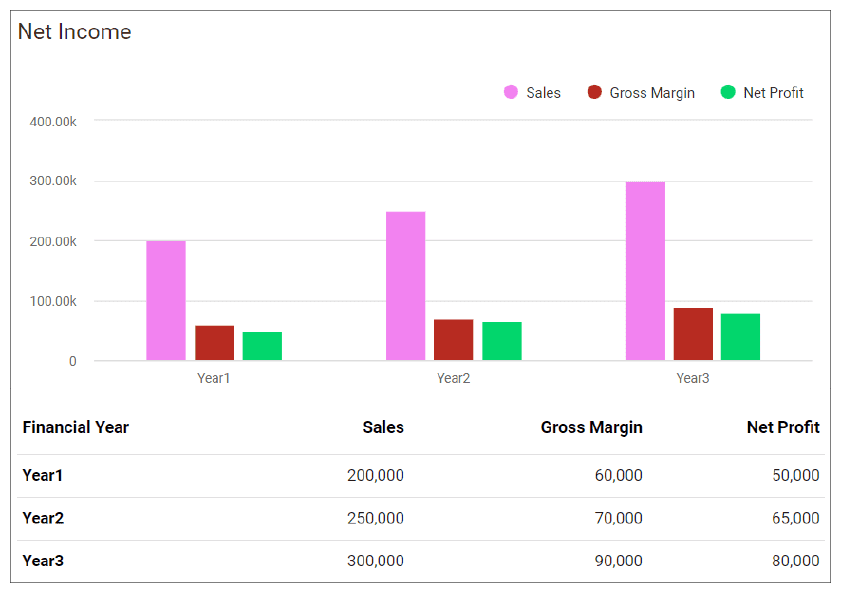
2. Business Overview
The Cooper’s Cup will be a coffee house/cafe located in Phoenix, Arizona. The cozy cafe will be located in the newly completed Market Square Plaza in the Arizona City area. The cafe will serve gourmet coffee, espresso, drip coffee, lattes, and smoothies. The simple pastry offerings may vary with seasonality, but the primary line will be muffins, bread, cookies, scones, and rolls. All pastries will be supplied daily by a local bakery.
The cafe will be owned and operated by Owen Jones, a veteran restaurateur with several years of experience running and managing chain restaurants. The cafe will be open for business Monday – Thursday 7-10, Fridays and Saturdays, 7-11, and closed Sundays.

The Cooper’s Cup will be formed as an S-Corporation owned by Mr. Doe.
Start-Up Summary
The Cooper’s Cup will have seating for 40 patrons. The rent is $2,075 a month, with a three-five-year lease available. The site comprises 1500 square feet of leased space consisting of a dining room, a coffee bar, two restrooms, and a storage room in the back.
This storefront needs to be plumbed and wired appropriately to be used as a restaurant. Painting, new floors, and countertops are also needed. A custom coffee bar needs to be built. With materials bought on sale and volunteer labor, the cost to renovate will be $71,725.
The coffeehouse equipment will consist of two commercial espresso machines, air pots and urns, a commercial blender, a commercial brewer, top-loading coffee bins, barista syrups, cold drink dispenser, frothing equipment, a commercial refrigerator, microwave, and stainless steel prep bar.
The cost of the equipment is $38,275. The furniture will consist of leather couches and chairs (purchased at auction), coffee tables, bookcases, and window treatments. The artwork will come from local artists and be sold on a consignment basis. The books were secured via donations. The total cost to furnish is $14,000. Other startup expenses will be dishes, furniture, rent deposit, and marketing.
Location and Facilities

The new coffeehouse is located in the highly desirable Phoenix, Arizona, area at the northeastern intersection of 135th Street and Mission Street in the Newmarket Square Plaza. The property is situated in an excellent location, with an easy 6-minute drive time to I-435 and 69 Highway.
The property is 95% leased with Price Chopper as the Anchor Tenant. Other tenants include LifeSpring Med Spa, Jane’s Canines (Pet Store & Boarding), Pride Cleaners Kahn Dental, and Swim U.
Price Chopper brings more than 10,000 shoppers per week to the center. The location comprises a population of 9,420 within a one-mile radius, 61,102 within a 2-mile radius, and 149,550 within a 5-mile radius – with a median household income of $120,856. Sprint / Nextel’s corporate office is within 2 miles of the site.

3. Market Analysis
Phoenix, Arizona, is an award-winning place to live and work and is considered the leading business community in the Midwest. National publications and organizations recognize Phoenix for its business environment and livability. Here’s a sampling: 6th Place, America’s Best Places to Live Money, Top 50 Cities to Live and Play, National Geographic Adventure, 3rd Hottest Town in the U.S., Money, Among 20 Best Places to Live & Work Employment Review, One of only 72 Sterling Tree Cities in the U.S., National Arbor Day Foundation, Top 10 best Locations to Raise a Family, Southern Business and Development, 1st Place, Kid Friendly Report Card, Population Connection, 2nd Best City in America to Live Business Development Outlook.
Phoenix is at the core of one of the most dynamic local markets in the U.S. It offers easy access to the Arizona City region’s amenities, and, as part of the Arizona City metropolitan area, it is within the most centrally located major market in the nation. I-35, I-435, I-635, and U.S. Highway 69 all pass through Phoenix, and no point in the city is more than 3.5 miles from a freeway. The city maintains an excellent arterial street network and plans to construct additional lane-miles as the area grows. Three airports serve the region. Arizona City International Airport (MCI) is just 25 interstate highway miles north of Phoenix. Johnson County Executive Airport—the second busiest in Arizona—provides complete services for private business jets and general aviation. New Century AirCenter, just 12 miles southwest of the city, offers available aviation services and accommodates cargo or passenger jets of any size.
Phoenix supplies some of the most highly educated workers in the nation, with 97% of Phoenix adults over age 25 holding at least a high school diploma. Johnson County, where Phoenix is located, ranks first among the country’s 231 counties with populations greater than 250,000. The county ranks sixth in the percentage of adults with at least a bachelor’s degree and 16th with a graduate or professional degree.
The Phoenix area has a population of 175,265, based on the 2010 census. The median household income is $77,881, and the median age is 37.9. (2010 U.S. Census)
Industry Analysis
The U.S. coffee shop industry includes about 20,000 stores with a combined annual revenue of about $10 billion. Major companies include Caribou Coffee, International Coffee & Tea (The Coffee Bean & Tea Leaf), Peet’s Coffee, and Starbucks. The industry is concentrated: the top 50 companies generate more than 70 percent of sales. Coffee shops are part of the specialty eatery industry, including retail outlets specializing in bagels, donuts, frozen yogurt, and ice cream products. (First Research)
Competitive Landscape
Consumer taste and personal income drive demand. The profitability of individual companies depends on the ability to secure prime locations, drive store traffic, and deliver high-quality products. Large companies have advantages in purchasing, finance, and marketing. Small companies can compete effectively by offering specialized products, serving a local market, or providing superior customer service. Specialty eateries, which include coffee shops, are labor-intensive: average annual revenue per worker is about $50,000. Coffee shops compete with convenience stores, gas stations, quick service, fast food restaurants, gourmet food shops, and donut shops. (First Research)
Market Size
The U.S. coffee shop industry includes about 20,000 stores with a combined annual revenue of about $10 billion. Major companies include Caribou Coffee, International Coffee & Tea (The Coffee Bean & Tea Leaf), Pet’s Coffee, and Starbucks. The industry is concentrated: the top 50 companies generate more than 70 percent of sales. (First Research)
Target Market and Segment Strategy
Most adult coffee drinkers said their lifelong habits began during their teenage years. 54% said they began drinking coffee between 13 and 19. Another 22% reported their coffee cravings started between 20 and 24. This means that 76% of adult coffee drinkers began drinking coffee by the time they were 24. So, despite a large amount of marketing and advertising directed at the younger age groups, savvy coffee shop owners will remember to cater some of their offerings to the adult and senior market. (National Coffee Drinking Study).
The Cooper’s Cup will offer a unique experience for coffee enthusiasts by providing a quiet, cozy, yet sophisticated cafe and a sense of refinement and peace in an otherwise hectic and fast-paced world. While other coffee shops cater to convenience with drive-throughs or loud music venues late into the night, the Cooper’s Cup will stand apart from its competitors with its quiet yet soothing ambiance, capturing a truly unique (and much-needed) market niche.
- Unique products (specialized roasts, local ingredients, locally-themed or named drinks, custom drinks by the star barista, etc.)
- Games, puzzles, mind benders, and other activities that encourage customers to linger over their coffee
- Hosting or sponsoring local events (entertainment, readings, book clubs, etc.)
- Using technology to creatively compete in marketing with big chains — services like FourSquare, Yelp, and Google Places can increase visibility in the local market.
- Delivering amazing service from knowledgeable baristas — spend lots of time training staff and utilizing online services like the American Coffee & Barista School.
- Selling coffee-related items (and tracking down any co-marketing opportunities with a local community college or another student-related group in the area)
4. Products and Services
Product/services descriptions.
The Cooper’s Cup’s primary offering is gourmet roasted coffees with mocha, carmelicious, white mocha, candy bar latte, and brewed coffee. Complementing the coffee will be a smoothie line including wild berry, strawberry, peach, mango, and lemonade. Rounding out the simple menu line will be pastries obtained from an outside supplier, freshly made and delivered daily. The pastry offerings may vary with seasonality, but the primary line will be muffins, bread, cookies, scones, and rolls.

Product/Service Sourcing
The Cooper’s Cup has negotiated supplier agreements with several local food-service wholesalers and coffee wholesalers in the Phoenix area that have a reputation for quality and reliability:
- Mean Beans Coffee Roasters
- Phoenix Brewers
- Healthy Harvest Bread Co.
- Mary’s Organics
If one of the abovementioned specialty suppliers cannot meet their needs, the following national suppliers can provide all the food-service products they require. In addition, the following wholesalers will supply the cafe with general restaurant supplies:
- Lawrence Food Products Corp.
- Gerry Food Supply Inc.
Future Products/Services
Young families, which comprise Phoenix’s third largest market share, are often overlooked in the coffee market. Coffeehouses traditionally have not been considered ‘kid’ friendly. To overcome this hurdle, Cooper’s Cup has long-term plans (5 years) to open a 2nd coffee shop: A combination indoor play area/coffee bar. This concept allows parents and caregivers to meet and relax with other adults while the children can enjoy the indoor playground amenities.
Additional future services will include in-store sales for home purchases and an online store.
The website will have the option to purchase a prepaid gift card program – Prepaid gift cards provide immediate cash, reduce credit card transaction charges, and draw new customers to the business.
5. Sales and Marketing Strategies
Swot analysis.
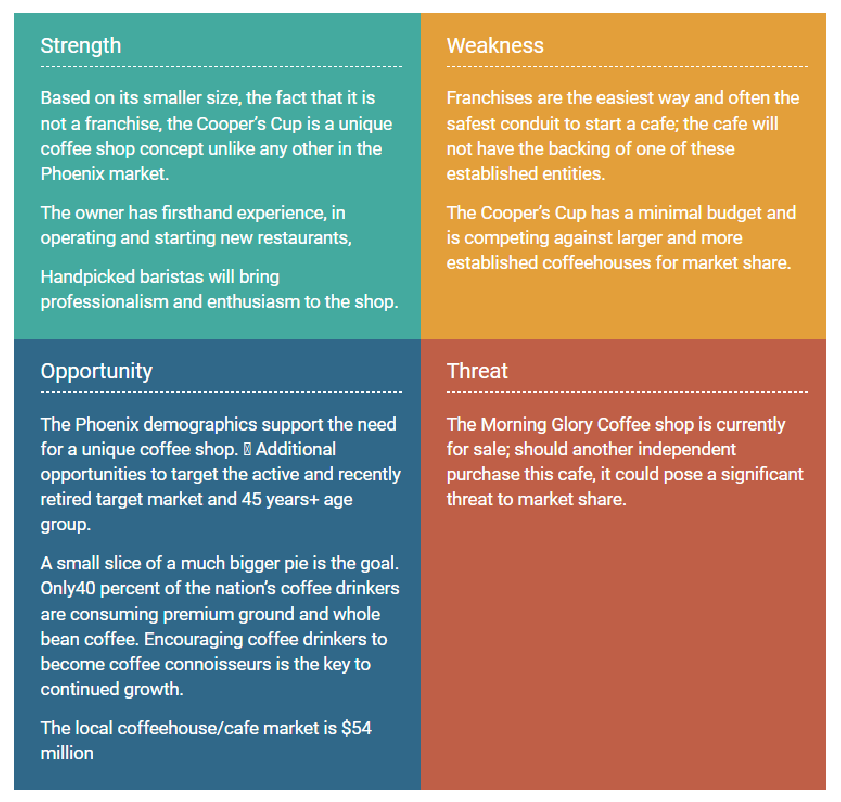
Unique Selling Proposition
The Cooper’s Cup stands out from a crowded sea of coffee chains and franchises. What sets it apart from the competition is primarily its smaller, cozier size combined with premium coffees served by knowledgeable baristas, providing so much energy and enthusiasm for its products.
Market Strategy and Positioning
The Cooper’s Cup utilizes a focus strategy on its Market. By specifically targeting three primary segments, they can cater specifically to their needs.
Senior Market (age 45+)
The Cooper’s Cup will target this Market simply by its well-selected location. Although this demographic group could readily drive downtown, they prefer a local cafe to unwind and relax and historically become some of the most loyal patrons.
Newly Hired Employees
The cafe will attract regular customers (weekly or more) – particularly the newly employed (first job) by providing free WIFI services and providing interesting games in the customer area.
Young Families
The third targeted Market, younger families, often find that coffeehouse is not ‘kid’ friendly. The company has long-term plans to create a combination coffee shop/play area so that parents and caregivers can meet with other adults while the children can enjoy the bounce houses, slides, and indoor playground equipment.
Pricing Strategy
The Cooper’s Cup primarily utilizes competition-based pricing. The cafe does not utilize coupons and discounts (other than opening promotions) because they believe that the most valuable customer demographic of daily coffee consumers is not influenced by discount programs or coupons.
Promotion and Advertising Strategy
- Online Advertising – The Cooper’s Cup will advertise regularly on popular social media sites like Facebook. Compared to traditional print advertising, this is a cost-effective tactic that will allow them to reach prospects in a highly targeted way (e.g., based on criteria such as age, gender, geography, etc.).
- Website – Cooper’s Cup will develop a simple Web site, which will provide basic information about the business, the menu, and links to their presence on the aforementioned social media channels.
- Radio Advertising – During the first six months of operation and the busy holiday shopping season, the business will advertise on local radio stations.
Sales Strategy
The Cooper’s Cup will use the following methods to increase sales revenue (as recommended by Andrew Hetzel on Better Coffee, Better Business):
- The menu will focus on the most profitable products sold. The cafe will always draw customer attention to the best products.
- As warranted, the cafe will raise prices to bolster its brand image. Prices communicate the perceived value of a product, so if set too low, the customers might assume that the beverages are inferior compared to the competition.
- Monitor flavoring inventory – Excess flavoring inventory ties up capital and valuable backroom space for storage. The cafe will utilize 4-6 varieties, including sugar-free offerings.
- Control waste and theft – audit sales and inventory reports to evaluate ingredient waste due to inefficient preparation, returned drinks, and employee consumption. Retail locations can easily waste 20% or more of their daily sales in these three key categories, which is a substantial and unnecessary loss.
- Monitor and evaluate hours of operation.
- Run employee sales contests – The baristas are the salespeople and have great influence over the customer ordering process. All baristas will have some form of sales and customer service training to make each transaction active rather than passive. Sales contests will emphasize high-margin items or cross-selling.
6. Operations Plan
Staffing and training.
An ongoing training and education program will ensure that each staff member learns and implements Cooper’s Cup’s exacting service and operational procedures standards. Staff meetings will reinforce service standards and principles. The Cafe will have detailed work descriptions and training programs for each position, from entry-level employees to the ongoing development of managers and owners. New employees will undergo an extensive training program. This ensures that each guest receives a quality experience from all employees, regardless of how long they have been employed. The Cafe embraces the concept of promoting from within. Excellence in one function typically leads to excellence in another. Regular staff evaluations and training will ensure motivation and address critical issues.
Inventory controls
The founder will be responsible for hiring and training managers who, in turn, will ensure that the day-to-day operations will comply with the standards set by Restaurant policy. Weekly management meetings will provide a forum to review and discuss financial and operational performance. Critical decisions related to purchasing, human resources, marketing, capital expenditures, and customer service will also be addressed.
Purchasing cost controls
Food preparation personnel will follow standardized recipes developed by the founders to control food costs and ensure consistency. The coffee shop will offer an innovative menu with nutritious food and beverages while achieving the most significant margin yield.
Customer Service
The hospitality business recognizes the client’s support experience is the critical driver to replicate business. The direction will Offer a superior degree of Professionalism by hiring individuals who deliver the ideal attitude to work and teaching them the skills required to accommodate guests. The restaurant will keep high levels of consumer satisfaction with talented, educated, and well-trained workers who understand and implement the fundamentals of fantastic service. Ongoing training will be provided to enable staff to perform their jobs with confidence and ability. Employees are well-spoken, well-versed, and trained to provide friendly, prompt, and professional service to each customer. This practice teaches employees who, by producing an exceptional customer experience, can optimize sales and raise their reimbursement. The team will have the knowledge and service required to create excellent daily service for every customer.
Technology & Software
While the quality of the cuisine and dining experience contributes significantly to a restaurant’s profitability, attention to business and financial details can transform small changes into significant returns. Critical sales, cost of sales, labor, inventory, marketing, and overhead metrics are monitored daily. Trends are evaluated, and constructive actions will be taken where improvement is needed. The management team will have access to the restaurant’s transactions and reports available in its real-time POS (point of sale) and accounting systems. Trends will be evaluated, and corrective action will be implemented as required.
7. Organization Structure
The Cooper’s Cup is formed as an S-Corporation wholly owned by John Doe.
Management Team
The Cooper’s Cup will be owned 100% by John Doe. Mr. Doe, a graduate of Arizona State University, has an undergraduate degree in business administration. During high school, he worked as a waiter in a local hospital coffee shop that purchased its beans from a local roaster. In addition to being an avid coffee drinker, this job allowed him to learn about the business first-hand. In college, Doe worked in a campus coffeehouse for four years, eventually becoming an assistant manager. Following graduation, Doe secured a business development position for a regional restaurant chain, which provided additional first-hand exposure to the food and beverage industry—especially the steps involved in establishing new locations.
Management Team Gaps
The Cooper’s Cup will rely on its POS (Point of Sale) system to generate daily accounting and cost activity reports. Mr. Doe will supply these to an outside bookkeeper for the preparation of annual income taxes.
Personnel Plan
Initially, the cafe will hire 1 manager, 5 baristas, and 2 part-time servers. In Year 2, the cafe plans to hire 1 additional full-time barista.
8. Financial Plan
Important assumptions.
- The sales forecast is conservative and assumes a 5% increase in Year 2 and a 10% in Year 3.
- The analysis accounts for economic seasonality – wherein some month’s revenues peak (such as holidays ) and wane in slower months.
- The analysis assumes the owner will not withdraw any salary till the 3rd year; at any time it is assumed that the owner’s withdrawal is available at his discretion.
- Sales are cash basis – nonaccrual accounting
- Moderate ramp-up in staff over the 5 years forecast
- Barista’s salary in the forecast is $36,000 in 2023.
- In general, most cafes have an 85% gross profit margin
- In general, most cafes have a 3% net profit margin
Projected Balance Sheet

Projected Cash-Flow Statement

Projected Profit & Loss Statement
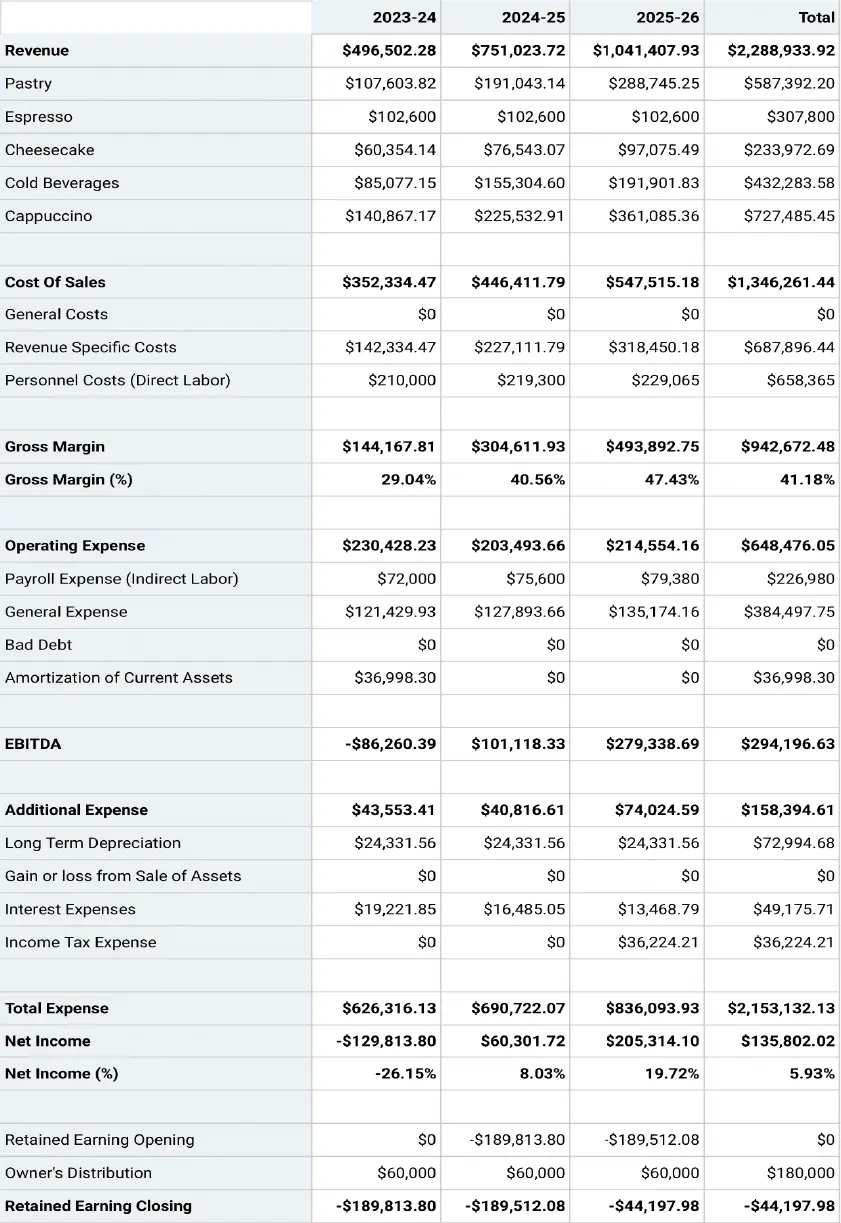
Break Even Analysis
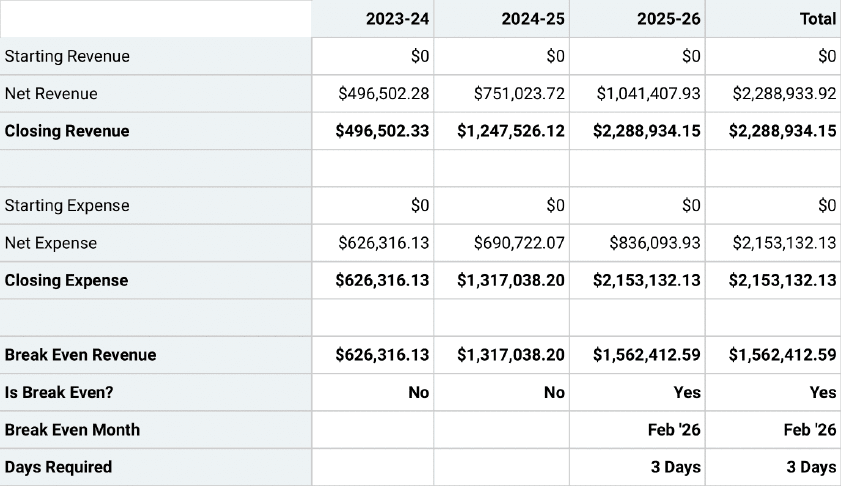
Write Your Business Plan With Upmetrics
Whether you need a business plan to compete in a competition, win investors, or gain a competitive advantage in the market landscape, Upmetrics can help you get started.
Upmetrics is an AI business plan software that comes with AI assistance, financial forecasting features, and 400+ sample business plans so that you can prepare a business plan in no time.
So what are you waiting for? Try Upmetrics and create your business plan in a snap.
Make your plan in half the time & twice the impact with Upmetrics
Fill-in-the-blanks, AI-assistance, and automatic financials make it easy.

Frequently Asked Questions
How do you write a business plan for a college project.
As mentioned earlier in the article, business planning for a college project or competition is no different than for a real business. You can write your business plan using these step-by-step instructions.
- Select a compelling business idea
- Refer to business plan examples
- Prepare a business plan outline
- Create a company description section
- Conduct market research and industry analysis
- Describe your product and services
- Outline sales and marketing strategies
- Create an operations plan
- Introduce management team
- Prepare financial projections
- Summarize your plan with an executive summary
What is a business plan for students?
A business plan is a necessary business document that highlights its purpose, business goals, product/service offerings, go-to marketing strategies, operations and financial plan, key people involved in the business operations, and other necessary details.
As a student, consider a business plan example as a document that helps you better understand business and industry dynamics and learn how a business operates inside out.
What is a business plan competition for students?
Business plan competitions are competitions mostly organized by universities for students passionate about entrepreneurship and the business world. These competitions offer students a platform to showcase their entrepreneurial skills while also providing opportunities for mentorship and networking.
How can I increase my chances of winning a business plan competition?
There cannot be a straightforward answer to this question, but there’s surely a method that can increase your chances of winning a competition—Using AI-powered business plan software.
Why? An AI tool will make you 10X more productive while writing a business plan and preparing financial forecasts. So you can spend more time researching the market and brainstorming business ideas.
Where can I find more business plan examples for students?
Upmetrics’ library of 400+ business plan examples could be an incredible source for students to find more industry-specific business plan examples. There are examples for almost every small business category, including real estate, retail, entertainment and media, food & beverages, and more.
About the Author

Ajay is a SaaS writer and personal finance blogger who has been active in the space for over three years, writing about startups, business planning, budgeting, credit cards, and other topics related to personal finance. If not writing, he’s probably having a power nap. Read more
Reach Your Goals with Accurate Planning
No Risk – Cancel at Any Time – 15 Day Money Back Guarantee
Ready to Kickstart Your Business Planning?

– Don’t Miss It

DECAVERSITY
10 business plan examples for students.

Are you thinking of starting a business? Let’s take a look at some business plan examples for students.
Starting a business as a student is exciting. But, like anyone else, students need support when venturing into entrepreneurship. One of the most important things to start with is learning how to create a strong business plan.
A business plan helps you set clear goals, strategies, and the necessary steps to succeed in the business world. However, not all business plans are the same. There are different types to consider, and choosing the right one depends on your specific business and goals.
In this guide, we'll walk you through the process of creating a solid business plan and introduce you to different plan types. So, let's get started and explore the world of entrepreneurship with a well-structured plan for success.
Writing the Business Plan
Crafting a business plan is a crucial move when you're starting or expanding your business, whether you’re working on a business plan project for students or a fully-fledged business person.
It helps you navigate your journey while also catching the attention of potential investors or lenders. In this guide, we'll break down every part of a business plan and share helpful tips.
What Goes in a Business Plan?
A good business plan typically has several important sections, each with its own job to do.
- Business Overview : Introduction and executive summary.
- Market Analysis : Understanding your target market and competition.
- Marketing and Sales : Strategies to reach and convert customers.
- Product/Service : Description of what you offer.
- Operations and Team : How your business operates and key team members.
- Financial Projection s: Future financial estimates and funding needs.
- Appendix : Supporting documents, if needed.
Now, let’s get into what these sections look like.
Develop a Business Plan Worksheet
Before you start writing your business plan, it's a good idea to start with a business plan worksheet. Think of it as the foundation for your plan—a tool to gather information and get your thoughts organized.
This worksheet will help you come up with your business vision, understand your target market better, and lay out your financial projections. It's the first step to building a solid plan that sets your business on the right track.
The Executive Summary
The executive summary is your business plan's attention-grabbing headline. It's a concise preview of your plan's most critical elements, designed to engage your reader. Here's what to include:
- Mission Statement : Clearly state your business's mission, describing the problem you solve and why your business exists. Define your core values and goals.
- Product/Service Description : Provide a brief, compelling description of your offering, emphasizing its unique features or benefits that set it apart.
- Leadership and Team : Introduce key team members and their qualifications, showcasing their expertise and their role in your business's success.
- Financial Information : Give an overview of your current financial status. Mention revenue and profits if your business is running. If you seek financing, explain how much you need and where you'll invest it.
- Growth Plans : Share your strategy for growth and long-term goals, outlining how you'll expand and achieve profitability.
The executive summary sets the stage for your business plan, making a strong first impression and sparking excitement for what follows.
The Products/Services
In this part, we'll dig deeper into the heart of your business—your products or services. We're going beyond the basics to look at three crucial aspects:
- Benefits to Customers : Discuss how your products or services help your customers. Explain how they solve specific problems or fulfill the needs of your target market. What makes them stand out? What's the unique value they bring compared to what competitors offer?
- Product Lifecycle : Every product or service has a journey. Tell us about the expected lifecycle of yours. Are you planning updates, new versions, or related offerings in the future? Knowing this helps us understand how your business will evolve.
- Intellectual Property : If it applies to your products or services, include any intellectual property rights you have. This might include copyrights, trademarks, or patents. These rights protect your creations and can be valuable assets.
Remember, this section is all about offering the essence of what you're offering and why it's special.
Target Market
Knowing your target market is a cornerstone of business success. Let's simplify:
Who Are Your Customers?
- Demographics : Basic info like age, gender, income, and location helps you target effectively.
What Makes Them Tick?
- Psychographics : Understand their interests, lifestyle, and buying habits to connect personally and tailor your marketing.
Market Trends
- Stay Updated : Keep an eye on industry trends and market shifts. Adapt to capitalize on opportunities.
Why does it matter? Think of it like knowing the weather—it helps you plan. Understanding your target market is your key to getting ahead.

The Marketing Strategy
Your marketing and sales strategies are crucial for attracting and retaining customers.
Marketing Mix
Here, we'll break down each element of your marketing mix—product, price, promotion, and place (distribution).
- Product : Describe your product offerings in detail. What are their unique features and benefits? Why would your target customers choose your products over others in the market? Be clear about what sets you apart.
- Price : Explain your pricing strategy. Will you compete on price, offering lower costs than competitors? Or will you position your products as premium and charge a higher price? Detail any discounts, bundles, or special offers you plan to implement.
- Promotion : Outline your promotional tactics. How will you create awareness and interest in your products? This can include advertising, public relations, content marketing, social media campaigns, and more. Specify your marketing budget and the platforms you'll utilize.
- Place (Distribution) : Describe your distribution strategy. How will your products reach your customers? Will you sell directly to consumers, through retailers, or online? Highlight your distribution channels and logistics. Explain how you'll ensure your products are readily available where your customers want them.
Sales Process
Now it’s time to discuss how you plan to turn potential leads into paying customers.
- Direct Sales : If your strategy involves direct sales, explain how your sales team will engage with potential customers. Provide insights into your sales force, their training, and how they will approach prospects.
- Online Sales : If online sales are a significant part of your strategy, detail your e-commerce platform. Discuss the user experience, payment processing, security measures, and any online marketing tactics to drive traffic and conversions.
- Conversion Strategy : Highlight how you plan to convert leads into paying customers. Will you offer free trials, consultations, or samples? Describe your approach to closing deals and fostering customer loyalty.
By going beyond the surface and addressing these elements in detail, you'll have a marketing and sales strategy that can effectively attract and retain customers for your business.
Discuss Your Distribution Strategy
Your distribution strategy is how you get your products or services to your customers effectively:
- Distribution Channels : These are the paths your products or services take, like physical stores or online platforms.
- Logistics and Transportation : This is how your products move, whether you do it yourself or use other companies.
- Inventory Management : It's about keeping the right amount of stock without having too much or too little.
- Geographic Reach : It's where your customers are, whether nearby, across the country, or worldwide.
- Efficiency and Costs : It's about being fast and not spending too much money.
- Customer Convenience : It means making it easy for customers to buy from you.
- Technology and Automation : Using tools and systems to make things work smoother.
- Scaling and Adaptation : It's about being ready for more customers or changes in the market.
Having a good distribution strategy helps make sure your products or services reach the right customers the right way.
The Competition
It's essential to have a solid grasp of your competitors and strategically position your business to thrive.
Competitive Analysis
To stay ahead of the game, make sure to conduct a thorough competitive analysis. This means rolling up your sleeves and diving deep into the strategies and operations of your rivals.
- In-Depth Examination : Start by examining your competitors meticulously. Look into their products or services, pricing strategies, marketing tactics, and customer base. The goal is to gain a comprehensive understanding of what they do and how they do it.
- Strengths and Weaknesses : Highlight your competitors' strengths and weaknesses. What are they exceptionally good at, and where do they fall short? Identifying these aspects will help them identify opportunities to capitalize on their weaknesses and leverage their strengths.
- Success Insights : Share your insights into what makes your competitors successful. Understand their unique selling propositions, customer engagement strategies, and market positioning. This knowledge will provide you with a foundation for your own strategies.
- Outperforming Plans : Once you've dissected your competitors, outline your plan to outperform them. Whether it's through innovation, superior customer service, or better pricing, make it clear how you intend to gain a competitive edge.
Competitive Advantage
Every business has something that sets it apart from the rest – these are your competitive advantages. In this section, it's time to highlight why customers should choose you over the competition.
- Expert Team : If you have experts on your team, let people know. Customers trust businesses with knowledgeable professionals who offer excellent products or services. If you're new, focus on any relevant experience to build trust as your business grows.
- Unique Partnerships : If your business has forged unique partnerships or collaborations that give you an edge, make it known. These alliances can lead to exclusive offerings, cost advantages, or increased visibility in the market.
- Ideal Location : If your business benefits from an ideal location that attracts foot traffic or serves a specific target demographic, this can be a powerful competitive advantage. Explain how your location enhances your business prospects.
By underlining your competitive advantages, you're essentially telling your audience why you're not just another player in the market.

The operations section is your day-to-day business plan. It helps your team understand how to make your business run smoothly. Here are the key parts:
- Objectives and Goals : State what you want to achieve, both short and long-term. Ensure they align with your overall plan.
- Procedures and Processes : Explain how things will get done, from making your product to customer service.
- Timeline and Milestones : Set dates and goals to track your progress.
- Resource Needs : List what you need to run your business, like equipment and people.
- Supply Chain : Describe how you'll get what you need and manage it.
- Quality Control : Detail how you'll ensure quality, whether through checks or testing.
- Regulations : Mention any rules you need to follow, like permits or licenses.
- Risk Planning : Identify potential problems and your backup plans.
- Growth Strategy : Explain how you'll handle growth, like hiring more people or expanding to new markets.
- Costs : Break down your expenses, both fixed and variable, and how you'll manage them.
By laying out these details, you'll be well-prepared to handle the challenges and growth opportunities that come your way.
The Management Team
In this section of your business plan, you'll want to cover a few key areas:
1. Personal Background : Start by introducing the key people in your management team, if there are any. If it’s just you—don't worry! Give some basic details like names, ages, where they live, their interests, and their educational background. Also, mention any special skills they bring to the table.
2. Business Experience : Talk about their history in the business world. Have they been involved in other businesses? Have they held important positions before? Share their past achievements and roles in previous companies.
3. Track Record : Highlight their successes, the responsibilities they've handled, and their capabilities. Show how their previous experiences have prepared them for the roles they'll play in your business.
4. Education : Mention their formal and informal education, like degrees, certifications, or courses they've taken that are relevant to your business.
5. Financial Standing : Include personal financial statements and supporting documents to demonstrate their financial stability and ability to contribute to the business if necessary.
6. Work History : Detail their direct experience in similar businesses and how it aligns with your current venture.
7. Roles and Responsibilities : Clearly define who does what on the management team. Explain why they're the right fit for their roles and who makes the final decisions.
8. Organization Chart : Create a simple chart that shows how your team is structured and lists each person's responsibilities.
9. Compensation and Benefits : Outline the pay and bonuses each management member will receive. Also, mention any benefits like health insurance or life insurance.
10. External Resources : Tell about any outside resources you can tap into, like lawyers, accountants, or support from organizations that help small businesses.
11. Board of Directors : If you have a board, introduce them and explain how they'll help guide your business.
12. Online Resources : Mention any useful internet resources you'll use for research and networking.
Including these details paints a picture of your team's qualifications and their role in making your business a success.
In this part of your business plan, focus on who will be working with you.
- Current and Future Needs : Start by saying how many people you have on your team right now, if any. Then, talk about how many team members you think you'll need in the near future (like the next year or two) and in the longer term (three to five years from now).
- Skills Required : Describe what skills your team members should have. Think about what makes them good at their jobs and what special skills might be needed for your business.
- Job Descriptions : Explain what each person on your team will be responsible for. This will help everyone better understand their roles. Keep in mind that your roles might change as your business grows.
- Finding People : Discuss how you plan to find and hire the right people. As students, you might use your school's resources and online job platforms or work with other students who have the skills you need.
- Pay and Benefits : Clarify if you'll be paying salaries, hourly wages, or both. You can also mention any extra rewards or bonuses based on performance. Since you're a student, you may not offer extensive benefits initially.
- Extras like Overtime : Say if you'll pay extra for overtime work and when that might happen. Being students, you'll want to manage your workload efficiently, especially during busy times.
By covering these points, you'll show that you've considered your team's needs and are ready to manage your business's human resources effectively, even as students.

Financial Analysis
Think of this section as the pulse of your business plan. It gives you a detailed look at your business's financial health and sustainability. This part is crucial for students because it helps them make informed decisions and attracts potential investors or lenders.
Balance Sheet
Get a certified public accountant (CPA) to help you create a balance sheet. This document paints a picture of your business's financial situation at a specific moment. It has three main parts:
- Assets : What your business owns ( cash, equipment, or inventory).
- Liabilities : What your business owes (such as loans or outstanding bills).
- Owner's Equity : The owner's stake in the business, which is assets minus liabilities. It's basically your business's net worth.
Break-Even Analysis
This is significant because it tells you when your business will start making money. It determines the minimum amount of sales revenue needed to cover both fixed costs (like rent and salaries) and variable costs (like materials and utilities). It's based on info from the income statement and cash flow projections.
Income Statement (Profit and Loss Statement)
The income statement gives you the lowdown on your business's financial performance over a specific time frame, usually monthly or annually. It shows how much money you made and how much you spent. Subtract the expenses from the income, and you've got your profit or loss. It's all about how well your business handles its cash.
Cash Flow Statement
Cash is king in business, and this statement forecasts how money will move in and out of your company. It predicts all cash coming in and going out, helping you ensure you have enough to cover day-to-day costs and investments and pay off any debts. A strong cash flow is crucial to keeping your business going.
As student entrepreneurs, having a CPA set up your accounting system is a smart move for accuracy. When you present these financial documents in your business plan, make sure they're clear and detailed.
These numbers prove the worth and profitability of your business idea, which can be a big draw for potential investors or lenders. So, be thorough and get the figures right.
Supporting Documentation
You'll also want to include various documents that back up the information you've presented in the main part of your plan. Keep in mind that this list might change depending on how far along your business is. Here's what to include:
- Resumes : Put in resumes of the people who are key to your business. Show off their qualifications and experience to give confidence to potential investors or lenders.
- Credit Information (appendix) : If relevant, add credit reports for yourself or your team members. This will prove that you're financially responsible.
- Quotes or Estimates : Include any quotes or cost estimates you've received from suppliers or service providers. This helps prove that you've done your homework on expenses.
- Letters of Intent from Prospective Customers : If you have letters from potential customers saying they want to use your products or services, toss those in. It shows there's a demand.
- Letters of Support from Credible References : If you have supportive letters from mentors, professors, or industry experts, add those. They can vouch for your idea.
- Leases or Buy/Sell Agreements : If you're renting space or buying equipment, include the agreements. It proves you have the physical assets and responsibilities in place.
- Legal Documents Relevant to the Business : If there are any legal papers like incorporation documents, partnership agreements, or licenses, include them. It shows you're following the rules.
- Census/Demographic Data : If your business relies on specific data about people, include statistics or reports from trustworthy sources. This information will support your market analysis and target audience information.
Remember to keep these documents well-organized in the appendix. This list covers the basics, but tailor it to your specific student business plan's needs and stage of development.
Business Plan Program
Creating a strong business plan is essential for any entrepreneur, and with the help of business plan programs and tools, you can make it more effective.
- LivePlan : LivePlan is a user-friendly business planning software that guides users through creating business plans and offers financial forecasting.
- Bizplan : Bizplan focuses on startups and small businesses, providing step-by-step planning, financial tools, and pitch deck creation.
- Enloop : Enloop automates business plan writing using data inputs and offers financial projection tools.
- PlanGuru : PlanGuru is for in-depth financial analysis and creating detailed financial projections.
- Upmetrics : Upmetrics offers customizable templates, financial forecasting, and collaboration features for various business stages.
- Tarkenton GoSmallBiz : Tarkenton GoSmallBiz provides business planning tools, legal resources, and marketing guidance.
- Bplans : Bplans offers free business plan templates and samples for those starting from scratch.
- Canva : Canva provides pitch deck templates and design tools to enhance presentations.
- QuickBooks : QuickBooks aids in financial tracking and management, complementing business planning.

14 Types of Business Plans with Examples
In this section, we'll explore 10 types of business plan examples for student entrepreneurship.
1. Traditional Business Plans
These classic business plans , often prepared on paper, provide a comprehensive overview of the business, detailing its identity, goals, and strategies for success.
2. Standard Plans
Similar to traditional plans, standard business plans are created digitally, typically using software like Microsoft Word or Excel, making them easier to edit and share.
3. One-Page Business Plans
Incredibly concise, these plans condense all crucial information onto a single page, often using bullet points for clarity and brevity.
4. Annual Business Plans
Tailored for a specific year, these plans outline a business's objectives and actions for that particular period, providing a focused strategy.
5. Lean Plans
Lean business plans are streamlined versions, intentionally omitting some details to protect confidential information while offering a concise yet informative summary.
6. Business Plans for Start-ups
Specifically designed for new ventures, these plans may incorporate surveys, customer insights, and visual aids to support their customized approach.
7. Feasibility Studies
These plans investigate the viability of new product or service ideas, helping businesses make informed decisions about their implementation by analyzing their potential success.
Understanding these various types of business plans is essential for your business management studies, as they serve different purposes and contexts within the business world.
8. Strategic Plans
Concentrating on marketing and branding strategies, these plans often involve extensive market research and prioritize effective brand promotion.
9. Operational Plans
Emphasizing practical steps, operational plans use data, charts, and graphs to guide a business's actions toward its goals, with a strong focus on execution.
10. Internal Plans
Highly detailed and meant exclusively for the company's internal team, these plans contain sensitive information and strategic insights for team members' use.
11. What-If plan
This type of plan explores various scenarios and their potential impact on the business. It helps a company prepare for unexpected situations by outlining strategies for different outcomes.
12. Expansion plan
An expansion plan outlines strategies for growing a business, whether through opening new locations, entering new markets, or diversifying product lines. It details the steps and resources needed for expansion.
14. Business Acquisition Plan
When a company intends to acquire another business, this plan outlines the acquisition strategy, financial considerations, and integration plans. It helps ensure a smooth transition and maximizes the value of the acquisition.
These plans cover a range of scenarios and goals, each serving a unique purpose in the world of business strategy. Hopefully, you can choose a business plan template for high school students that suits your needs.
Final Thoughts
Starting and running a business as a student is a journey. A well-structured business plan is essential for success, helping you define your goals and strategies. To create one, feel free to use these business plan examples for students as a source of inspiration.
It’s your tool to guide your entrepreneurial journey and increase your chances of success. So, get started, create your plan, and get started on your path to entrepreneurship with confidence.

See in 90 seconds how LivePlan simplifies
financials for students: Watch
Garretts Bike Shop
Provide real–world business plan examples for your students, inspire confidence in future entrepreneurs and easily create your class syllabus using industry–best business plans., liveplan gives students access to actual business plans so they can practice business planning in and outside of the classroom., it's not just a classroom project. it's your students planning for their futures..
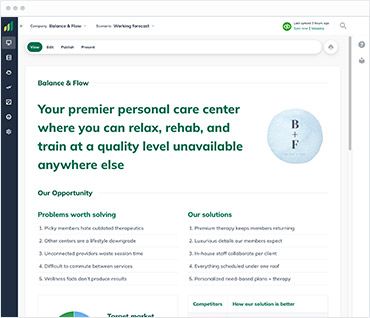
Teach by example
LivePlan's examples of actual business plans show students how they can identify opportunities, meet challenges, and plan their path to profits. Just like real-world entrepreneurs.
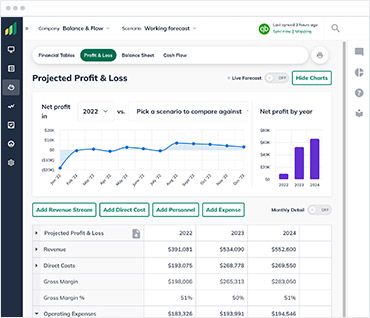
No spreadsheets necessary
With all–in–one spreadsheet–free forecasting and pitching tools–students can use LivePlan to build a realistic business plan with accurate projections and compelling pitches. Analyze scenarios. Track progress. Set goals. All in LivePlan.
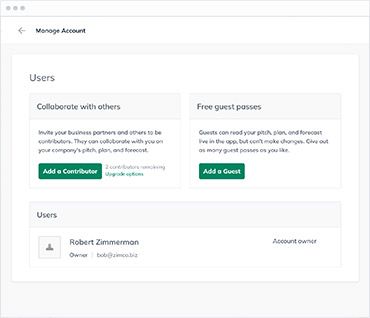
Works seamlessly with your classroom setup
With LivePlan you can simplify syllabus creation. LivePlan can also be used alongside classroom tools such as Blackboard and Canvas. LivePlan's optional instructional resources can enhance your syllabus with materials that introduce lean planning principles, growth metrics, financial forecasting, and more.
Instructors looking for a great tool to help students develop business plans need to look at Live Plan. The step–by–step process walks students through the entire process from Pitch to Financials. As the Instructor you can also have online access to their plan and provide feedback and comments as the plan develops.

Mike Allen Business Instructor, North Idaho College, Coeur d'Alene, ID
Bring out the best in every student
LivePlan's business plan examples help students turn ideas into top–notch business plans for class projects and startups. The tools, features, and instructional content allow you to focus on bringing out the best in your students for every plan and project.
Before using LivePlan, my students were intimidated by the business planning process. LivePlan breaks it down into manageable steps and takes the mystery out of developing a business plan.

Amy Schulz NACCE Vice President of Education, Membership and Associate Faculty, Feather River College, Quincy, CA
I used LivePlan to develop a business plan for a class project. Turns out, the project became part of a business plan competition where I placed second out of over 200 entries.

Sheila Austin Student
LivePlan provides your students with the tools to

Know the competition
No business operates in a vacuum. LivePlan incorporates real–world industry data, so students can better understand competitors, plan businesses around industry realities, and confidently execute data–driven strategies.

Build business dreams together
From sharing feedback and engaging in discussions, to simultaneously working on different parts of the plan, students can easily collaborate in groups using LivePlan.

Create a plan that fits their needs
Whether small or big, LivePlan can build out the right–sized business plan for your classroom projects. In LivePlan, students can develop a simple lean plan that focuses their ideas, or create a full business plan with all the details and steps necessary to persuade investors, attract partners, and turn their idea into a profitable reality.

With so much happening in the classroom, you need a tool that works with you, not one that makes you do extra work. Used by educators, consultants, entrepreneurs, and students all around the world, LivePlan has been regularly improved and streamlined so it's easy to use.

Develop confidence in their plan and themselves
It's one thing to plan a business. It's another thing to know how to talk about a business plan. Students can develop talking points and practice their pitch in LivePlan so they can discuss their enterprise with confidence and authority.
With LivePlan your students exceed expectations
With LivePlan, students create business plans that:
- Guide them from concept to actionable plan
- Build the confidence necessary to be entrepreneurs
- Combine pitching, forecasting, and collaboration
LivePlan streamlines projects for educators
LivePlan eases project management in the classroom, so instructors can:
- Pinpoint feedback and suggest improvements
- Monitor project progress
- Teach business planning instead of managing multiple apps
Go beyond business plan examples
LivePlan easily integrates into business courses, includes all materials and curriculum to support classroom business projects, and comes with free phone, email, and chat technical support.
The students very much appreciate the guidance the LivePlan program offers. I love the ability to act as a contributor to their plans. The help resources are phenomenal and easy to navigate.

John Shaw Assistant Professor of Management, Davis College of Business – Jacksonville University, Jacksonville, FL
See how LivePlan can upgrade your student's education
Fill out the form below and our LivePlan Partnership Team will be in touch shortly.
Get Your Free LivePlan Account Today
Thanks an educator advocate will be contacting you shortly to set up your free liveplan account..
If you'd like to talk to us before then, please call 1–888–498–6136 Phones are open M–F, 8am–5pm (Pacific time)
Teachers and students love LivePlan
LivePlan really facilitated communication between students who were in a team on the business plan project. Students could comment on sections of their business plan and collaborate on what to change in their plan without having to meet face–to–face.

Amy Valente Assistant Professor of Business, Cayuga Community College, Auburn, New York
LivePlan helped us easily set up the business plan for our startup during our MBA. As soon as the other students saw it, they also wanted LivePlan. The time we saved on planning we could use for operational tasks. It was the ideal solution for us.

The product we produced by using Live Plan was exceptional, far exceeded our expectations, and came out so much better than we could have ever done on our own.

This product is a game-changer. It allows the non–MBA founder to unleash their potential through strategic planning and beautiful design. Highly recommended.

Answers Neuroscience
LivePlan is simply awesome.

Amit Agrawal

- Entrepreneurship
- WordPress And Webdesign
- Sales Funnel
- Motivation And Affirmation
- Get in Touch
10 Business Plan Examples for Students (2024)
Written by Peter Keszegh
Starting a business isn’t just for the established entrepreneurs. If you’re a student with a great business idea, or if you’re just looking to earn extra money on the side, you can set up your own business with the right steps and preparation, too!
In this article, we’ll list some business plan examples for students and how you can turn your business ideas into reality.

What is a business plan?
In simple terms, a business plan is a detailed document that explains everything you need to know about your business idea. It includes your goals for your business and how exactly you plan to achieve them.
A business plan should be able to explain why your product or service is valuable, your target market for your business, and your future plans for the business.
Having a well-written business plan is important, especially if you’re looking at seeking external funding from investors. Even if you’re planning to use personal funds for your business, the business plan will help outline all your operational and management strategies.
Tailoring your plan to your business
While business plans have some standard sections used by all industries, it’s best to tailor your business plan depending on what your market is. For instance, if you’re planning to sell food products, you need to write sections on sourcing ingredients and quality control.
Think about what’s special about your business, and make sure to incorporate that in your business plan. Put yourselves in the shoes of an external investor – what would they want to know about your business? Don’t be afraid to think outside the box, too.

Parts of a business plan
You might be wondering – how should we structure a business plan? Here are some key sections you might want to include when writing your business plan:
Executive summary
An executive summary is exactly that – a summary of what your business is all about and your goals for the future. Make sure to include what your product or service plans to do, your target market, and key milestones you’d like to achieve. If you have plans to source external funding, mention this here, too.
Company description
You can use this section to expound on what you plan to achieve and what your business vision is . Use this section to highlight what makes your business unique , and why your product or service offers an innovative solution.
Market analysis
If you’re looking to start a business, you need to have a good understanding of the market and who your competitors are. Do the research to make sure there’s a real need for your product or service , and make sure you know what sets your business apart from competitors.
Organizational structure
If you’re working with a team and you all have different responsibilities, make sure to put that into writing. This doesn’t have to be too formal – all you have to do is make sure everyone’s tasks are clearly delineated so there’s no overstepping.
Product line or services offered
Talk about what you plan to sell or offer as a business. What exactly does your product or service do? What makes it so special, and what can your product or service do that isn’t already offered by your competitors?
Marketing and sales strategies
How do you plan to promote your business to attract customers and secure sales ? You can talk about where you plan to sell your products or offer your services, and how you plan to advertise your business.
Financial projections and funding requests
Set financial goals for your business and identify when your business will likely break even . If you need to secure external funding, make sure to mention this here, and mention how much money you’ll be needing and how you’ll be spending it.
Relevant documents that you mentioned earlier in your business plan should be included here. For instance, if you conducted market research via a survey, put your survey data here.
Of course, don’t be limited by the sections listed here. If there are other relevant details you’d like to talk about in your business plan, don’t be afraid to explore them. For instance, if you’re looking at using new technologies and tools for your product or service, you can write a relevant section in your business plan as well.

Why students need to master business plans
Businesses aren’t just for more seasoned entrepreneurs – starting a business can prove to be useful for students who want to hone their skills and become more business-minded.
Here’s how business plans can help students:
Enhancing strategic decision-making
You’ll have to make a lot of decisions when running a business, and business plans will force you to make smarter decisions. You don’t want to make things unnecessarily difficult for you and your team only to get mediocre results – you want to make sure you make the most out of your resources!
This kind of strategic decision-making isn’t something you learn in the classroom. Hands-on business experience will be useful for you to make wise decisions, even if it means learning from mistakes.
Improving market research and analysis skills
As students, you already do a lot of research for different school projects. When setting up a business, you’ll have to do research of your own to get a better understanding of the market your business plans to work in.
Having a good understanding of the market will also improve your analysis skills. For instance, doing enough research on the retail industry will give you a better idea of who the average retail customer is, allowing you to tweak your marketing and sales strategies to capture that target market.
Honing financial literacy and forecasting
Discussions about money and numbers can get pretty confusing. When you’re setting up a business and dealing with real, tangible figures, you’ll gain a better understanding of how finances work, how profitable your business might be, and what you’ll likely be spending money on.

Business plan examples for students
If you need a little help in thinking about the kind of business you want to set up, here are 10 business plan examples for students that you can use as inspiration:

Tu toring services
Some students will understand subjects better than others, which means there are a number of students who’ll need a little bit of help when it comes to their academic requirements and upcoming exams.
If you’re academically gifted and have a talent for teaching, you might want to consider offering tutoring services in your school.
- Executive summary : Mission, services offered, and target client demographic.
- Business description: Subjects covered, and technologies used (if applicable).
- Services provided: Individual tutoring, group workshops, and ongoing support options.
- Market analysis: Demographic trends, existing offerings, and unmet needs.
- Marketing strategy: Flyers, community center partnerships, and word-of-mouth referral programs .
- Operational plan: Scheduling system, session formats (in-person, online), and materials preparation.
- Management and organization: Tutor recruitment, training programs, and operational leadership.
- Financial summary: Basic costs, session pricing, financial goals, and sustainability plan.

Campus delivery service business
Especially during finals weeks, students can get pretty busy and can often forget to take care of themselves. How many all-nighters have you pulled as a student, and how many times have you skipped a meal to work on a deadline?
If this sounds like the kind of culture in your university, you might want to consider setting up a campus delivery service to cater to busy students. Here’s how you can set up your business plan:
- Executive summary: Service overview, mission, and objectives.
- Company description: Origins, campus focus, and service differentiation.
- Service offering: Types of delivery services offered (e.g., food, groceries).
- Market analysis: Campus demographics, needs assessment, and competitor analysis.
- Marketing strategy: Promotional tactics targeting students and staff, partnerships with local businesses.
- Operations plan: Delivery logistics, technology use (e.g., apps, GPS tracking), and hours of operation.
- Management and organization: Team roles, volunteer vs. paid staff, and management hierarchy.
- Financial plan: Start-up costs, pricing strategy, revenue projections, and break-even analysis.

Campus fitness and wellness programs
Another way you can help students in your school become healthier is to offer services that focus on fitness and wellness . If there’s a need for students in your school to become more physically active or to just take better care of their overall wellness, you could offer relevant programs on campus.
- Executive summary: Concept, target audience, and objectives of the fitness programs.
- Business description: Range of services (classes, personal training, wellness workshops).
- Market analysis: Campus health trends, competitor offerings, and student wellness needs.
- Services: Detailed look at program offerings, schedules, and customization options.
- Marketing plan: Engagement strategies, campus events, and partnership with student health services.
- Operational plan: Instructor qualifications, equipment needs, and location logistics.
- Management and organization: Structure of the team, roles, and experience in health and wellness.
- Financial overview: Initial setup costs, pricing strategy, revenue streams, and financial projections.

Student freelance platform
Freelancing is a popular way for students to earn extra income on the side, in the middle of their busy class schedules. If you have enough know-how when it comes to setting up websites or apps, you might want to consider launching a portal where student freelancers can conveniently find more freelance gigs.
- Executive summary: Platform purpose, target market, and value proposition.
- Business description: Niche focus (e.g., design, tutoring, programming), platform features.
- Market analysis: Demand for freelance work among students, analysis of existing platforms, gap identification.
- Service description: User interface, service categories, payment processing system.
- Marketing and sales strategy: Campus outreach, online presence, and user acquisition strategies.
- Technology plan: Website architecture, user security measures, and scalability.
- Operations plan: Customer support, dispute resolution process, and freelancer vetting process.
- Financial summary: Funding requirements, monetization strategy, and financial forecasts.

Mobile app for campus services and networking business
Maybe you’ve got an enormous campus that boasts a lot of helpful activities and services that most students might not already be aware of. If you want to promote these services in an innovative way, you could think about setting up a mobile app that students can use as a one-stop-shop for all their campus service needs.
- Executive summary: Introduction to the app, its core functionalities, and target user base.
- Business description: Insight into how the app facilitates campus life, services offered, and networking features.
- Market analysis: Current apps in the market, student needs analysis, and potential for growth.
- Product description: Detailed functionalities, user interface design, and privacy features.
- Marketing plan: Strategies for app launch, user acquisition, and partnerships with university departments.
- Technology plan: Development roadmap, platform compatibility, and maintenance plan.
- Management and operations: Team structure, developer roles, and operational milestones.
- Financial projections: Budget for app development, marketing costs, monetization strategies, and revenue forecasts.

Eco-friendly apparel brand
Everyone’s becoming more eco-conscious nowadays, and brands who often highlight their environmentally-friendly practices do get a good reputation. If you want to tap into that market and mix it with a bit of fashion design, you can choose to set up an eco-friendly apparel business.
- Executive summary: Brand mission, product range, and sustainability goals.
- Company background: Inspiration behind the brand, target demographic, and brand story.
- Products and services: Description of apparel line, materials used, and production process.
- Market analysis: Trends in sustainable fashion, target market behavior, and competitive landscape.
- Marketing strategy: Branding, social media campaigns, and collaborations with eco-conscious influencers.
- Operational plan: Supply chain management, ethical sourcing, and online versus physical sales approach.
- Management team: Roles, responsibilities, and background of team members.
- Financial plan: Initial investment, cost structure, sales forecast, and profitability analysis.

Sustainable campus living products
Maybe you’re not too keen on selling apparel, but you’d still like to tap into the market of students who prioritize sustainable brands and products.
If you also share the same passion for sustainability and have ideas on how to cater to students’ needs, you might want to consider selling sustainable products instead that dormers and other students will find useful for everyday life.
- Executive summary: Mission statement, product line overview, and sustainability goals.
- Company overview: Background on the inspiration for eco-friendly products targeted at students.
- Market analysis: Trends in sustainability, potential campus markets, and niche opportunities.
- Products offered: Description of eco-friendly living products (reusable containers, biodegradable goods).
- Marketing and sales strategy: Campus-based initiatives, eco-friendly partnerships, and social media.
- Operations: Sourcing of materials, product manufacturing, and logistics.
- Management team: Founder’s background, operational management, and advisory board.
- Financial projections: Cost analysis, sales forecast, funding requirements, and profitability timeline.

Student event planning service
A big part of student life is all about events and getting to meet new people. Not only is event planning a big thing for official student organizations, it’s also helpful for smaller communities who want to organize events to meet like-minded people.
If events are a popular thing in your school, you might benefit from setting up a student event planning service.
- Executive summary: Overview of services, unique selling points, and business goals.
- Company description: Types of events covered (e.g., academic, social, sporting).
- Service offering: Full event planning, day-of coordination, and consultation services.
- Market analysis: Campus event culture, demand for event planning services, competitor overview.
- Marketing plan: Outreach strategies, partnerships with campus organizations, and promotional materials.
- Operational strategy: Event logistics, vendor relationships, and event execution checklist.
- Management structure: Leadership team, volunteer opportunities, and staffing needs.
- Financial projections: Pricing model, expected expenses, revenue estimates, and growth potential.

Campus event photography service
Every big event needs good documentation to go with it. Even if your school isn’t big on events, you can choose to offer photography services to groups of friends who want cute little photoshoots in the most Instagrammable parts of your campus.
If you have a knack for photography, here’s how you can start offering photography services on campus:
- Executive summary: Concept and goals for providing photography services for campus events and personal photoshoots.
- Company description: Insights into the types of events covered (e.g., graduations, parties, portraits).
- Services offered: Packages available, including event coverage, individual portraits, and group sessions.
- Market analysis: Demand for photography services on campus, existing offerings, and unique selling points.
- Marketing strategy: Portfolio development, social media presence, partnerships with event organizers.
- Operational plan: Booking process, event execution, post-processing, and delivery of images.
- Management team: Background of the photographer(s), roles in business management, marketing, and customer service.
- Financial plan: Pricing strategy, cost of equipment and travel, revenue projections, and growth potential.

Student art gallery and workshop space
Maybe you’re from an art school, or your campus boasts a rich and talented artistic community. If your school’s artists are looking for a space to display their art, setting up a gallery and workshop space might be a profitable and sustainable business opportunity.
- Executive summary: Vision, goals, and unique aspects of the art gallery and workshop space.
- Company overview: Concept behind promoting student art, workshop themes, and community benefits.
- Market analysis: Interest in local art, campus cultural activities, and potential for art sales.
- Services and products: Exhibition schedules, workshop offerings, and art sales.
- Marketing strategy: Promotions through campus channels, local art scenes, and social media.
- Operations: Gallery setup, workshop logistics, and artist collaboration processes.
- Management team: Backgrounds in art management, curation, and education.
- Financials: Start-up expenses, pricing for art and workshops, expected revenue, and growth potential.

Common mistakes to avoid for student businesses
Setting up a business is no walk in the park, especially for young and inexperienced students. Here are some common mistakes that you can avoid when planning your own business, so you can steer clear of bigger problems down the road:
Lack of a well-defined business plan
It should go without saying that insufficient planning will make it difficult to get your business off the ground. Make sure you put down all important details in writing , and consult experts and get insights from successful small businesses if you need to.
Underestimating the importance of market research
You’ll need more than just a cool idea to start a business. There needs to be a real need or demand for your product or service, and if there’s another business already offering the same thing, you need to make sure your product or service is different or unique.
Familiarize yourself with the existing market and what the market gaps are. Once you identify what that market needs, you can tailor your business plans to try to fill in that gap.
Overlooking legal and financial regulations
Being a student doesn’t exempt you from following standard business regulations. Double check with experts and do extra research to make sure your business complies with all necessary regulations. For instance, you may need to officially register your business, or secure necessary permits.
Inadequate financial planning and management
Your business needs to be on financially stable ground for it to stay sustainable. Make sure you know if you’re in good financial standing to launch your business , and make sure you aren’t spending more than what you can actually afford.
Ignoring the importance of a strong team
It’s tempting to do everything yourself, especially if you lack funds or the ability to delegate tasks. However, you might benefit from having a team of members with various skills. A strong team will bring in more ideas to the table , and will be helpful in managing heavy workloads.
Overlooking customer feedback
You need to listen to what your customers are saying to adapt to their needs and wants. Are your products too expensive? Are people looking for different colors of your products? Engage with your customers so they can let you know how you can improve your business.
Neglecting online marketing
Social media is everything in today’s digital age! You’ll be able to reach a wider audience if you set up social media accounts on different platforms to advertise your services or products.

Future steps for student business owners
So you’ve made your business plan – congratulations! But where do you go from here?
If you want to know whether or not your business is taking off and what future opportunities you can secure, here are some ideas:
Evaluating business performance
Regularly review how well your business is performing by checking product sales, total profits, and how wide your customer base is. If you’ve been earning a good amount of money and are selling popular products or services, that’s a great sign!
Make sure to listen to customer feedback , too, as your customers might give you helpful insights that you might not immediately be aware of. You can do this via informal chats with your customers, or via more formal means like customer surveys.
Exploring growth strategies
Once you’ve evaluated how well your business is performing, you might want to consider growing your business if there’s a demand for a product or service you aren’t already offering, or if there’s an adjacent market you can tap into.
For instance, if you’re offering tutoring services for basic algebra classes, you might want to offer sessions for more complicated math subjects if your tutees need them. If you’ve set up an art space that can also be used as a venue for student events, you can consider expanding your offerings.
Scaling the business
Maybe your business has really taken off and has hit a point that you can no longer meet the customer demand with your tiny team. If that’s the case, you might want to consider scaling.
You can scale your business by adding more people to your team , or ramping up your production efforts.
Building a brand
Don’t be afraid to make a name for yourself! Explore how you can create a brand for your business. This is where you can let your creative juices flow – do you want to appear like a sophisticated and professional brand, or are you going for a more quirky approach?

Takeaways for business plan examples for students
The opportunities are endless if you want to set up a business as a student. Let your imagination run wild and look through business plan examples for students if you want to start selling or offering something new to your school’s community.
Don’t be intimidated by your lack of expertise or resources just yet – with the right mindset and enough determination, you’ll be able to set up your business for success and start your journey as a solid business owner!
Read More Articles:
Why Hire Marketing Consultants for Small Business? Pros and Cons
5 Principles of Motivational Interviewing for Successful Hires
20+ SAMPLE College Business Plan in PDF | MS Word
College business plan | ms word, 20+ sample college business plan, what is a college business plan, what are the benefits gained from a college business plan, how to create a college business plan, where do public universities get their funding, what are some of the main types of universities, what are vocational or technical colleges.
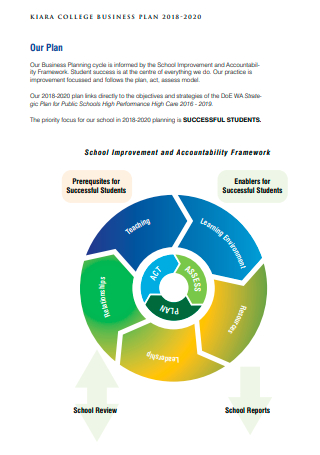
College Business Plan Template
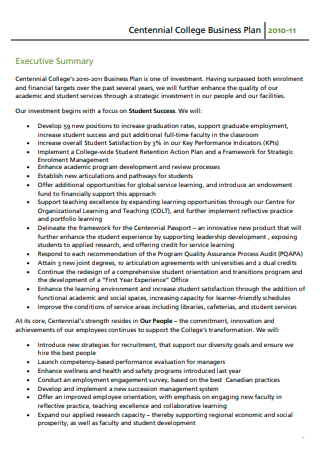
College Business Plan Example
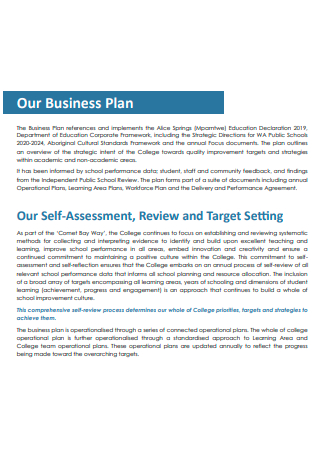
Basic Business Plan

College Business Plan in PDF
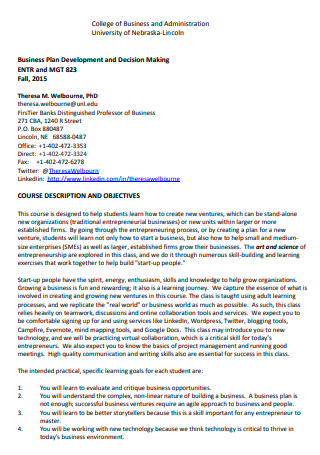
College of Business and Administration Plan

City College Business Plan
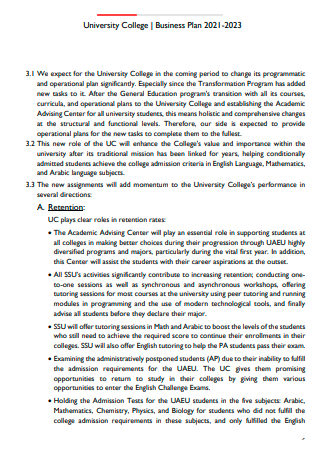
University College Business Plan
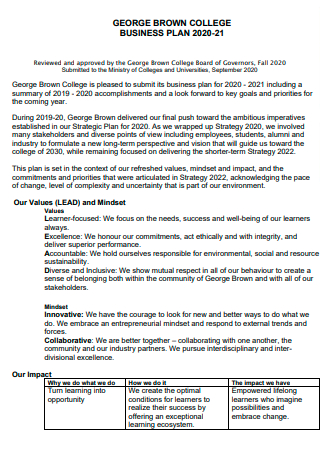
Standard College Business Plan

College Preparatory Schools Business Plan

Secondary College Business Plan
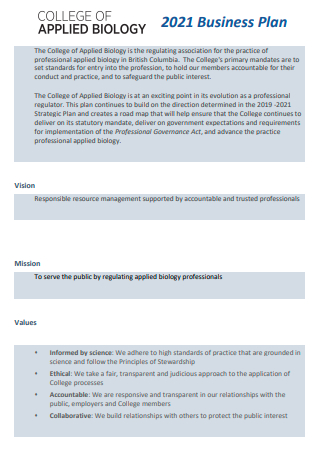
College of Applied Biology Business Plan
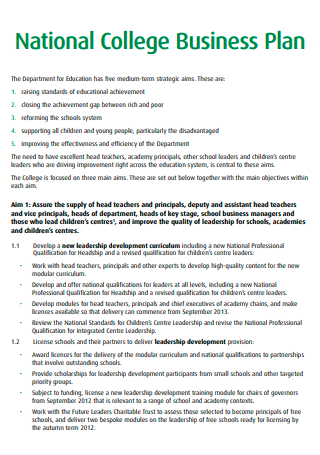
National College Business Plan
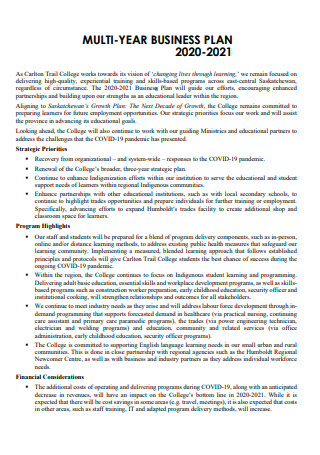
College Multi Year Business Plan

Printable College Business Plan
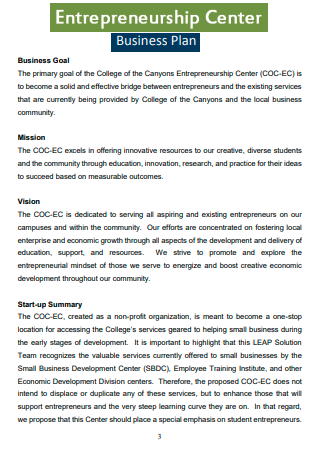
College of Entrepreneurship Center Business Plan
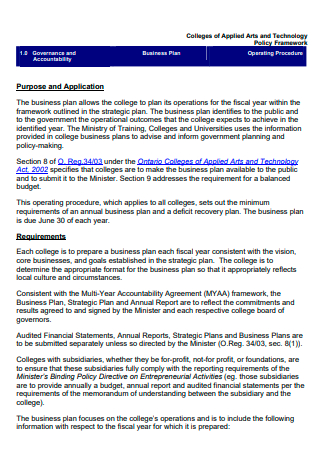
College of Applied Arts and Technology Business Plan
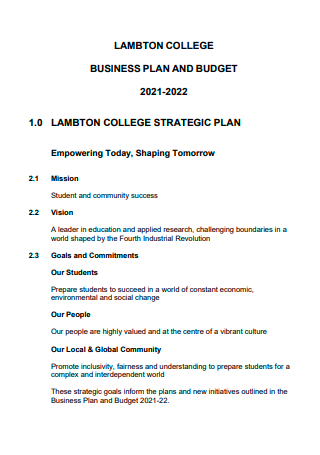
College Business Plan and Budget
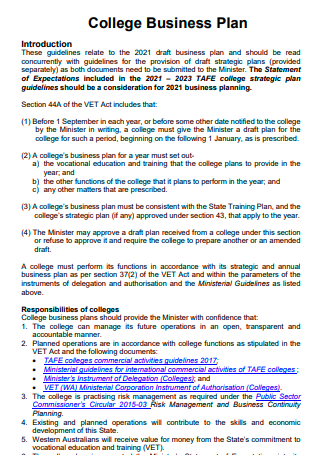
Draft College Business Plan

College of Medicine Business Plan
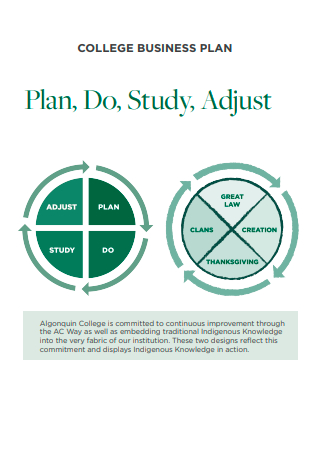
Sample College Business Plan

College Business Plan in DOC
1. executive summary, 2. college features and offerings, 3. marketing analysis, 4. marketing strategy, share this post on your network, you may also like these articles.

In this comprehensive guide, we explore the essentials of creating an effective Floor Plan. Whether you are designing a new home, renovating an existing space, or planning an office…
Nursing Care Plan

In this comprehensive guide, we explore the essentials of creating an effective Nursing Care Plan. Whether you are a nursing student, a new graduate, or an experienced nurse, this…
browse by categories
- Questionnaire
- Description
- Reconciliation
- Certificate
- Spreadsheet
Information
- privacy policy
- Terms & Conditions
Business Plan Template for University Students
- Great for beginners
- Ready-to-use, fully customizable Subcategory
- Get started in seconds

As a university student with big dreams of starting your own business, having a solid business plan is crucial to turning those dreams into reality. That's where ClickUp's Business Plan Template for University Students comes in handy!
With this template, you can:
- Outline and develop your business idea, strategy, and financial projections
- Create a comprehensive roadmap for your venture, ensuring you stay on track and meet your goals
- Collaborate with teammates and mentors to refine your plan and get valuable feedback
Whether you're majoring in business or simply have an entrepreneurial spirit, this template will help you take your ideas to the next level. Start planning your path to success today!
Business Plan Template for University Students Benefits
A business plan template for university students offers a range of benefits for aspiring entrepreneurs and business-minded students. Some of the key advantages include:
- Structured approach: Provides a clear and organized framework to develop a business idea from concept to execution.
- Strategic planning: Helps students define their goals, objectives, and strategies for their business venture.
- Financial projections: Allows students to create realistic financial forecasts and projections, ensuring they have a solid understanding of the financial aspects of their business.
- Investor readiness: Prepares students to present their business ideas confidently to potential investors or lenders.
- Risk assessment: Prompts students to identify and analyze potential risks associated with their business, enabling them to develop contingency plans.
- Professional documentation: Creates a professional and polished business plan that can be used to showcase their ideas to mentors, professors, and potential partners.
- Entrepreneurial mindset: Encourages students to think critically, problem-solve, and develop a mindset of innovation and entrepreneurship.
Main Elements of University Students Business Plan Template
ClickUp's Business Plan Template for University Students is the perfect tool to help aspiring entrepreneurs and business students outline and develop their ideas into a comprehensive business plan. Here are the main elements of this template:
- Custom Statuses: Track the progress of each section of your business plan with statuses like Complete, In Progress, Needs Revision, and To Do.
- Custom Fields: Include important details in your business plan using custom fields such as Reference, Approved, and Section to ensure all necessary information is captured.
- Custom Views: Access different perspectives of your business plan with five different views, including Topics, Status, Timeline, Business Plan, and Getting Started Guide, allowing you to easily navigate and visualize your plan.
With ClickUp's Business Plan Template, university students can efficiently organize and collaborate on their business ideas to create a solid roadmap for their ventures.
How To Use Business Plan Template for University Students
If you're a university student looking to start your own business venture, using the Business Plan Template in ClickUp can help you get started. Follow these four steps to create a comprehensive business plan:
1. Define your business concept
Begin by clearly defining your business concept. What products or services will you offer? Who is your target audience? What problem does your business solve? This step is crucial for setting the foundation of your business plan.
Use a Doc in ClickUp to outline your business concept and brainstorm ideas for your target audience and unique selling proposition.
2. Conduct market research
To ensure the success of your business, it's important to gather information about your target market, competitors, and industry trends. Conduct thorough market research to gain insights into customer needs, market demand, pricing strategies, and potential challenges you may face.
Create tasks in ClickUp to organize your market research activities, such as analyzing industry reports, conducting surveys, and studying competitor analysis.
3. Develop a marketing strategy
A strong marketing strategy is essential for reaching your target audience and attracting customers. Outline your marketing tactics, such as social media campaigns, content marketing strategies, and advertising plans. Consider how you will position your brand and communicate your unique value proposition.
Use the Board view in ClickUp to create a visual representation of your marketing strategy, with columns for different marketing channels and tasks for each tactic.
4. Financial planning and projections
The financial aspect of your business plan is crucial for demonstrating the viability and profitability of your venture. Create a detailed financial plan that includes projected revenue, expenses, and cash flow. Consider factors such as startup costs, pricing strategies, and sales forecasts.
Utilize custom fields in ClickUp to track and calculate financial data, such as revenue projections and expense breakdowns.
By following these four steps and utilizing the Business Plan Template in ClickUp, you can create a comprehensive plan that lays the groundwork for your university student business venture. Good luck!
Get Started with ClickUp’s Business Plan Template for University Students
University students who are aspiring entrepreneurs or are involved in business-related programs can use the Business Plan Template for University Students in ClickUp to create a comprehensive roadmap for their venture.
First, hit “Add Template” to sign up for ClickUp and add the template to your Workspace. Make sure you designate which Space or location in your Workspace you’d like this template applied.
Next, invite relevant members or guests to your Workspace to start collaborating.
Now you can take advantage of the full potential of this template to develop your business plan:
- Use the Topics View to organize your business plan into different sections such as Executive Summary, Market Analysis, Marketing Strategy, Financial Projections, etc.
- The Status View will help you track the progress of each section, categorizing them as Complete, In Progress, Needs Revision, or To Do.
- The Timeline View will allow you to set deadlines and milestones for each section, ensuring you stay on track.
- Use the Business Plan View to get a comprehensive overview of your entire plan, including all sections and their statuses.
- The Getting Started Guide View will provide you with step-by-step instructions and tips on how to use the template effectively.
- Customize the template by adding custom fields like Reference, Approved, and Section to provide additional information and track important details.
- Update statuses and custom fields as you work on each section to keep track of progress and ensure all necessary information is included.
- Business Plan Template for Dental Clinic
- Business Plan Template for Community Leaders
- Business Plan Template for Culinary Professionals
- Business Plan Template for Janitorial Staff
- Business Plan Template for Home Decorators
Template details
Free forever with 100mb storage.
Free training & 24-hours support
Serious about security & privacy
Highest levels of uptime the last 12 months
- Product Roadmap
- Affiliate & Referrals
- On-Demand Demo
- Integrations
- Consultants
- Gantt Chart
- Native Time Tracking
- Automations
- Kanban Board
- vs Airtable
- vs Basecamp
- vs MS Project
- vs Smartsheet
- Software Team Hub
- PM Software Guide
- Business Tips
- Small Business
- Sign in / Join

Extend Your Pool Season with a Boiler: Sunshine All Year Round

5 Essential Components of a Successful Event Company: Bouncy Castles with…

Boost Sales and Conversions: The Role of 3D Shed Configurators for…

The Essential Role of a Commercial Lawyer in Business Transactions

Harnessing the Power of Specialized Training: How Post-Secondary Programs Prepare the…

Rolled Up Holiday Pay vs. Traditional Holiday Pay: What You Need…

Are You Ready to Transform Your Career Path? Discover How Freelancing…

Employee Rights: Key Legal Protections Every Worker Should Be Aware Of

7 Ways to Appreciate and Motivate Your Employees

Inclusive Management Training: A Guide for Empowering Your Workforce

What Documents Are Needed for Estate Planning: A Complete Guide

Gold Price Forecasts: Should You Invest in Gold Before the End…

When & Why Your Business Should Consider a Fractional CFO

The Role of Medical Malpractice Insurers in Protecting Healthcare Providers and…

Crafting Your Brand’s Blueprint: A Comprehensive Guide to Brand Strategy

How to Go Along with Step and Repeat Banner for Your…

Harnessing the Power of Niche Markets Through Media

10 Proven Marketing Strategies for Small Businesses

How Relationship Mapping Tools Help Streamline Sales Cycle

How to Organize Travel Management for Small Businesses: Efficient Strategies and…

The Green Imperative: A Comprehensive Guide to Eco-Friendly Packaging Options

Navigating the Growth Spurt: A Guide to Managing Rapid Employee Expansion…

Unlocking the Power of Cybersecurity Outsourcing for Small Businesses

Line of Credit or Loan for Your Small Business?

The Future of Farming: Embracing Modern Agricultural Innovations

Exploring Open DAO: A Comprehensive Overview

Avoiding Costly Errors: How Payroll Software Enhances Accuracy

How Can Technology Streamline Your Business Processes and Maximize Profits?

Ways To Use Technology To Boost Your Business
How to write a simple business plan for students.

A business plan always has the same structure. Of course, if you plan to sell coffee, not to produce it, you will skip the “production” part, but other than that – you can’t skip anything.
Writing a business plan as a student , as a part of your college or university project, the best thing you can do is just to go into too many details. You have to save the structure, but you can describe your competitors in one abstract, not in five pages, with numbers and poll data.
Basic Business Plan Structure
Mostly, students are asked to make a marketing analysis and marketing plan more professionally than other parts, so we give more details about them.
Description of your business
Here is a brief overview of the experience of the entrepreneur, the date of creation of the company, the field of business, goals, and objectives of the work, available base, and resources.
Market analysis
List of competitors and their offers, estimation of demand, options of promotion and sale.
- Evaluation of the market. It is necessary to estimate the capacity of the market, the population, the number of potential customers. It is difficult to do this without complete marketing research. Therefore, you should look for the results of this assessment for your region. As a last resort, you can predict the estimated demand.
- Competitors. Make a list of your competitors who are already working in this market. Not only direct competitors that offer similar products and services but also those companies that produce alternative services should be considered. If you do not have a specialized tea boutique in your city, this does not mean that the market is free from competitors: you have to fight for customers with those department stores and supermarkets that also sell different types of tea.
Production plan
List of products (services provided) and their volumes, technological processes, necessary equipment and materials, cost calculation.
- Business processes. Write down the list of equipment, tools, raw materials, and materials needed to create your chosen range of products and services. Calculate the optimum production volumes your equipment can handle. Specify which employees and what kind of downloads you will need.
- Products. List the products, services, and work that you will offer your customers. Costs for the organization of business processes will allow you to find out the cost and to make a price list.
- Start-up investment. Calculate how much money it will take to start a project. Sum up the cost of all assets, fixed assets, repairs, materials, and other expenses that will be required to start production.
Organizational plan
List of necessary staff, organization of work, distribution of functions and tasks in the team, involvement of third-party organizations and specialists, personnel costs — calendar of activities for launching the project.
Marketing plan
Advertising channels and costs, ways to promote a company and its products (services), estimated marketing impact – sales volume, number of customers, and transactions.
- Promotion channels. Newspaper ads, radio and TV commercials, online advertising, creating your own site and group on social networks, advertising in local publics and forums, participating in trade shows .
- Target audience. Who to focus on when organizing sales. Who your client is by age, gender, occupation, income level. Where to find them and how to reach.
- Promotion cost. How much will it cost to find and engage? How often you will have to run ads, what are the appropriate options to choose?
Financial indicators
This is where the financial side of your business is reflected, namely: future costs (product purchases, rentals, hiring, etc.), revenue, net profit, profitability, and return on the project.
Risk assessment
A list of major issues that a company may face, their potential consequences, and a plan of measures to minimize them.
Project summary
The most important part is a compact presentation of the contents of the entire document on several pages, it is important here to place the accents correctly, taking into account the addressee and the purpose of preparing the business plan.
Even though it is only a business plan for students, not the one you would present to a real investor, try to make it look realistic.
RELATED ARTICLES MORE FROM AUTHOR

Ensuring Compliance: How Online Payroll Software Can Simplify Regulatory Requirements

Choosing the Right Moving Company: What to Look For

Cost-Effective Ways to Maintain and Extend Pavement Life
Leave a reply cancel reply, most popular.

3 Ways To Beat Distractions and Stay Focused At Work

Is Large Estate Planning the Same As Will?

The Difference Between Card Present and Card Not Present Transactions

Best Craft Business Names & Ideas That Are Most Profitable

The Art of the Open Letter – How to Write an Open Letter

How to Go Along with Step and Repeat Banner for Your...


School Business Plan Template
Written by Dave Lavinsky

School Business Plan
Over the past 20+ years, we have helped over 500 entrepreneurs and business owners create business plans to start and grow their schools.
If you’re unfamiliar with creating a school business plan, you may think creating one will be a time-consuming and frustrating process. For most entrepreneurs it is, but for you, it won’t be since we’re here to help. We have the experience, resources, and knowledge to help you create a great business plan.
In this article, you will learn some background information on why business planning is important. Then, you will learn how to write a school business plan step-by-step so you can create your plan today.
Download our Ultimate Business Plan Template here >
What is a School Business Plan?
A business plan provides a snapshot of your school as it stands today, and lays out your growth plan for the next five years. It explains your business goals and your strategies for reaching them. It also includes market research to support your plans.
Why You Need a Business Plan for a School
If you’re looking to start a school or grow your existing school, you need a business plan. A business plan will help you raise funding, if needed, and plan out the growth of your school to improve your chances of success. Your school business plan is a living document that should be updated annually as your company grows and changes.
Sources of Funding for Schools
With regards to funding, the main sources of funding for schools are donations and gifts, tuition, personal savings, credit cards, bank loans, and angel investors. When it comes to bank loans, banks will want to review your business plan and gain confidence that you will be able to repay your loan and interest. To acquire this confidence, the loan officer will not only want to ensure that your financials are reasonable, but they will also want to see a professional plan. Such a plan will give them the confidence that you can successfully and professionally operate a business. Personal savings and bank loans are the most common funding paths for schools.
Finish Your Business Plan Today!
How to write a business plan for a school.
If you want to start a school or expand your current one, you need a business plan. The guide below details the necessary information for how to write each essential component of your school business plan.
Executive Summary
Your executive summary provides an introduction to your business plan, but it is normally the last section you write because it provides a summary of each key section of your plan.
The goal of your executive summary is to quickly engage the reader. Explain to them the kind of school you are running and the status. For example, are you a startup, do you have a school that you would like to grow, or are you operating a chain of schools?
Next, provide an overview of each of the subsequent sections of your plan.
- Give a brief overview of the school industry.
- Discuss the type of school you are operating.
- Detail your direct competitors. Give an overview of your target customers.
- Provide a snapshot of your marketing strategy. Identify the key members of your team.
- Offer an overview of your financial plan.
Company Overview
In your company overview, you will detail the type of school you are operating.
For example, you might specialize in one of the following types of schools:
- Private K-12 school : this type of school typically charges tuition, and may be affiliated with a religious organization, or specialize in a particular learning method.
- Charter school: this type of school offers primary or secondary education for a tuition, and may receive some public funding, and/or donations. These schools require their students to take state-mandated exams.
- Special subject school: this type of school specializes in teaching a specific subject, such as driving, first-aid, self-defense, fine arts, language, or general tutoring.
- Preschool: this type of school typically serves children who are aged 3 and 4. These schools prepare young children to enter formal education, and are funded by some combination of tuition, donations, and government grants.
In addition to explaining the type of school you will operate, the company overview needs to provide background on the business.
Include answers to questions such as:
- When and why did you start the business?
- What milestones have you achieved to date? Milestones could include the number of students served, the number of students accepted into elite formal education institutions, etc.
- Your legal business Are you incorporated as an S-Corp? An LLC? A sole proprietorship? Explain your legal structure here.
Industry Analysis
In your industry or market analysis, you need to provide an overview of the school industry.
While this may seem unnecessary, it serves multiple purposes.
First, researching the school industry educates you. It helps you understand the market in which you are operating.
Secondly, market research can improve your marketing strategy, particularly if your analysis identifies market trends.
The third reason is to prove to readers that you are an expert in your industry. By conducting the research and presenting it in your plan, you achieve just that.
The following questions should be answered in the industry analysis section of your school business plan:
- How big is the school industry (in dollars)?
- Is the market declining or increasing?
- Who are the key competitors in the market?
- Who are the key suppliers in the market?
- What trends are affecting the industry?
- What is the industry’s growth forecast over the next 5 – 10 years?
- What is the relevant market size? That is, how big is the potential target market for your school? You can extrapolate such a figure by assessing the size of the market in the entire country and then applying that figure to your local population.
Customer Analysis
The customer analysis section of your school business plan must detail the customers you serve and/or expect to serve.
The following are examples of customer segments: families with elementary-aged children, families with high-school-aged children, families with preschool children.
As you can imagine, the customer segment(s) you choose will have a great impact on the type of school you operate. Clearly, families with high schoolers would respond to different marketing promotions than families with preschoolers, for example.
Try to break out your target customers in terms of their demographic and psychographic profiles. With regards to demographics, including a discussion of the ages, genders, locations, and income levels of the potential customers you seek to serve.
Psychographic profiles explain the wants and needs of your target customers. The more you can recognize and define these needs, the better you will do in attracting and retaining your customers.
Finish Your School Business Plan in 1 Day!
Don’t you wish there was a faster, easier way to finish your business plan?
With Growthink’s Ultimate Business Plan Template you can finish your plan in just 8 hours or less!
Competitive Analysis
Your competitive analysis should identify the indirect and direct competitors your business faces and then focus on the latter.
Direct competitors are other schools.
Indirect competitors are other options that customers have to purchase from that aren’t directly competing with your product or service. This includes public schools, virtual schools, and families who do homeschooling. You need to mention such competition as well.
For each such competitor, provide an overview of their business and document their strengths and weaknesses. Unless you once worked at your competitors’ businesses, it will be impossible to know everything about them. But you should be able to find out key things about them such as
- What types of students do they serve?
- What type of school are they?
- What is their pricing (premium, low, etc.)?
- What are they good at?
- What are their weaknesses?
With regards to the last two questions, think about your answers from the customers’ perspective. And don’t be afraid to ask your competitors’ customers what they like most and least about them.
The final part of your competitive analysis section is to document your areas of competitive advantage. For example:
- Will you provide specialized instruction, either in subject or in method?
- Will you offer courses or services that your competition doesn’t?
- Will you provide better customer service?
- Will you offer better pricing?
Think about ways you will outperform your competition and document them in this section of your plan.
Marketing Plan
Traditionally, a marketing plan includes the four P’s: Product, Price, Place, and Promotion. For a school business plan, your marketing strategy should include the following:
Product : In the product section, you should reiterate the type of school that you documented in your company overview. Then, detail the specific products or services you will be offering. For example, will you provide religious-focused K-8 education, college preparatory courses, or single-subject instruction like driving or fine arts?
Price : Document the prices you will offer and how they compare to your competitors. Essentially in the product and price sub-sections of your plan, you are presenting the courses and/or extracurricular activities you offer and their prices.
Place : Place refers to the site of your school. Document where your company is situated and mention how the site will impact your success. For example, is your school located in a growing neighborhood, in the city center, or will you operate purely online? Discuss how your site might be the ideal location for your customers.
Promotions : The final part of your school marketing plan is where you will document how you will drive potential customers to your location(s). The following are some promotional methods you might consider:
- Advertise in local papers, radio stations and/or magazines
- Reach out to websites
- Distribute flyers
- Engage in email marketing
- Advertise on social media platforms
- Improve the SEO (search engine optimization) on your website for targeted keywords
Operations Plan
While the earlier sections of your business plan explained your goals, your operations plan describes how you will meet them. Your operations plan should have two distinct sections as follows.
Everyday short-term processes include all of the tasks involved in running your school, including answering calls, planning and delivering instruction, applying for grants, fundraising, performing administrative tasks, overseeing instructors, handling discipline, scheduling and monitoring extracurricular activities, etc.
Long-term goals are the milestones you hope to achieve. These could include the dates when you expect to enroll your Xth student, or when you hope to reach $X in revenue. It could also be when you expect to expand your school to a new city.
Management Team
To demonstrate your school’s potential to succeed, a strong management team is essential. Highlight your key players’ backgrounds, emphasizing those skills and experiences that prove their ability to grow a company.
Ideally, you and/or your team members have direct experience in managing schools. If so, highlight this experience and expertise. But also highlight any experience that you think will help your business succeed.
If your team is lacking, consider assembling an advisory board. An advisory board would include 2 to 8 individuals who would act as mentors to your business. They would help answer questions and provide strategic guidance. If needed, look for advisory board members with experience in running a school or experience with public school administration or who has served on a public school board.
Financial Plan
Your financial plan should include your 5-year financial statement broken out both monthly or quarterly for the first year and then annually. Your financial statements include your income statement, balance sheet, and cash flow statements.
Income Statement
An income statement is more commonly called a Profit and Loss statement or P&L. It shows your revenue and then subtracts your costs to show whether you turned a profit or not.
In developing your income statement, you need to devise assumptions. For example, will you enroll 100 or 1,000 students per semester, and/or offer extracurricular activities? And will sales grow by 2% or 10% per year? As you can imagine, your choice of assumptions will greatly impact the financial forecasts for your business. As much as possible, conduct research to try to root your assumptions in reality.
Balance Sheets
Balance sheets show your assets and liabilities. While balance sheets can include much information, try to simplify them to the key items you need to know about. For instance, if you spend $50,000 on building out your school, this will not give you immediate profits. Rather it is an asset that will hopefully help you generate profits for years to come. Likewise, if a lender writes you a check for $50,000, you don’t need to pay it back immediately. Rather, that is a liability you will pay back over time.
Cash Flow Statement
Your cash flow statement will help determine how much money you need to start or grow your business, and ensure you never run out of money. What most entrepreneurs and business owners don’t realize is that you can turn a profit but run out of money and go bankrupt.
When creating your Income Statement and Balance Sheets be sure to include several of the key costs needed in starting or growing a school:
- Cost of equipment and supplies
- Payroll or salaries paid to staff
- Business insurance
- Other start-up expenses (if you’re a new business) like legal expenses, permits, computer software, and equipment
Attach your full financial projections in the appendix of your plan along with any supporting documents that make your plan more compelling. For example, you might include your school location lease or a list of elective courses or extracurricular activities you will offer.
Writing a business plan for your school is a worthwhile endeavor. If you follow the template above, by the time you are done, you will truly be an expert. You will understand the school industry, your competition, and your customers. You will develop a marketing strategy and will understand what it takes to launch and grow a successful school.
School Business Plan FAQs
What is the easiest way to complete my school business plan.
Growthink's Ultimate Business Plan Template allows you to quickly and easily write your school business plan.
How Do You Start a School?
Starting a school is easy with these 14 steps:
- Choose the Name for Your School
- Create Your School Business Plan
- Choose the Legal Structure for Your School
- Secure Startup Funding for Your School (If Needed)
- Secure a Location for Your Business
- Register Your School with the IRS
- Open a Business Bank Account
- Get a Business Credit Card
- Get the Required Business Licenses and Permits
- Get Business Insurance for Your School
- Buy or Lease the Right School Equipment
- Develop Your School Business Marketing Materials
- Purchase and Setup the Software Needed to Run Your School
- Open for Business
Learn more about how to start your own school .
Don’t you wish there was a faster, easier way to finish your School business plan?
OR, Let Us Develop Your Plan For You
Since 1999, Growthink has developed business plans for thousands of companies who have gone on to achieve tremendous success. Click here to learn about Growthink’s business plan writing services .
Other Helpful Business Plan Articles & Templates

- UConn Library
- Topic: Entrepreneurship & Business Plan Guide
- Business Plan (How to & Samples)
Topic: Entrepreneurship & Business Plan Guide — Business Plan (How to & Samples)
- Idea Generation
- Industry Information
- Competitors
- Market Research
- Financial Data
- Advertising & Promotion
- Small Business Advisors
- Products, R&D, Strategy
- Patents and Trademarks
- Grants, Loans, and Financing
- Franchises & Franchising
- Celebrating Connecticut
What is a Business Plan?
A business plan is "a guide—a roadmap for your business that outlines goals and details how you plan to achieve those goals."--Tim Berry from Bplans site.
- An Introduction to Business Plans Introduction to a tutorial on business plans written by the staff at Entrepreneur magazine.
- Business Planning Guide Step-by-Step guide to write a Business Plan by Bplans site.
- Create Your Business Plan, from the U.S. Small Business Administration (SBA) The SBA has delivered millions of loans, loan guarantees, contracts, counseling sessions and other forms of assistance to small businesses.
What is included in a Business Plan?
The following components make up a business plan:
Table of Contents
Executive Summary : Appears first, written last. Provides a snapshot of your company explaining who you are, what you do, and why.
Mission & Vision: Here you define the purpose of your business (Mission) and a statement about your perception of the company's growth and potential (Vision). Include specific goals and objectives of the business
Business Description: Provide background information about the company including brief history of the business and list of key company principals.
Define Your Market: Describe the industry within which your business will operate, identify your target market, provide a general profile of your targeted clients, and describe what share of the market your currently have and/or anticipate. For this section of the business plan, your will undertake following types of research:
Industry Analysis : how is the industry structured, trends and statistics, key players, segmentation, sales and distribution channels etc.
Competitive Analysis : major competitors, strengths and weaknesses, how would you position yourself against the competition, market niche, product/service comparison
Customers: who are the customers (demographic data), what do they want, customer buying habits, market share/market size, consumer preferences
Advertising and Promotion : How will you reach out to potential customers? Where do they currently shop for product/service? Where will you advertise and how will you measure the effectiveness of your advertising and promotion efforts?
Pricing : strategy, policies, price list, break-even analysis
Location : Where is your business located? (home-based; retail; commercial, etc….), is the location of your business important? Any special zoning, land or building improvements needed to accommodate your operation? If location is important, what are the features of your location?
Products & Services: Describe all your products and services; explain how your products and services are competitive including unique features, benefits of the product or service, niche served, stage of product/service development, production, future growth.
Organization & Management: Describe how your company is organized including legal structure(sole proprietorship, partnership, corporation etc); identify any special licenses and/or permists your business operates with; provide brief bio of key managers within the company; include an organization chart if available.
Marketing & Sales Strategy: Identify and describe your maket -- who are your customers and what's the demand for your products and services; channels of dsitribution you will use; your sales strategy specific to pricing, promotion, products, and place.
Financial Management:
For new business include: estimate of start-up costs (all one-time expenses such as equipment, deposits, fees, etc.); projected balance sheet, income statement, cash flow statement (1 year forward)
For existing business include: balance sheets (last 3 years), income statements (last 3 years), cash flow statements (12 months)
If applying for a loan: current personal financial statement on each principal; federal tax return for prior year
Appendices: This section may include company brochures, resumes of key employees, list of business equipment, copies of press articles and advertisements (if available), pictures of your business location and products, any applicable information about your industry and /or products, key business agreements such as lease, contracts etc.
(Adapted from: SBA's Business Plan Template )
Finding Sample Business Plans
- Business Plans Handbook/ Lynn M. Pearce, ed. Vol 13. Includes sample plans on numerous topics such as advertising, fitness center, landscaping, and technology solutions provider and more.
- Business Plans Handbook/ Lynn M. Pearce, ed. Vol. 19. Includes business plans for assisted living facility, auto dealing, bowling alley, commodities trading firm, digital presentations, farm, furniture store, gas station, laundry mat, web design, and more.
- Business Plans Handbook (via Reference for Business) Earlier volumes of the Business Plans Handbook are available at the above sites for free.
- BPlans.com Includes samples of business plans as well as advice and tips on writing a business plan, starting and running a business.
Why You Need a Business Plan?
You need a business plan:
- To see if you have a viable business idea
- To identify your (and your company's) strengths and weaknesses
- To assess the market for your product or service
- To size up the competition
- To determine your financial needs
- To attract investors
- To set up milestones and monitor your business
- << Previous: Idea Generation
- Next: Industry Information >>
- Last Updated: Apr 15, 2024 1:46 PM
- URL: https://guides.lib.uconn.edu/entrepreneurship
How to Write a Business Plan (Plus Examples & Templates)

Have you ever wondered how to write a business plan step by step? Mike Andes, told us:
This guide will help you write a business plan to impress investors.
Throughout this process, we’ll get information from Mike Andes, who started Augusta Lawn Care Services when he was 12 and turned it into a franchise with over 90 locations. He has gone on to help others learn how to write business plans and start businesses. He knows a thing or two about writing business plans!
We’ll start by discussing the definition of a business plan. Then we’ll discuss how to come up with the idea, how to do the market research, and then the important elements in the business plan format. Keep reading to start your journey!
What Is a Business Plan?
A business plan is simply a road map of what you are trying to achieve with your business and how you will go about achieving it. It should cover all elements of your business including:
- Finding customers
- Plans for developing a team
- Competition
- Legal structures
- Key milestones you are pursuing
If you aren’t quite ready to create a business plan, consider starting by reading our business startup guide .
Get a Business Idea
Before you can write a business plan, you have to have a business idea. You may see a problem that needs to be solved and have an idea how to solve it, or you might start by evaluating your interests and skills.
Mike told us, “The three things I suggest asking yourself when thinking about starting a business are:
- What am I good at?
- What would I enjoy doing?
- What can I get paid for?”

If all three of these questions don’t lead to at least one common answer, it will probably be a much harder road to success. Either there is not much market for it, you won’t be good at it, or you won’t enjoy doing it.
As Mike told us, “There’s enough stress starting and running a business that if you don’t like it or aren’t good at it, it’s hard to succeed.”
If you’d like to hear more about Mike’s approach to starting a business, check out our YouTube video
Conduct Market Analysis
Market analysis is focused on establishing if there is a target market for your products and services, how large the target market is, and identifying the demographics of people or businesses that would be interested in the product or service. The goal here is to establish how much money your business concept can make.
Product and Service Demand

A search engine is your best friend when trying to figure out if there is demand for your products and services. Personally, I love using presearch.org because it lets you directly search on a ton of different platforms including Google, Youtube, Twitter, and more. Check out the screenshot for the full list of search options.
With quick web searches, you can find out how many competitors you have, look through their reviews, and see if there are common complaints about the competitors. Bad reviews are a great place to find opportunities to offer better products or services.
If there are no similar products or services, you may have stumbled upon something new, or there may just be no demand for it. To find out, go talk to your most honest friend about the idea and see what they think. If they tell you it’s dumb or stare at you vacantly, there’s probably no market for it.
You can also conduct a survey through social media to get public opinion on your idea. Using Facebook Business Manager , you could get a feel for who would be interested in your product or service.
I ran a quick test of how many people between 18-65 you could reach in the U.S. during a week. It returned an estimated 700-2,000 for the total number of leads, which is enough to do a fairly accurate statistical analysis.
Identify Demographics of Target Market
Depending on what type of business you want to run, your target market will be different. The narrower the demographic, the fewer potential customers you’ll have. If you did a survey, you’ll be able to use that data to help define your target audience. Some considerations you’ll want to consider are:
- Other Interests
- Marital Status
- Do they have kids?
Once you have this information, it can help you narrow down your options for location and help define your marketing further. One resource that Mike recommended using is the Census Bureau’s Quick Facts Map . He told us,
“It helps you quickly evaluate what the best areas are for your business to be located.”
How to Write a Business Plan

Now that you’ve developed your idea a little and established there is a market for it, you can begin writing a business plan. Getting started is easier with the business plan template we created for you to download. I strongly recommend using it as it is updated to make it easier to create an action plan.
Each of the following should be a section of your business plan:
- Business Plan Cover Page
- Table of Contents
- Executive Summary
- Company Description
- Description of Products and Services
SWOT Analysis
- Competitor Data
- Competitive Analysis
- Marketing Expenses Strategy
Pricing Strategy
- Distribution Channel Assessment
- Operational Plan
- Management and Organizational Strategy
- Financial Statements and/or Financial Projections
We’ll look into each of these. Don’t forget to download our free business plan template (mentioned just above) so you can follow along as we go.
How to Write a Business Plan Step 1. Create a Cover Page
The first thing investors will see is the cover page for your business plan. Make sure it looks professional. A great cover page shows that you think about first impressions.
A good business plan should have the following elements on a cover page:
- Professionally designed logo
- Company name
- Mission or Vision Statement
- Contact Info
Basically, think of a cover page for your business plan like a giant business card. It is meant to capture people’s attention but be quickly processed.
How to Write a Business Plan Step 2. Create a Table of Contents
Most people are busy enough that they don’t have a lot of time. Providing a table of contents makes it easy for them to find the pages of your plan that are meaningful to them.
A table of contents will be immediately after the cover page, but you can include it after the executive summary. Including the table of contents immediately after the executive summary will help investors know what section of your business plan they want to review more thoroughly.
Check out Canva’s article about creating a table of contents . It has a ton of great information about creating easy access to each section of your business plan. Just remember that you’ll want to use different strategies for digital and hard copy business plans.
How to Write a Business Plan Step 3. Write an Executive Summary

An executive summary is where your business plan should catch the readers interest. It doesn’t need to be long, but should be quick and easy to read.
Mike told us,
How long should an executive summary bein an informal business plan?
For casual use, an executive summary should be similar to an elevator pitch, no more than 150-160 words, just enough to get them interested and wanting more. Indeed has a great article on elevator pitches . This can also be used for the content of emails to get readers’ attention.
It consists of three basic parts:
- An introduction to you and your business.
- What your business is about.
- A call to action
Example of an informal executive summary
One of the best elevator pitches I’ve used is:
So far that pitch has achieved a 100% success rate in getting partnerships for the business.
What should I include in an executive summary for investors?
Investors are going to need a more detailed executive summary if you want to secure financing or sell equity. The executive summary should be a brief overview of your entire business plan and include:
- Introduction of yourself and company.
- An origin story (Recognition of a problem and how you came to solution)
- An introduction to your products or services.
- Your unique value proposition. Make sure to include intellectual property.
- Where you are in the business life cycle
- Request and why you need it.
Successful business plan examples
The owner of Urbanity told us he spent 2 months writing a 75-page business plan and received a $250,000 loan from the bank when he was 23. Make your business plan as detailed as possible when looking for financing. We’ve provided a template to help you prepare the portions of a business plan that banks expect.
Here’s the interview with the owner of Urbanity:
When to write an executive summary?
Even though the summary is near the beginning of a business plan, you should write it after you complete the rest of a business plan. You can’t talk about revenue, profits, and expected expenditures if you haven’t done the market research and created a financial plan.
What mistakes do people make when writing an executive summary?
Business owners commonly go into too much detail about the following items in an executive summary:
- Marketing and sales processes
- Financial statements
- Organizational structure
- Market analysis
These are things that people will want to know later, but they don’t hook the reader. They won’t spark interest in your small business, but they’ll close the deal.
How to Write a Business Plan Step 4. Company Description
Every business plan should include a company description. A great business plan will include the following elements while describing the company:
- Mission statement
- Philosophy and vision
- Company goals

Target market
- Legal structure
Let’s take a look at what each section includes in a good business plan.
Mission Statement
A mission statement is a brief explanation of why you started the company and what the company’s main focus is. It should be no more than one or two sentences. Check out HubSpot’s article 27 Inspiring Mission Statement for a great read on informative and inspiring mission and vision statements.
Company Philosophy and Vision

The company philosophy is what drives your company. You’ll normally hear them called core values. These are the building blocks that make your company different. You want to communicate your values to customers, business owners, and investors as often as possible to build a company culture, but make sure to back them up.
What makes your company different?
Each company is different. Your new business should rise above the standard company lines of honesty, integrity, fun, innovation, and community when communicating your business values. The standard answers are corporate jargon and lack authenticity.
Examples of core values
One of my clients decided to add a core values page to their website. As a tech company they emphasized the values:
- Prioritize communication.
- Never stop learning.
- Be transparent.
- Start small and grow incrementally.
These values communicate how the owner and the rest of the company operate. They also show a value proposition and competitive advantage because they specifically focus on delivering business value from the start. These values also genuinely show what the company is about and customers recognize the sincerity. Indeed has a great blog about how to identify your core values .
What is a vision statement?
A vision statement communicate the long lasting change a business pursues. The vision helps investors and customers understand what your company is trying to accomplish. The vision statement goes beyond a mission statement to provide something meaningful to the community, customer’s lives, or even the world.
Example vision statements
The Alzheimer’s Association is a great example of a vision statement:
A world without Alzheimer’s Disease and other dementia.
It clearly tells how they want to change the world. A world without Alzheimers might be unachievable, but that means they always have room for improvement.
Business Goals
You have to measure success against goals for a business plan to be meaningful. A business plan helps guide a company similar to how your GPS provides a road map to your favorite travel destination. A goal to make as much money as possible is not inspirational and sounds greedy.
Sure, business owners want to increase their profits and improve customer service, but they need to present an overview of what they consider success. The goals should help everyone prioritize their work.
How far in advance should a business plan?
Business planning should be done at least one year in advance, but many banks and investors prefer three to five year business plans. Longer plans show investors that the management team understands the market and knows the business is operating in a constantly shifting market. In addition, a plan helps businesses to adjust to changes because they have already considered how to handle them.
Example of great business goals
My all time-favorite long-term company goals are included in Tesla’s Master Plan, Part Deux . These goals were written in 2016 and drive the company’s decisions through 2026. They are the reason that investors are so forgiving when Elon Musk continually fails to meet his quarterly and annual goals.
If the progress aligns with the business plan investors are likely to continue to believe in the company. Just make sure the goals are reasonable or you’ll be discredited (unless you’re Elon Musk).

You did target market research before creating a business plan. Now it’s time to add it to the plan so others understand what your ideal customer looks like. As a new business owner, you may not be considered an expert in your field yet, so document everything. Make sure the references you use are from respectable sources.
Use information from the specific lender when you are applying for lending. Most lenders provide industry research reports and using their data can strengthen the position of your business plan.
A small business plan should include a section on the external environment. Understanding the industry is crucial because we don’t plan a business in a vacuum. Make sure to research the industry trends, competitors, and forecasts. I personally prefer IBIS World for my business research. Make sure to answer questions like:
- What is the industry outlook long-term and short-term?
- How will your business take advantage of projected industry changes and trends?
- What might happen to your competitors and how will your business successfully compete?
Industry resources
Some helpful resources to help you establish more about your industry are:
- Trade Associations
- Federal Reserve
- Bureau of Labor Statistics
Legal Structure
There are five basic types of legal structures that most people will utilize:
- Sole proprietorships
- Limited Liability Companies (LLC)
Partnerships
Corporations.
- Franchises.
Each business structure has their pros and cons. An LLC is the most common legal structure due to its protection of personal assets and ease of setting up. Make sure to specify how ownership is divided and what roles each owner plays when you have more than one business owner.
You’ll have to decide which structure is best for you, but we’ve gathered information on each to make it easier.
Sole Proprietorship
A sole proprietorship is the easiest legal structure to set up but doesn’t protect the owner’s personal assets from legal issues. That means if something goes wrong, you could lose both your company and your home.
To start a sole proprietorship, fill out a special tax form called a Schedule C . Sole proprietors can also join the American Independent Business Alliance .
Limited Liability Company (LLC)
An LLC is the most common business structure used in the United States because an LLC protects the owner’s personal assets. It’s similar to partnerships and corporations, but can be a single-member LLC in most states. An LLC requires a document called an operating agreement.
Each state has different requirements. Here’s a link to find your state’s requirements . Delaware and Nevada are common states to file an LLC because they are really business-friendly. Here’s a blog on the top 10 states to get an LLC.
Partnerships are typically for legal firms. If you choose to use a partnership choose a Limited Liability Partnership. Alternatively, you can just use an LLC.
Corporations are typically for massive organizations. Corporations have taxes on both corporate and income tax so unless you plan on selling stock, you are better off considering an LLC with S-Corp status . Investopedia has good information corporations here .

There are several opportunities to purchase successful franchises. TopFranchise.com has a list of companies in a variety of industries that offer franchise opportunities. This makes it where an entrepreneur can benefit from the reputation of an established business that has already worked out many of the kinks of starting from scratch.
How to Write a Business Plan Step 5. Products and Services
This section of the business plan should focus on what you sell, how you source it, and how you sell it. You should include:
- Unique features that differentiate your business products from competitors
- Intellectual property
- Your supply chain
- Cost and pricing structure
Questions to answer about your products and services
Mike gave us a list of the most important questions to answer about your product and services:
- How will you be selling the product? (in person, ecommerce, wholesale, direct to consumer)?
- How do you let them know they need a product?
- How do you communicate the message?
- How will you do transactions?
- How much will you be selling it for?
- How many do you think you’ll sell and why?
Make sure to use the worksheet on our business plan template .
How to Write a Business Plan Step 6. Sales and Marketing Plan
The marketing and sales plan is focused on the strategy to bring awareness to your company and guides how you will get the product to the consumer. It should contain the following sections:
SWOT Analysis stands for strengths, weaknesses, opportunities, and threats. Not only do you want to identify them, but you also want to document how the business plans to deal with them.
Business owners need to do a thorough job documenting how their service or product stacks up against the competition.
If proper research isn’t done, investors will be able to tell that the owner hasn’t researched the competition and is less likely to believe that the team can protect its service from threats by the more well-established competition. This is one of the most common parts of a presentation that trips up business owners presenting on Shark Tank .
SWOT Examples

Examples of strengths and weaknesses could be things like the lack of cash flow, intellectual property ownership, high costs of suppliers, and customers’ expectations on shipping times.
Opportunities could be ways to capitalize on your strengths or improve your weaknesses, but may also be gaps in the industry. This includes:
- Adding offerings that fit with your current small business
- Increase sales to current customers
- Reducing costs through bulk ordering
- Finding ways to reduce inventory
- And other areas you can improve
Threats will normally come from outside of the company but could also be things like losing a key member of the team. Threats normally come from competition, regulations, taxes, and unforeseen events.
The management team should use the SWOT analysis to guide other areas of business planning, but it absolutely has to be done before a business owner starts marketing.
Include Competitor Data in Your Business Plan
When you plan a business, taking into consideration the strengths and weaknesses of the competition is key to navigating the field. Providing an overview of your competition and where they are headed shows that you are invested in understanding the industry.
For smaller businesses, you’ll want to search both the company and the owners names to see what they are working on. For publicly held corporations, you can find their quarterly and annual reports on the SEC website .
What another business plans to do can impact your business. Make sure to include things that might make it attractive for bigger companies to outsource to a small business.
Marketing Strategy
The marketing and sales part of business plans should be focused on how you are going to make potential customers aware of your business and then sell to them.
If you haven’t already included it, Mike recommends:
“They’ll want to know about Demographics, ages, and wealth of your target market.”
Make sure to include the Total addressable market . The term refers to the value if you captured 100% of the market.
Advertising Strategy
You’ll explain what formats of advertising you’ll be using. Some possibilities are:
- Online: Facebook and Google are the big names to work with here.
- Print : Print can be used to reach broad groups or targeted markets. Check out this for tips .
- Radio : iHeartMedia is one of the best ways to advertise on the radio
- Cable television : High priced, hard to measure ROI, but here’s an explanation of the process
- Billboards: Attracting customers with billboards can be beneficial in high traffic areas.
You’ll want to define how you’ll be using each including frequency, duration, and cost. If you have the materials already created, including pictures or links to the marketing to show creative assets.
Mike told us “Most businesses are marketing digitally now due to Covid, but that’s not always the right answer.”
Make sure the marketing strategy will help team members or external marketing agencies stay within the brand guidelines .

This section of a business plan should be focused on pricing. There are a ton of pricing strategies that may work for different business plans. Which one will work for you depends on what kind of a business you run.
Some common pricing strategies are:
- Value-based pricing – Commonly used with home buying and selling or other products that are status symbols.
- Skimming pricing – Commonly seen in video game consoles, price starts off high to recoup expenses quickly, then reduces over time.
- Competition-based pricing – Pricing based on competitors’ pricing is commonly seen at gas stations.
- Freemium services – Commonly used for software, where there is a free plan, then purchase options for more functionality.
HubSpot has a great calculator and blog on pricing strategies.
Beyond explaining what strategy your business plans to use, you should include references for how you came to this pricing strategy and how it will impact your cash flow.
Distribution Plan
This part of a business plan is focused on how the product or service is going to go through the supply chain. These may include multiple divisions or multiple companies. Make sure to include any parts of the workflow that are automated so investors can see where cost savings are expected and when.
Supply Chain Examples
For instance, lawn care companies would need to cover aspects such as:
- Suppliers for lawn care equipment and tools
- Any chemicals or treatments needed
- Repair parts for sprinkler systems
- Vehicles to transport equipment and employees
- Insurance to protect the company vehicles and people.
Examples of Supply Chains
These are fairly flat supply chains compared to something like a clothing designer where the clothes would go through multiple vendors. A clothing company might have the following supply chain:
- Raw materials
- Shipping of raw materials
- Converting of raw materials to thread
- Shipping thread to produce garments
- Garment producer
- Shipping to company
- Company storage
- Shipping to retail stores
There have been advances such as print on demand that eliminate many of these steps. If you are designing completely custom clothing, all of this would need to be planned to keep from having business disruptions.
The main thing to include in the business plan is the list of suppliers, the path the supply chain follows, the time from order to the customer’s home, and the costs associated with each step of the process.
According to BizPlanReview , a business plan without this information is likely to get rejected because they have failed to research the key elements necessary to make sales to the customer.
How to Write a Business Plan Step 7. Company Organization and Operational Plan
This part of the business plan is focused on how the business model will function while serving customers. The business plan should provide an overview of how the team will manage the following aspects:
Quality Control
- Legal environment
Let’s look at each for some insight.
Production has already been discussed in previous sections so I won’t go into it much. When writing a business plan for investors, try to avoid repetition as it creates a more simple business plan.
If the organizational plan will be used by the team as an overview of how to perform the best services for the customer, then redundancy makes more sense as it communicates what is important to the business.

Quality control policies help to keep the team focused on how to verify that the company adheres to the business plan and meets or exceeds customer expectations.
Quality control can be anything from a standard that says “all labels on shirts can be no more than 1/16″ off center” to a defined checklist of steps that should be performed and filled out for every customer.
There are a variety of organizations that help define quality control including:
- International Organization for Standardization – Quality standards for energy, technology, food, production environments, and cybersecurity
- AICPA – Standard defined for accounting.
- The Joint Commission – Healthcare
- ASHRAE – HVAC best practices
You can find lists of the organizations that contribute most to the government regulation of industries on Open Secrets . Research what the leaders in your field are doing. Follow their example and implement it in your quality control plan.
For location, you should use information from the market research to establish where the location will be. Make sure to include the following in the location documentation.
- The size of your location
- The type of building (retail, industrial, commercial, etc.)
- Zoning restrictions – Urban Wire has a good map on how zoning works in each state
- Accessibility – Does it meet ADA requirements?
- Costs including rent, maintenance, utilities, insurance and any buildout or remodeling costs
- Utilities – b.e.f. has a good energy calculator .
Legal Environment
The legal requirement section is focused on defining how to meet the legal requirements for your industry. A good business plan should include all of the following:
- Any licenses and/or permits that are needed and whether you’ve obtained them
- Any trademarks, copyrights, or patents that you have or are in the process of applying for
- The insurance coverage your business requires and how much it costs
- Any environmental, health, or workplace regulations affecting your business
- Any special regulations affecting your industry
- Bonding requirements, if applicable
Your local SBA office can help you establish requirements in your area. I strongly recommend using them. They are a great resource.
Your business plan should include a plan for company organization and hiring. While you may be the only person with the company right now, down the road you’ll need more people. Make sure to consider and document the answers to the following questions:
- What is the current leadership structure and what will it look like in the future?
- What types of employees will you have? Are there any licensing or educational requirements?
- How many employees will you need?
- Will you ever hire freelancers or independent contractors?
- What is each position’s job description?
- What is the pay structure (hourly, salaried, base plus commission, etc.)?
- How do you plan to find qualified employees and contractors?
One of the most crucial parts of a business plan is the organizational chart. This simply shows the positions the company will need, who is in charge of them and the relationship of each of them. It will look similar to this:

Our small business plan template has a much more in-depth organizational chart you can edit to include when you include the organizational chart in your business plan.
How to Write a Business Plan Step 8. Financial Statements
No business plan is complete without financial statements or financial projections. The business plan format will be different based on whether you are writing a business plan to expand a business or a startup business plan. Let’s dig deeper into each.
Provide All Financial Income from an Existing Business
An existing business should use their past financial documents including the income statement, balance sheet, and cash flow statement to find trends to estimate the next 3-5 years.
You can create easy trendlines in excel to predict future revenue, profit and loss, cash flow, and other changes in year-over-year performance. This will show your expected performance assuming business continues as normal.
If you are seeking an investment, then the business is probably not going to continue as normal. Depending on the financial plan and the purpose of getting financing, adjustments may be needed to the following:
- Higher Revenue if expanding business
- Lower Cost of Goods Sold if purchasing inventory with bulk discounts
- Adding interest if utilizing financing (not equity deal)
- Changes in expenses
- Addition of financing information to the cash flow statement
- Changes in Earnings per Share on the balance sheet
Financial modeling is a challenging subject, but there are plenty of low-cost courses on the subject. If you need help planning your business financial documentation take some time to watch some of them.
Make it a point to document how you calculated all the changes to the income statement, balance sheet, and cash flow statement in your business plan so that key team members or investors can verify your research.
Financial Projections For A Startup Business Plan
Unlike an existing business, a startup doesn’t have previous success to model its future performance. In this scenario, you need to focus on how to make a business plan realistic through the use of industry research and averages.
Mike gave the following advice in his interview:
Financial Forecasting Mistakes
One of the things a lot of inexperienced people use is the argument, “If I get one percent of the market, it is worth $100 million.” If you use this, investors are likely to file the document under bad business plan examples.
Let’s use custom t-shirts as an example.
Credence Research estimated in 2018 there were 11,334,800,000 custom t-shirts sold for a total of $206.12 Billion, with a 6% compound annual growth rate.
With that data, you can calculate that the industry will grow to $270 Billion in 2023 and that the average shirt sold creates $18.18 in revenue.
Combine that with an IBIS World estimate of 11,094 custom screen printers and that means even if you become an average seller, you’ll get .009% of the market.
Here’s a table for easier viewing of that information.

The point here is to make sure your business proposal examples make sense.
You’ll need to know industry averages such as cost of customer acquisition, revenue per customer, the average cost of goods sold, and admin costs to be able to create accurate estimates.
Our simple business plan templates walk you through most of these processes. If you follow them you’ll have a good idea of how to write a business proposal.
How to Write a Business Plan Step 9. Business Plan Example of Funding Requests
What is a business plan without a plan on how to obtain funding?
The Small Business Administration has an example for a pizza restaurant that theoretically needed nearly $20k to make it through their first month.
In our video, How to Start a $500K/Year T-Shirt Business (Pt. 1 ), Sanford Booth told us he needed about $200,000 to start his franchise and broke even after 4 months.
Freshbooks estimates it takes on average 2-3 years for a business to be profitable, which means the fictitious pizza company from the SBA could need up to $330k to make it through that time and still pay their bills for their home and pizza shop.
Not every business needs that much to start, but realistically it’s a good idea to assume that you need a fairly large cushion.
Ways to get funding for a small business
There are a variety of ways to cover this. the most common are:
- Bootstrapping – Using your savings without external funding.
- Taking out debt – loans, credit cards
- Equity, Seed Funding – Ownership of a percentage of the company in exchange for current funds
- Crowdsourcing – Promising a good for funding to create the product
Keep reading for more tips on how to write a business plan.
How funding will be used
When asking for business financing make sure to include:
- How much to get started?
- What is the minimum viable product and how soon can you make money?
- How will the money be spent?
Mike emphasized two aspects that should be included in every plan,
How to Write a Business Plan Resources
Here are some links to a business plan sample and business plan outline.
- Sample plan
It’s also helpful to follow some of the leading influencers in the business plan writing community. Here’s a list:
- Wise Plans – Shares a lot of information on starting businesses and is a business plan writing company.
- Optimus Business Plans – Another business plan writing company.
- Venture Capital – A venture capital thread that can help give you ideas.
How to Write a Business Plan: What’s Next?
We hope this guide about how to write a simple business plan step by step has been helpful. We’ve covered:
- The definition of a business plan
- Coming up with a business idea
- Performing market research
- The critical components of a business plan
- An example business plan
In addition, we provided you with a simple business plan template to assist you in the process of writing your startup business plan. The startup business plan template also includes a business model template that will be the key to your success.
Don’t forget to check out the rest of our business hub .
Have you written a business plan before? How did it impact your ability to achieve your goals?
80% of businesses fail... Learn how not to.
Learn from business failures and successes in 5 min or less. The stories, frameworks, and tactics that will make you a 10x better founder.
Brandon Boushy
Related articles

698 Endearing Daycare Names (2024)

How to Start a Home Business (in 9 Steps)

Opening a Gas Station: The Ultimate Guide (2024)
nice work https://binarychemist.com/
My Name is PRETTY NGOMANE. A south African female. Aspiring to do farming. And finding a home away from home for the differently abled persons in their daily needs.
Become a business owner in less than 90 days
Start your 10-day free trial of the UpFlip Academy and learn how to start your own business from scratch.
Get business advice straight to your Inbox
Learn to Build a Better Business Plan
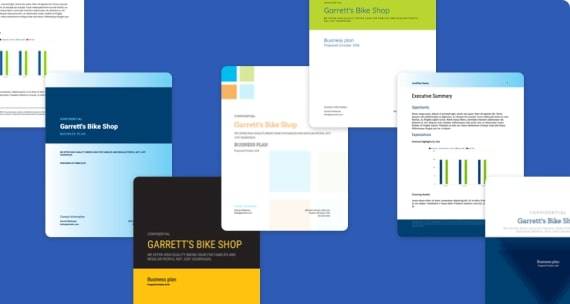
Sample Business Plan Gallery
Browse our library of over 550 free business plan examples to kickstart your own plan.
Browse our library of over 550 free business plan examples.

How to Write a Business Plan
Step-by-step guide to establish the foundation of your business quickly and efficiently.
Step-by-step guide to establish the foundation of your business.

Business Plan Template
Build your business using the proven planning template designed by the experts at Bplans.
Use the planning template designed by the experts at Bplans.

Subscribe to Bplans business insights
Stay up to date with the latest business planning, management, growth, and funding trends from bplans..
We care about your privacy. See our Privacy Policy .
Popular Downloads

SWOT Analysis
Easily evaluate your competitive position and develop effective growth strategies.
Refine your competitive strategy using a SWOT analysis.

Cash Flow Forecast
Improve the health of your business by easily estimating your business’s financial future.
Estimate and improve the financial health of your business.

Lean Business Plan Template
Fast, simple, and shareable. Start with a one-page plan to grow alongside your business.
Start with a simple one-page plan to grow alongside your business…
Start Your Business

Business Startup Guide
Get everything in order to start your business and write your business plan.
Get everything in order to start your business.

How to start a business with no money
Is it possible to start a business with no money? Check out this proven process to get your business…
Is it possible to start a business with no money? Check out this.…

Startup Checklist
Break down the startup process and check all the necessary boxes.

Estimating Startup Costs
What will it cost to start your business? These are the expenses you will need to consider.
Do you know what it will cost to start your business?

Write Your Business Plan

Business Planning in Under an Hour
Learn how to write your business plan in under an hour.

1-Page Business Plan Template
A faster, more efficient way to develop your business strategy.
Perfect Your Elevator Pitch

Pitch Guide
Learn how to create a winning elevator pitch deck and speech that will impress investors.
Impress investors with a winning pitch deck and elevator pitch.

Elements of the Elevator Pitch
If you're pitching to investors or building a pitch deck, here are the 7 things you need.
Here are the 7 things you need to include in your elevator pitch.

Components of a Pitch Deck
Here are the 11 slides you must have in your pitch deck.

Investor Pitch Template
Start your pitch off right with a proven pitch deck template.

Get Your Business Funded

Funding Guide
Learn how to prepare your business plan and pitch to secure funding for your business.
Prepare your plan and pitch to secure funding for your business.

Ways to Fund Your Business
When it comes to funding, there isn't a one-size-fits-all method. Here are your options.
Find out what funding options are available for your business.
Grow Your Business

How to Grow Your Business
Growing your business can be just as difficult as starting. Here are proven ways to grow.
Try these proven methods to continue growing your business.

Grow Using Your Business Plan
Turn your business plan into a growth-oriented business strategy.

Set Clear and Actionable Goals
Grow your business by setting clear goals and establishing key metrics for success.
Learn to set clear and actionable goals to grow your business.

How to Forecast Cash Flow
Create a cash flow forecast to help keep your business healthy and plan for the future.
Keep your business healthy using a cash flow forecast.

Tim Berry Blog
Learn from renowned business planning expert and founder of Bplans, Tim Berry.

Business Glossary
Definitions for common terminology and acronyms that every small business owner should know.

The quickest way to turn a business idea into a business plan
Fill-in-the-blanks and automatic financials make it easy.
No thanks, I prefer writing 40-page documents.

Discover the world’s #1 plan building software
24 of My Favorite Sample Business Plans & Examples For Your Inspiration
Published: February 06, 2024
I believe that reading sample business plans is essential when writing your own.

hbspt.cta._relativeUrls=true;hbspt.cta.load(53, 'e9d2eacb-6b01-423a-bf7a-19d42ba77eaa', {"useNewLoader":"true","region":"na1"});
As you explore business plan examples from real companies and brands, it’s easier for you to learn how to write a good one.
But what does a good business plan look like? And how do you write one that’s both viable and convincing. I’ll walk you through the ideal business plan format along with some examples to help you get started.
Table of Contents
Business Plan Format
Business plan types, sample business plan templates, top business plan examples.
Ask any successful sports coach how they win so many games, and they’ll tell you they have a unique plan for every single game. To me, the same logic applies to business.
If you want to build a thriving company that can pull ahead of the competition, you need to prepare for battle before breaking into a market.
Business plans guide you along the rocky journey of growing a company. And if your business plan is compelling enough, it can also convince investors to give you funding.
With so much at stake, I’m sure you’re wondering where to begin.
.webp)
Free Business Plan Template
The essential document for starting a business -- custom built for your needs.
- Outline your idea.
- Pitch to investors.
- Secure funding.
- Get to work!
Download Free
All fields are required.
You're all set!
Click this link to access this resource at any time.
Fill out the form to get your free template.
First, you’ll want to nail down your formatting. Most business plans include the following sections.
1. Executive Summary
I’d say the executive summary is the most important section of the entire business plan.
Why? Essentially, it's the overview or introduction, written in a way to grab readers' attention and guide them through the rest of the business plan. This is important, because a business plan can be dozens or hundreds of pages long.
There are two main elements I’d recommend including in your executive summary:
Company Description
This is the perfect space to highlight your company’s mission statement and goals, a brief overview of your history and leadership, and your top accomplishments as a business.
Tell potential investors who you are and why what you do matters. Naturally, they’re going to want to know who they’re getting into business with up front, and this is a great opportunity to showcase your impact.
Need some extra help firming up those business goals? Check out HubSpot Academy’s free course to help you set goals that matter — I’d highly recommend it
Products and Services
To piggyback off of the company description, be sure to incorporate an overview of your offerings. This doesn’t have to be extensive — just another chance to introduce your industry and overall purpose as a business.
In addition to the items above, I recommend including some information about your financial projections and competitive advantage here too.:
Keep in mind you'll cover many of these topics in more detail later on in the business plan. So, keep the executive summary clear and brief, and only include the most important takeaways.
Executive Summary Business Plan Examples
This example was created with HubSpot’s business plan template:

This executive summary is so good to me because it tells potential investors a short story while still covering all of the most important details.
.webp?width=500&height=418&name=executive-summary-business-plans-examples%20(1).webp)
Image Source
Tips for Writing Your Executive Summary
- Start with a strong introduction of your company, showcase your mission and impact, and outline the products and services you provide.
- Clearly define a problem, and explain how your product solves that problem, and show why the market needs your business.
- Be sure to highlight your value proposition, market opportunity, and growth potential.
- Keep it concise and support ideas with data.
- Customize your summary to your audience. For example, emphasize finances and return on investment for venture capitalists.
Check out our tips for writing an effective executive summary for more guidance.
2. Market Opportunity
This is where you'll detail the opportunity in the market.
The main question I’d ask myself here is this: Where is the gap in the current industry, and how will my product fill that gap?
More specifically, here’s what I’d include in this section:
- The size of the market
- Current or potential market share
- Trends in the industry and consumer behavior
- Where the gap is
- What caused the gap
- How you intend to fill it
To get a thorough understanding of the market opportunity, you'll want to conduct a TAM, SAM, and SOM analysis and perform market research on your industry.
You may also benefit from creating a SWOT analysis to get some of the insights for this section.
Market Opportunity Business Plan Example
I like this example because it uses critical data to underline the size of the potential market and what part of that market this service hopes to capture.

Tips for Writing Your Market Opportunity Section
- Focus on demand and potential for growth.
- Use market research, surveys, and industry trend data to support your market forecast and projections.
- Add a review of regulation shifts, tech advances, and consumer behavior changes.
- Refer to reliable sources.
- Showcase how your business can make the most of this opportunity.
3. Competitive Landscape
Since we’re already speaking of market share, you'll also need to create a section that shares details on who the top competitors are.
After all, your customers likely have more than one brand to choose from, and you'll want to understand exactly why they might choose one over another.
My favorite part of performing a competitive analysis is that it can help you uncover:
- Industry trends that other brands may not be utilizing
- Strengths in your competition that may be obstacles to handle
- Weaknesses in your competition that may help you develop selling points
- The unique proposition you bring to the market that may resonate with customers
Competitive Landscape Business Plan Example
I like how the competitive landscape section of this business plan below shows a clear outline of who the top competitors are.
.webp?width=500&height=405&name=competitive-landscape-business-plans-examples%20(1).webp)
It also highlights specific industry knowledge and the importance of location, which shows useful experience in this specific industry.
This can help build trust in your ability to execute your business plan.
Tips for Writing Your Competitive Landscape
- Complete in-depth research, then emphasize your most important findings.
- Compare your unique selling proposition (USP) to your direct and indirect competitors.
- Show a clear and realistic plan for product and brand differentiation.
- Look for specific advantages and barriers in the competitive landscape. Then, highlight how that information could impact your business.
- Outline growth opportunities from a competitive perspective.
- Add customer feedback and insights to support your competitive analysis.
4. Target Audience
Use this section to describe who your customer segments are in detail. What is the demographic and psychographic information of your audience?
If your immediate answer is "everyone," you'll need to dig deeper. Here are some questions I’d ask myself here:
- What demographics will most likely need/buy your product or service?
- What are the psychographics of this audience? (Desires, triggering events, etc.)
- Why are your offerings valuable to them?
I’d also recommend building a buyer persona to get in the mindset of your ideal customers and be clear on why you're targeting them.
Target Audience Business Plan Example
I like the example below because it uses in-depth research to draw conclusions about audience priorities. It also analyzes how to create the right content for this audience.

Tips for Writing Your Target Audience Section
- Include details on the size and growth potential of your target audience.
- Figure out and refine the pain points for your target audience , then show why your product is a useful solution.
- Describe your targeted customer acquisition strategy in detail.
- Share anticipated challenges your business may face in acquiring customers and how you plan to address them.
- Add case studies, testimonials, and other data to support your target audience ideas.
- Remember to consider niche audiences and segments of your target audience in your business plan.
5. Marketing Strategy
Here, you'll discuss how you'll acquire new customers with your marketing strategy. I’d suggest including information:
- Your brand positioning vision and how you'll cultivate it
- The goal targets you aim to achieve
- The metrics you'll use to measure success
- The channels and distribution tactics you'll use
I think it’s helpful to have a marketing plan built out in advance to make this part of your business plan easier.
Marketing Strategy Business Plan Example
This business plan example includes the marketing strategy for the town of Gawler.
In my opinion, it really works because it offers a comprehensive picture of how they plan to use digital marketing to promote the community.

Tips for Writing Your Marketing Strategy
- Include a section about how you believe your brand vision will appeal to customers.
- Add the budget and resources you'll need to put your plan in place.
- Outline strategies for specific marketing segments.
- Connect strategies to earlier sections like target audience and competitive analysis.
- Review how your marketing strategy will scale with the growth of your business.
- Cover a range of channels and tactics to highlight your ability to adapt your plan in the face of change.
6. Key Features and Benefits
At some point in your business plan, you'll need to review the key features and benefits of your products and/or services.
Laying these out can give readers an idea of how you're positioning yourself in the market and the messaging you're likely to use. It can even help them gain better insight into your business model.
Key Features and Benefits Business Plan Example
In my opinion, the example below does a great job outlining products and services for this business, along with why these qualities will attract the audience.

Tips for Writing Your Key Features and Benefits
- Emphasize why and how your product or service offers value to customers.
- Use metrics and testimonials to support the ideas in this section.
- Talk about how your products and services have the potential to scale.
- Think about including a product roadmap.
- Focus on customer needs, and how the features and benefits you are sharing meet those needs.
- Offer proof of concept for your ideas, like case studies or pilot program feedback.
- Proofread this section carefully, and remove any jargon or complex language.
7. Pricing and Revenue
This is where you'll discuss your cost structure and various revenue streams. Your pricing strategy must be solid enough to turn a profit while staying competitive in the industry.
For this reason, here’s what I’d might outline in this section:
- The specific pricing breakdowns per product or service
- Why your pricing is higher or lower than your competition's
- (If higher) Why customers would be willing to pay more
- (If lower) How you're able to offer your products or services at a lower cost
- When you expect to break even, what margins do you expect, etc?
Pricing and Revenue Business Plan Example
I like how this business plan example begins with an overview of the business revenue model, then shows proposed pricing for key products.

Tips for Writing Your Pricing and Revenue Section
- Get specific about your pricing strategy. Specifically, how you connect that strategy to customer needs and product value.
- If you are asking a premium price, share unique features or innovations that justify that price point.
- Show how you plan to communicate pricing to customers.
- Create an overview of every revenue stream for your business and how each stream adds to your business model as a whole.
- Share plans to develop new revenue streams in the future.
- Show how and whether pricing will vary by customer segment and how pricing aligns with marketing strategies.
- Restate your value proposition and explain how it aligns with your revenue model.
8. Financials
To me, this section is particularly informative for investors and leadership teams to figure out funding strategies, investment opportunities, and more.
According to Forbes , you'll want to include three main things:
- Profit/Loss Statement - This answers the question of whether your business is currently profitable.
- Cash Flow Statement - This details exactly how much cash is incoming and outgoing to give insight into how much cash a business has on hand.
- Balance Sheet - This outlines assets, liabilities, and equity, which gives insight into how much a business is worth.
While some business plans might include more or less information, these are the key details I’d include in this section.
Financials Business Plan Example
This balance sheet is a great example of level of detail you’ll need to include in the financials section of your business plan.

Tips for Writing Your Financials Section
- Growth potential is important in this section too. Using your data, create a forecast of financial performance in the next three to five years.
- Include any data that supports your projections to assure investors of the credibility of your proposal.
- Add a break-even analysis to show that your business plan is financially practical. This information can also help you pivot quickly as your business grows.
- Consider adding a section that reviews potential risks and how sensitive your plan is to changes in the market.
- Triple-check all financial information in your plan for accuracy.
- Show how any proposed funding needs align with your plans for growth.
As you create your business plan, keep in mind that each of these sections will be formatted differently. Some may be in paragraph format, while others could be charts or graphs.
The formats above apply to most types of business plans. That said, the format and structure of your plan will vary by your goals for that plan.
So, I’ve added a quick review of different business plan types. For a more detailed overview, check out this post .
1. Startups
Startup business plans are for proposing new business ideas.
If you’re planning to start a small business, preparing a business plan is crucial. The plan should include all the major factors of your business.
You can check out this guide for more detailed business plan inspiration .
2. Feasibility Studies
Feasibility business plans focus on that business's product or service. Feasibility plans are sometimes added to startup business plans. They can also be a new business plan for an already thriving organization.
3. Internal Use
You can use internal business plans to share goals, strategies, or performance updates with stakeholders. In my opinion, internal business plans are useful for alignment and building support for ambitious goals.
4. Strategic Initiatives
Another business plan that's often for sharing internally is a strategic business plan. This plan covers long-term business objectives that might not have been included in the startup business plan.
5. Business Acquisition or Repositioning
When a business is moving forward with an acquisition or repositioning, it may need extra structure and support. These types of business plans expand on a company's acquisition or repositioning strategy.
Growth sometimes just happens as a business continues operations. But more often, a business needs to create a structure with specific targets to meet set goals for expansion. This business plan type can help a business focus on short-term growth goals and align resources with those goals.
Now that you know what's included and how to format a business plan, let's review some of my favorite templates.
1. HubSpot's One-Page Business Plan
Download a free, editable one-page business plan template..
The business plan linked above was created here at HubSpot and is perfect for businesses of any size — no matter how many strategies we still have to develop.
Fields such as Company Description, Required Funding, and Implementation Timeline give this one-page business plan a framework for how to build your brand and what tasks to keep track of as you grow.
Then, as the business matures, you can expand on your original business plan with a new iteration of the above document.
Why I Like It
This one-page business plan is a fantastic choice for the new business owner who doesn’t have the time or resources to draft a full-blown business plan. It includes all the essential sections in an accessible, bullet-point-friendly format. That way, you can get the broad strokes down before honing in on the details.
2. HubSpot's Downloadable Business Plan Template

We also created a business plan template for entrepreneurs.
The template is designed as a guide and checklist for starting your own business. You’ll learn what to include in each section of your business plan and how to do it.
There’s also a list for you to check off when you finish each section of your business plan.
Strong game plans help coaches win games and help businesses rocket to the top of their industries. So if you dedicate the time and effort required to write a workable and convincing business plan, you’ll boost your chances of success and even dominance in your market.
This business plan kit is essential for the budding entrepreneur who needs a more extensive document to share with investors and other stakeholders.
It not only includes sections for your executive summary, product line, market analysis, marketing plan, and sales plan, but it also offers hands-on guidance for filling out those sections.
3. LiveFlow’s Financial Planning Template with built-in automation

This free template from LiveFlow aims to make it easy for businesses to create a financial plan and track their progress on a monthly basis.
The P&L Budget versus Actual format allows users to track their revenue, cost of sales, operating expenses, operating profit margin, net profit, and more.
The summary dashboard aggregates all of the data put into the financial plan sheet and will automatically update when changes are made.
Instead of wasting hours manually importing your data to your spreadsheet, LiveFlow can also help you to automatically connect your accounting and banking data directly to your spreadsheet, so your numbers are always up-to-date.
With the dashboard, you can view your runway, cash balance, burn rate, gross margins, and other metrics. Having a simple way to track everything in one place will make it easier to complete the financials section of your business plan.
This is a fantastic template to track performance and alignment internally and to create a dependable process for documenting financial information across the business. It’s highly versatile and beginner-friendly.
It’s especially useful if you don’t have an accountant on the team. (I always recommend you do, but for new businesses, having one might not be possible.)
4. ThoughtCo’s Sample Business Plan

One of the more financially oriented sample business plans in this list, BPlan’s free business plan template dedicates many of its pages to your business’s financial plan and financial statements.
After filling this business plan out, your company will truly understand its financial health and the steps you need to take to maintain or improve it.
I absolutely love this business plan template because of its ease-of-use and hands-on instructions (in addition to its finance-centric components). If you feel overwhelmed by the thought of writing an entire business plan, consider using this template to help you with the process.
6. Harvard Business Review’s "How to Write a Winning Business Plan"
Most sample business plans teach you what to include in your business plan, but this Harvard Business Review article will take your business plan to the next level — it teaches you the why and how behind writing a business plan.
With the guidance of Stanley Rich and Richard Gumpert, co-authors of " Business Plans That Win: Lessons From the MIT Enterprise Forum ", you'll learn how to write a convincing business plan that emphasizes the market demand for your product or service.
You’ll also learn the financial benefits investors can reap from putting money into your venture rather than trying to sell them on how great your product or service is.
This business plan guide focuses less on the individual parts of a business plan, and more on the overarching goal of writing one. For that reason, it’s one of my favorites to supplement any template you choose to use. Harvard Business Review’s guide is instrumental for both new and seasoned business owners.
7. HubSpot’s Complete Guide to Starting a Business
If you’re an entrepreneur, you know writing a business plan is one of the most challenging first steps to starting a business.
Fortunately, with HubSpot's comprehensive guide to starting a business, you'll learn how to map out all the details by understanding what to include in your business plan and why it’s important to include them. The guide also fleshes out an entire sample business plan for you.
If you need further guidance on starting a business, HubSpot's guide can teach you how to make your business legal, choose and register your business name, and fund your business. It will also give small business tax information and includes marketing, sales, and service tips.
This comprehensive guide will walk you through the process of starting a business, in addition to writing your business plan, with a high level of exactitude and detail. So if you’re in the midst of starting your business, this is an excellent guide for you.
It also offers other resources you might need, such as market analysis templates.
8. Panda Doc’s Free Business Plan Template

PandaDoc’s free business plan template is one of the more detailed and fleshed-out sample business plans on this list. It describes what you should include in each section, so you don't have to come up with everything from scratch.
Once you fill it out, you’ll fully understand your business’ nitty-gritty details and how all of its moving parts should work together to contribute to its success.
This template has two things I love: comprehensiveness and in-depth instructions. Plus, it’s synced with PandaDoc’s e-signature software so that you and other stakeholders can sign it with ease. For that reason, I especially love it for those starting a business with a partner or with a board of directors.
9. Small Business Administration Free Business Plan Template

The Small Business Administration (SBA) offers several free business plan templates that can be used to inspire your own plan.
Before you get started, you can decide what type of business plan you need — a traditional or lean start-up plan.
Then, you can review the format for both of those plans and view examples of what they might look like.
We love both of the SBA’s templates because of their versatility. You can choose between two options and use the existing content in the templates to flesh out your own plan. Plus, if needed, you can get a free business counselor to help you along the way.
I’ve compiled some completed business plan samples to help you get an idea of how to customize a plan for your business.
I chose different types of business plan ideas to expand your imagination. Some are extensive, while others are fairly simple.
Let’s take a look.
1. LiveFlow

One of the major business expenses is marketing. How you handle your marketing reflects your company’s revenue.
I included this business plan to show you how you can ensure your marketing team is aligned with your overall business plan to get results. The plan also shows you how to track even the smallest metrics of your campaigns, like ROI and payback periods instead of just focusing on big metrics like gross and revenue.
Fintech startup, LiveFlow, allows users to sync real-time data from its accounting services, payment platforms, and banks into custom reports. This eliminates the task of pulling reports together manually, saving teams time and helping automate workflows.
"Using this framework over a traditional marketing plan will help you set a profitable marketing strategy taking things like CAC, LTV, Payback period, and P&L into consideration," explains LiveFlow co-founder, Lasse Kalkar .
When it came to including marketing strategy in its business plan, LiveFlow created a separate marketing profit and loss statement (P&L) to track how well the company was doing with its marketing initiatives.
This is a great approach, allowing businesses to focus on where their marketing dollars are making the most impact. Having this information handy will enable you to build out your business plan’s marketing section with confidence. LiveFlow has shared the template here . You can test it for yourself.
2. Lula Body

Sometimes all you need is a solid mission statement and core values to guide you on how to go about everything. You do this by creating a business plan revolving around how to fulfill your statement best.
For example, Patagonia is an eco-friendly company, so their plan discusses how to make the best environmentally friendly products without causing harm.
A good mission statement should not only resonate with consumers but should also serve as a core value compass for employees as well.
Patagonia has one of the most compelling mission statements I’ve seen:
"Together, let’s prioritise purpose over profit and protect this wondrous planet, our only home."
It reels you in from the start, and the environmentally friendly theme continues throughout the rest of the statement.
This mission goes on to explain that they are out to "Build the best product, cause no unnecessary harm, and use business to protect nature."
Their mission statement is compelling and detailed, with each section outlining how they will accomplish their goal.
4. Vesta Home Automation

This executive summary for a smart home device startup is part of a business plan created by students at Mount Royal University .
While it lacks some of the sleek visuals of the templates above, its executive summary does a great job of demonstrating how invested they are in the business.
Right away, they mention they’ve invested $200,000 into the company already, which shows investors they have skin in the game and aren’t just looking for someone else to foot the bill.
This is the kind of business plan you need when applying for business funds. It clearly illustrates the expected future of the company and how the business has been coming along over the years.
5. NALB Creative Center

This fictional business plan for an art supply store includes everything one might need in a business plan: an executive summary, a company summary, a list of services, a market analysis summary, and more.
One of its most notable sections is its market analysis summary, which includes an overview of the population growth in the business’ target geographical area, as well as a breakdown of the types of potential customers they expect to welcome at the store.
This sort of granular insight is essential for understanding and communicating your business’s growth potential. Plus, it lays a strong foundation for creating relevant and useful buyer personas .
It’s essential to keep this information up-to-date as your market and target buyer changes. For that reason, you should carry out market research as often as possible to ensure that you’re targeting the correct audience and sharing accurate information with your investors.
Due to its comprehensiveness, it’s an excellent example to follow if you’re opening a brick-and-mortar store and need to get external funding to start your business .
6. Curriculum Companion Suites (CSS)

If you’re looking for a SaaS business plan example, look no further than this business plan for a fictional educational software company called Curriculum Companion Suites.
Like the business plan for the NALB Creative Center, it includes plenty of information for prospective investors and other key stakeholders in the business.
One of the most notable features of this business plan is the executive summary, which includes an overview of the product, market, and mission.
The first two are essential for software companies because the product offering is so often at the forefront of the company’s strategy. Without that information being immediately available to investors and executives, then you risk writing an unfocused business plan.
It’s essential to front-load your company’s mission if it explains your "Why?" and this example does just that. In other words, why do you do what you do, and why should stakeholders care? This is an important section to include if you feel that your mission will drive interest in the business and its offerings.
7. Culina Sample Business Plan

Culina's sample business plan is an excellent example of how to lay out your business plan so that it flows naturally, engages readers, and provides the critical information investors and stakeholders need.
You can use this template as a guide while you're gathering important information for your own business plan. You'll have a better understanding of the data and research you need to do since Culina’s plan outlines these details so flawlessly for inspiration.
8. Plum Sample Business Plan

Don't forget to share this post!
Related articles.
![sample student business plan How to Write an Executive Summary Execs Can't Ignore [+ 5 Top Examples]](https://blog.hubspot.com/hubfs/executive-summary-example_5.webp)
How to Write an Executive Summary Execs Can't Ignore [+ 5 Top Examples]
20 Free & Paid Small Business Tools for Any Budget

What is a Business Plan? Definition, Tips, and Templates

Maximizing Your Social Media Strategy: The Top Aggregator Tools to Use

The Content Aggregator Guide for 2024
![sample student business plan 7 Gantt Chart Examples You'll Want to Copy [+ 5 Steps to Make One]](https://blog.hubspot.com/hubfs/gantt-chart-example.jpg)
7 Gantt Chart Examples You'll Want to Copy [+ 5 Steps to Make One]
![sample student business plan The 8 Best Free Flowchart Templates [+ Examples]](https://blog.hubspot.com/hubfs/flowchart%20templates.jpg)
The 8 Best Free Flowchart Templates [+ Examples]

16 Best Screen Recorders to Use for Collaboration

The 25 Best Google Chrome Extensions for SEO

Professional Invoice Design: 28 Samples & Templates to Inspire You
2 Essential Templates For Starting Your Business
Marketing software that helps you drive revenue, save time and resources, and measure and optimize your investments — all on one easy-to-use platform
You are using an outdated browser. Please upgrade your browser to improve your experience.
- Online MBA Programs
- Advertising
- Artificial Intelligence
- Business Administration
- Business Analytics
- Big Data Analytics
- Business Intelligence
- Business Management
- Corporate Finance
- Computer Science
- Cybersecurity
- Data Science
- Entrepreneurship
- Financial Technology FINTECH
- Healthcare Administration
- Healthcare Management
- Health Information Management
- Hospitality Management
- Internet Marketing
- Non-Profit Management
- Public Administration
- Quantitative Analysis
Supply Chain Management
- Sustainability Management
- Sports Management
- Technology Management
- Business Certificate Programs Guide
- Military to MBA
- How to Pay for an MBA
- Is an Online MBA Worth It?
- 12 Month Online MBA
- Accounting MBA
- Best MBA Concentrations
- Cybersecurity MBA
- Best Online MBA Programs
- Entrepreneurship MBA
- Information Technology MBA
- Marketing MBA
- Risk Management MBA
- No GMAT Online MBA
- Human Resources MBA
- Best MBA Careers
- Dual Online MBA Options
- Entry Level MBA Salary
- Employer MBA Tips
- EMBA vs Regular MBA
- Online MBA Benefits
- Value of Online MBA
- MBA for Physicians
- MBA for CEO’s
- MBA for Product Management
- MBA for Entrepreneurs
- MBA Internships
- MBA for Veterans
- MBA for Nurses
- MBA for Private Equity
- MBA Scholarships
- MBA Networking
- Ace Your MBA Interview
- Your GMAT Score
- AACSB vs ACBSP Accreditation
- Brand Management
- Engineering
- Information Technology
- Management Consulting
- Non Profit Management
- Information Systems
- Marijuana Cannabis
- Operations Management
- Product Management
- Project Management
- Sports Marketing
How to Write the Perfect Business Plan
Created by Henry Steele
By Henry Steele - January 8, 2018

Are you planning to start a business or do you already own one ?
Sponsored School(s)
If the answer is yes, then you need a business plan .
This seems like an extremely daunting task, but if you understand your business, it won’t be hard at all. It’s simply a matter of organizing the information in a clear, concise manner.
The following article discusses how to write the perfect business plan, including the types of business plans most commonly used, top 10 do’s and don’ts, what goes into a business plan, the structure of your business, marketing and sales, your organizational and operational plan and much more.
What is a Business Plan?

To help you write the perfect business plan, we’ll provide you with an exact outline of everything you’ll need to include, so even if you think you’re too young, you’ll have no problem starting out.
The reason many business owners first decide to put together a business plan is that they simply have to. If you want to apply for a business loan, attract investors, or obtain any necessary licensing, business plans are a prerequisite.
Even if you don’t need financing or licensing, however, it’s still a good idea to have a well-thought-out business plan. If you need to hire any key employees, a strong business plan will help attract strong talent. Whenever you need to deal with professionals, such as a consultant or an accountant, your business plan gives them invaluable insight.
Finally, it’s a good idea to put a business plan together for your own sake . As you put the business plan together, you’ll have the chance to really conceptualize and evaluate your strategy. You’ll build proof that your idea makes both financial and logistic sense. Once you start working to get your business off of the ground, a strong business plan guides and helps you stay on-track.
Types of Business Plans
Business plans come in all shapes and sizes, but you can generally whittle them down to three key versions.
Shortened Business Plan
This is an easily digestible, much shorter version of your normal business plan. Typically, it will be between three and five pages. You should include your executive summary, financials, and any information pertinent to the person/s to whom you are presenting the plan. A shortened business plan is usually made with a specific purpose or recipient in mind, so it will be easy to figure out exactly what is and isn’t important enough to make the cut.
In-depth Business Plan
Your standard business plan, and the one we will be teaching you to write . Again, these come in handy when seeking to fund your business, attract employees or work with professionals, or simply to act as a guide.
Operational Business Plan
Unlike the other two business plans we have discussed, an operational business plan is meant for internal use only. This will not be distributed to anybody except for employees or professionals working on your company’s behalf. An operational business plan focuses on the company’s overarching goals, mission, and vision so that all department stay aligned. Your Marketing and Sales, Operational Plan, and Financial sections will be key here.
What Language Should I Use?
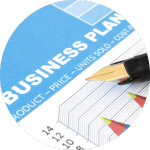
Top 10 Do’s and Don’ts
Before we dive into our business plan outline and describe each section, let’s go over some general do’s and don’ts you’ll want to keep in mind as you write your business plan:
Do: Provide Examples

Don’t: Overload the Reader
An in-depth business plan will contain lots of useful information and will likely end up being much more than ten pages. Because it’s so long by nature, you need to make sure to only include the most useful information in each section. Format everything carefully and correctly. Don’t use language that confuses or intimidates readers outside of your industry. The easier it is for the reader to absorb everything you’re presenting them, the more effective your business plan is.
Do: Proper Research

Don’t: Leave Any Stone Uncovered
Somebody who reads your business plan shouldn’t have any major questions left unanswered. Include complete information about what you are aiming to do, how you are going to do it, how much money is needed, etc. Use our full outline below to ensure everything is covered.
Do: Be Honest

Don’t: Hustle Just to ‘Get it Done’
Writing a business plan isn’t a task you’re completing and checking off your to-do list. Everything must be accurate, thoughtful, and well-articulated. Keep in mind: this will guide you as you operate your business and is the key to obtaining financing and/or pitching your business.
Do: Make it a Living Document

Don’t: Focus Solely on Your Product
You might think your business revolves around your particular product/s or service/s, but there’s so much more to it than that. Your business plan talks about how the actual business is run, so you might want to leave the technical specifications and granular details for another time.
Do: Show Your Passion
In the end, your business plan and your business are about you. While it’s important to maintain a professional tone, don’t be afraid to let your enthusiasm about your business seep through every page.
Don’t: Write Alone

How to Write a Business Plan
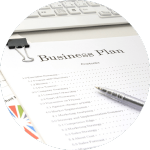
- Keep it concise.
- Know your audience.
- Perfect your executive summary.
- Focus and refine constantly.
- Gather and check all of your data.
- Be confident, but don’t go overboard.
- Be as clear and in-depth as possible.
- Enhance with graphics.
- Share and gather feedback from trusted advisors.
What Goes into a Business Plan?
When writing your business plan, you will need to put in a lot of time and research. Luckily, we’re here to walk you through all of that. A winning business plan contains the below sections, and you can use our sidebar to navigate to each of these:
- Introduction
Executive Summary
- Information About Your Business
- Industry Analysis
Marketing and Sales
- Operational Plan
Your Business Plan Introduction

Cover Letter
A cover letter is essential whenever you are presenting the business plan to somebody for a specific reason and should be tailored to each individual. Like any other letter, it should include names, dates, and a cordial greeting. In the first paragraph, explain exactly why you are presenting the business plan to the recipient. Take one or two paragraphs to discuss your business (an even more condensed executive summary, as we will cover in the next section). Finally, let the reader know you appreciate their consideration and would be happy to address any questions or concerns. Include any necessary contact information below your name and signature.
Your title page should be clean and simple. Here’s what to include in it:
- The title of the document (i.e. Business Plan, Business Proposal, Summary Business Plan).
- The name of your company.
- A sub-heading, if necessary (i.e. ‘Presented to ABC Investing Company’).
- Who the business plan was prepared by.
- The name of any other owners or key partners.
- Basic contact information.
Table of Contents
A table of contents is essential to make your business plan transparent and easy to navigate. It is unlikely that a serious potential partner or investor will read through your plan once and toss it aside, so you want to make it easy for them to return and pick up where they left off or revisit any key bits of information. If you are providing a digital copy, include clickable links to each section for the reader’s benefit.

The executive summary is exactly what it sounds like – a brief summary that describes the essence of what your business is and what it aims to do. Here’s how to write a winning executive summary:
- Begin with a single sentence that sums your business up. This is otherwise known as your value proposition.
- Describe what niche or problem your business fills or solves.
- Explain exactly how your business solves this problem in a way that the rest of the competition does not or cannot.
- A very brief (one or two sentences) summary of any other information from the following sections that would be critical to your business’ success.
Your Business / Company

Structure of Your Business
First and foremost, you’ll need to discuss the legal structure of your business:
- Sole-proprietorship: simple to set-up, but the owner is fully liable for any debts or obligations.
- Partnership: a general partnership is also simple to set-up, but all partners would be liable. Limited partnerships, or LPs, are a bit more complicated.
- Corporation: a corporation is owned by stockholders, so it is unlikely you will either want or need to structure as one. There are two types of corporations, which vary in terms of shareholder limitations and tax liabilities: S corporations and C corporations.
- Limited liability corporation (LLC): an LLC is generally the best of both worlds for small businesses. The owner’s’ liability is limited, and taxation is that of a partnership, which provides better flexibility over a corporation.
Once the legal structure is determined, you’ll need to break down the ownership of the business. Are you the sole owner? Do you have business partners? Has anybody purchased a share of the business in exchange for funding? Provide a brief introduction to any key executives or owners, outlining what strengths they have and how they will impact the business.
Finally, include a brief history (if any) of your business, and any pertinent location details.
Business Vision, Mission, and Values
This is one of the most important sections of your business plan. Here, you need to impart your passion for the business and really describe what you’re trying to achieve.
Business Vision
Your vision statement is all about the company’s goals. It serves as a template for exactly what you’re trying to achieve, both short-term and long-term. Don’t hold back when it comes to your vision: if your goal is to eventually dominate the Northeastern coffee shop scene, say that. A vision statement is your chance to think big.
Where a vision statement thinks big, a mission statement is more practical. Your mission statement should discuss your company’s purpose. Why does it even exist in the first place? This mission statement will act to provide organizational direction and help you achieve your vision.
The values are all about how you plan to operate your business in relation to the stakeholders. This includes investors, customers, and members of the local community. How do you plan to treat them? What are you doing to make their lives and the world they live in better?
Analyzing the Industry

Market Size
Here, you’ll describe exactly how large the market is. You should be able to find national figures with relatively little research. If you’re not serving a national or international market, discuss how large the population you plan to serve is. Extrapolating from the national information, how big do you expect your actual market size to be?
In addition, you should discuss any important trends. Is your market growing or retracting? If your market is growing, discuss how you project to fit into that growth and seize your market share. If your market is shrinking, discuss why you think entering the marketplace is worthwhile, and whether or not you project growth in the future.
Industry Focus and Trends

First, you’ll want to talk about the industry in general. This includes looping back to the market size and discussing whether it is growing, stagnant, or shrinking. Are there any overarching trends or cycles that will affect your business?
This is also a good opportunity to discuss pricing. What type of money does your average customer spend in your industry? What price point are you aiming for, and why is that a good strategy? If you aren’t competing on price, what reasons do you have to believe that somebody will be willing to spend more on your business?
Below, we will discuss two valuable business models you can and should use to discuss your industry further.
PEST Analysis
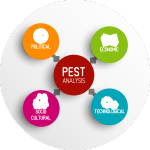
- Political: what impact could the government have on your business. Is there any pending legislation that could change how you operate? Would tax changes or tariffs cause a financial strain?
- Economic: would an economic downturn cause sales to tumble, or is your business relatively immune to economic factors? Furthermore, what do current economic trends (inflation, consumer demand, etc.) say about your short-term potential?
- Social: are there any relevant social or cultural trends that are shaping the industry? Is there a distinct seasonality to your business? Consider, for example, the impact of the Christmas season to retailers in the United States.
- Technological: how has technology shaped your industry over the past decade? Take a look at the future and make an educated guess on where the industry is headed, and how you’ll fit into that future.
Sometimes PEST is lengthened to PESTLE to include any legal or environmental factors as well. If you believe either will have a significant impact on your business, make sure to include it as well.
Porter’s 5 Forces Analysis

- Competition: we will go into this in more detail next, but for this model you should discuss how much competition there is, and how profitable they might be.
- Threat of new entrants: how easy is it for somebody to enter your industry? For a casino, it would be quite difficult (extensive significant licensing and upfront costs), but for a food truck, it would be quite minimal. The easier it is to enter your industry, the greater the threat is of somebody else entering and stealing your market share.
- Power of suppliers : if your industry has a low number of suppliers or suppliers that are dominated by much larger companies, you will have a problem sourcing on-budget and on-time. If you aren’t reliant on very specific suppliers, however, or if there is competition among suppliers, you can find yourself in an advantageous position.
- Power of customers: specifically, do your customers have the ability to drive prices down? If you expect to have a large number of small customers, your price will remain relatively stable. However, if you plan on having a small number of very important customers, they maintain the power to dramatically impact your pricing and profitability.
- Threat of substitutes: how likely is it that somebody will forego your offering for a comparable substitute. If you’re a restaurant, for example, Amazon’s grocery delivery business would be a substitute, since people may decide to stay home and cook for themselves.
Competition
It’s just as important to discuss how your competition is navigating the industry you plan on dominating. With a strong idea of where your competition is positioned and the strategic decisions they are making you will be able to determine where your own business fits in.
To begin, discuss what your competition looks like. Are there many small businesses vying for the same customers or are you competing against a couple of whales? List your most important competitors and summarize them. Discuss their location, products, pricing, market share, and any important strategic decisions they have made. Use this information to create a list of their strengths and weaknesses.
After discussing the competition, it’s time to think about where you fit among them. SWOT Analysis is the perfect model to do just that.
SWOT Analysis
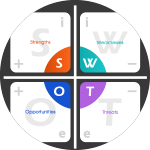
Here is what a complete SWOT Analysis looks like:
- Strengths: Exactly as it sounds. What do you do best? What do you do that the competition absolutely cannot?
- Weaknesses: Be honest. Are there any resources you lack? Any skillsets that are missing? What isn’t as efficient as it could be?
- Opportunities: Improving any of your weaknesses is a major opportunity. In addition to that, consider internal or external factors that might change and present a new business opportunity. Finally, are there any complementary products or services that you could consider offering to your customers?
- Threats: What potential is there for your business to be damaged? Are there any industry or economic trends? Could your competition change strategies and harm you? Do any obstacles to success stand in your way?
Once you have completed the SWOT analysis, wrap this section up by talking about your own competitive strategy. Given your industry, the competition, and your own SWOT analysis, what decisions are you making to position the company to succeed?
Readers of your business plan definitely need to know how you’ll be marketing and selling your product or service.There are going to be three key elements of your marketing plan.
Customer Segmentation

- Demographic information – age, gender.
- Psychographic profile – what do they care about? What motivates them? What do they value? Where do they get their information?
- Socioeconomic profile – income, lifestyle preference.
Describe your target audience in great detail. The more you know about your customer, the easier it will be to market to them.
Advertising and Promotion Plan
After building a strong customer profile of your target audience, you should know what your customer cares about. Think about how your business fits into that, and strategize how you’re going to market to them. Use their demographic and behavioral information to determine the most appropriate channels to focus on.

Your brand should seep into all aspects of your business – the website, advertisements, and even the tone of communications with customers. Whatever strategies you have for these elements, make sure to lay them out.
Finally, include your company logo and slogan, if they already exist. If not, you should begin to think about them and use the rest of this section as a guide.
Sales Distribution Plan
How exactly do you plan on getting your goods or services into somebody’s hands? Do you plan on hiring a sales staff or will you handle it all yourself initially? Do you plan on doing inbound or outbound sales? What does the sales process look at each step of the marketing funnel?
You’ll also need to think about and discuss pricing. Discuss your pricing strategy and why it’s a good value for your customers. If you are going low or moderately priced, discuss how you can stay profitable and remain differentiated from the competition. If you are a luxury brand, discuss why somebody will be willing to pay more for your business than the competition.
Lastly, consider distribution. Are you going to allow customers to purchase directly from you? Will they have to go through distributors? Do you have any retail partnerships to leverage? These are important decisions that have a profound impact on a business.
Organizational and Operational Plan

Production Process

Here are some ideas of what you’ll need to outline:
- Raw materials – how much do they cost? Do prices fluctuate? Is supply limited in quantity or how quickly it can be obtained in a pinch?
- What machines, technologies, etc., do you use for production? What costs are involved in these? Are you renting or do you own them?
- What is your estimated daily output?
- How easy is it to scale up or down as necessary? How does this impact the cost per unit?
- Which methods of quality control do you employ, both pre- and post-production?

If you’re a service business, you might not have any physical inventory, but your employees should be considered as your supply. After all, without them, you won’t be able to provide your services to your customers. What strategies do you have to recruit and retain the best talent possible? Can you scale quickly through recruiting and training, overtime, or an increase in part-time help?
You should also look back at your sales distribution plan and consider the logistics of shipping any physical products. How often will orders be fulfilled? Do you have the ability to rush orders if necessary? How will returns or incorrect shipments be handled in a way that keeps everybody happy?

Here are the components you must include in your business plan’s financial information:
Forecasted Sales
Use all of the marketing data you’ve put together to determine what a reasonable sales forecast looks like. Project your sales for a period of two or three years, going one month at a time. Include seasonality whenever applicable. As you forecast sales, include exactly how much revenue you expect to earn from those sales, and the total direct cost of those sales. You’ll be able to use these figures to determine revenue and gross margin, which you should use to compare to industry and competitive standards.
Projected Expenses

Fixed costs are going to stay the same whether you sell one widget or twenty. For example, rent, electricity, insurance, marketing costs, and payroll (with the exception of commission and bonuses), will mostly stay the same no matter what sales look like.
Variable costs, on the other hand, will vary by each unit sold. This includes the cost of materials, shipping, coupons, taxes, etc. Most of this should already be covered in your forecasted sales report, but make sure that nothing is overlooked.
Make sure to consider that as you scale, some fixed costs may become variable. As sales increase, you may have to hire more employees, or move into a bigger office. Keep this in mind by always referring back to your forecasted sales and estimating your business needs as best you can.
Balance Sheet
Everything comes together on your balance sheet. This includes your projected sales and expenses, but also deals with assets and liabilities.For example, if you take out a loan, you’ll need to include the capital in your assets and the repayments, including interest, in your liabilities. Non-monetary assets, such as the property and machinery must also be included.
You can find a sample balance sheet here .
Cash Flow Statement

Month by month, you’ll track exactly how much cash you expect to leave your hands and how much will come in. Keep in mind that not all sales are paid fully right away. Consider how many sales will be paid in full at the time of sale, how many will be paid in 30 days, 60 days, or go completely delinquent.
Once you have your cash flow statement completed, run some quick analysis. Compare your projected expenses each month to the projected cash coming in each month. For any months that project to have a negative cash flow, ensure you have enough money on hand to cover the difference.
You may find two examples of completed cash flow statements here and here .
Customer Lifetime Value
Customer Lifetime Value is an estimate of exactly how much each customer you acquire will be worth total. A simple way to calculate this is by determining how many purchases a customer makes before churning, and multiplying it by the average amount of their purchase. In other words, how many purchases will they make before moving on from your business, and how much will those purchases be worth?
Let’s take a look at a real-world example. Let’s assume you’re running an oil change business, and you know your average customer gets three oil changes per year. With premium options and add-ons, your average sale is $38.50. Each customer spends an average of three years with you before churning (perhaps they have moved away or found another service they prefer).
In this example, your expected CLV would be $346.50. You know each average customer will make 3 purchases per year, for 3 years, at $38.50 each. 3 x 3 x $38.50 = $346.50, which is your CLV.
Why is CLV so important? Let’s take a look at unit economics.
Unit Economics

The formula for cost of acquisition is simple. Divide your total marketing spend by the number of customers you have acquired through all marketing channels. If you spend $25,000 across all marketing channels and acquire 1,000 customers, your average cost per acquisition is $25.00.
Tracking your marketing expenses isn’t the tricky part. Attributing each user to a specific campaign, however, can be. If somebody walks into your store after seeing a TV ad, for example, it can be hard to properly attribute them. Digital campaigns are a bit easier, as there are typically tracking links that make everything easy to calculate. You’ll have to do your due diligence and make your best-educated guesses here, using industry standards whenever necessary and possible.
You should also take the time to break out your unit economics into each marketing channel. This allows you to track which channels are performing well and which ones aren’t. If Facebook is attracting lots of customers but you’re spending so much that your cost of acquisition is higher than expected CLV, you might actually need to stop spending money there.
It’s important to be very clear about exactly how your business has been funded so far. This includes what you have received through investments, series rounds, or personal loans. You will also need to mention any personal funds that you have put into the business, and how much you have saved that you are willing to put into it in the future.
Once you have discussed the funding your business has received, it is appropriate to lay out exactly how much you’ll need. Make sure to also discuss exactly what any loans or investments will be used for and how that spending will be tracked.
Business Plan Resources
Business plan samples.
To reinforce everything we’ve discussed above, let’s take a look at some sample business plans that have already been put together for your review. We’ll discuss some key takeaways from each plan, helping you consider how your business is unique and what you’ll need to emphasize.
Coffee Shop Business Plan
A coffee shop is a nice, simple business to start our samples with. A coffee shop requires a small storefront, and the location is critical. Most people will gladly stop in for a nice cup of coffee but are unlikely to drive miles out of their way for one. Notice that because of this, the sales forecast is relatively stagnant, even after several years.
Click here for the sample business plan.
Restaurant Business Plan
A restaurant business plan will be similar to a coffee shop, but is a little more involved. Start-up costs are higher as it requires a larger storefront and a larger variety of equipment. Variable costs are higher as a quality meal costs much more than a cup of coffee. The sales forecast shows more growth, as people are more willing to travel for a good meal than they are a simple cup of coffee.
Food Truck Business Plan
Let’s consider a third food-based business to really drive home how businesses that appear similar will have important differences. Food trucks have a much different fixed cost structure than a coffee shop or restaurant, as they don’t have a physical location. Seasonality and location will have a huge impact on salespeople won’t want to stand outside for a burrito when it’s cold and snowy outside. With a much smaller staff, a food truck is also more likely to be open for lunch only, or closed a couple days per week.
Startup Business Plan
It’s good to take a look at a general startup business plan to get an idea of how to estimate costs, sales, etc. This sample plan is a take-out pizza joint. Notice that trends are important, as the business plan notes their market is a growing area and they are aiming to fill a niche for low to middle-income families, which comprise the majority of residents in their service area. They use a mixture of studies and geographic data to make conservative estimates, giving potential investors confidence that the business can be profitable if the strategies are successfully executed.
Photography Business Plan
A photography business is a great example of a company that is minimal to the extreme. Mostly, you will be relying on your own skills and experience. Minus initial equipment and the cost of your own time, expenses are minimal. Still, you see that it’s important to have a strong plan in place so that you understand how to position your services and who exactly you’re aiming to serve.
Business Plan Tools
Here are a variety of tools that make both writing a business plan and getting your business off the ground much easier:
If you want to quickly build your idea into a business plan to validate its value or just to get started, LivePlan is perfect. The business planning process is made simple, as you simply need to answer questions and are given plenty of examples, videos, and tutorials along the way. You can even use LivePlan to collaborate with partners or investors, testing ideas on the fly and seeing its impact on your business’ health.
Click here to take a look at LivePlan.
Rocket Lawyer
When you’re starting a business, it’s extremely likely you’ll need quick legal help. You might need advice on licensing, permits, or zoning. Or perhaps you want to discuss how to structure your business as an LLC. Rocket Lawyer can help. You’ll have access to their services for a monthly fee that’s less than a cup of coffee each day. There’s an even option to help incorporate your business by filling out a couple of quick forms.
Click here to take a look at Rocket Lawyer.
Like LivePlan, StratPad offers a cloud-based chance to build your business plan and strategy on the fly. StratPad offers a demo for their services and if you’re looking for funding will even match you up automatically with a financial institution that makes sense for your business. Our suggestion is to take a look at both LivePlan and StratPad and select the one that you like best.
Click here to take a look at StratPad.
If you’re looking for a simple way to create a professional business plan without all the bells and whistles, BizPlan is perfect for you. You’ll be able to create a stylish, professional business plan using intuitive drag-and-drop templates. Financials are easy to create using a user-friendly dashboard.
Click here to take a look at BizPlan.
A typo can derail your business plan and make you look sloppy and unprepared, no matter how much effort you put into it. Grammarly is a world-class spell checker that also checks for many of the most common grammatical error for free. There’s even a browser-based version that you can use no matter where you are. For a fee, you can subscribe to Grammarly Premium, which provides an even more granular check.
Click here to take a look at Grammarly.
Business Plan Templates
Now that we have an idea of everything you need to include in your business plan and which tools you’ll need to get started, it’s time to get started. Here are some websites with sample business plan templates you may use to make writing the perfect business plan a bit easier:
- Score.org has a variety of business plan and financial statement templates, including ones for both start-ups and established businesses.
- Microsoft Office’s website has many valuable business plan templates, including a checklist and PowerPoint Presentation templates for pitching your business plan.
- The S. Small Business Administration allows you to create a business plan with a free account that you can download and distribute as a PDF.
- Santa Clara University provides a 15-section business plan that can be downloaded one section at a time or all at once.
- Law Depot offers a business plan template tailored for you. Simply answer some quick questions and your template is instantly ready to download.
How to Write a Business Plan Conclusion
In the end, a business plan is a highly unique and personalized document. A business plan that is right for your business won’t be right for any other business in the world. By closely following the outline and strategies above, however, you’ll have a great base to begin crafting your own perfect business plan.
Bibliography:
- Berry, T. 15 Reasons You Need a Business Plan. Entrepreneur. Retrieved from https://www.entrepreneur.com/article/83818.
- CBM Group. What Is The Right Tone And Writing Style For A Business Plan? Retrieved from http://www.cbmgroup.co.uk/blog/business-plan-writing/what-is-the-right-tone-and-writing-style-for-a-business-plan.
- Discover Business. How to Write a Business Plan. Retrieved from https://www.discoverbusiness.us/business-plans/.
- Fontinelle, A.How To Write A Business Plan. Investopedia. Retrieved from http://www.investopedia.com/university/business-plan/.
- Franklin, B. The Three General Types of Business Plans. Business Power Tools. Retrieved from http://www.businesspowertools.com/2016/06/management-2/the-three-general-types-of-business-plans/.
- Gregory, A. Comprehensive Business Plan Outline for Small Business. The Balance. Retrieved from https://www.thebalance.com/a-comprehensive-business-plan-outline-for-small-business-2951557.
- Gregory, A. How to Conduct a SWOT Analysis for Your Small Business. The Balance. Retrieved from https://www.thebalance.com/swot-analysis-for-small-business-2951706.
- Hazlett, M. Basics of Unit Economics. Medium. Retrieved from https://medium.com/@markhazlett/basic-of-unit-economics-79f1d6cae085.
- Investopedia. Porter’s 5 Forces. Retrieved from http://www.investopedia.com/terms/p/porter.asp.
- Johnson, J. How to Write a Cover Letter for a Business Plan. Small Business Chronicle. Retrieved from http://smallbusiness.chron.com/write-cover-letter-business-plan-43209.html.
- Katz, A. Determining the Best Legal Structure for Your Business. Entrepreneur. Retrieved from https://www.entrepreneur.com/article/236450.
- Kolowich, A. How to Write a Business Plan: A Bookmarkable Guide (With Examples). HubSpot. Retrieved from https://blog.hubspot.com/marketing/how-to-write-a-business-plan.
- Lavinsky, D. Marketing Plan Template: Exactly What To Include. Forbes. Retrieved from https://www.forbes.com/sites/davelavinsky/2013/09/30/marketing-plan-template-exactly-what-to-include/#1ddaeeb43503.
- My Own Business Institute. Session 2: The Business Plan. Retrieved from https://www.scu.edu/mobi/business-courses/starting-a-business/session-2-the-business-plan/.
- Parsons, N. How to Write a Business Plan [Updated for 2017]. Bplans. Retrieved from http://articles.bplans.com/how-to-write-a-business-plan/.
- PESTLE Analysis. What is PESTLE Analysis? A Tool for Business Analysis. Retrieved from http://pestleanalysis.com/what-is-pestle-analysis/,
- Robbins, S. Why You Must Have a Business Plan. Entrepreneur. Retrieved from https://www.entrepreneur.com/article/74194.
- Ronick, D. 10 Business Plan Dos and Don’ts. Inc. Retrieved from https://www.inc.com/articles/201104/business-plan-dos-and-donts.html.
- Ronick, D. 10 Things A Business Pitch Absolutely Does (And Does Not) Need. Business Insider. Retrieved from http://www.businessinsider.com/10-survival-tactics-for-a-successful-business-plan-pitch-2011-4/.
- Shopify. The Ultimate Guide to Business Plans, Chapter 3: The Company. Retrieved from https://www.shopify.com/guides/businessplan/the-company.
- Wasserman, E. How to Write the Financial Section of a Business Plan. Inc. Retrieved from https://www.inc.com/guides/business-plan-financial-section.html

FEATURED ARTICLES
- How AI Will Continue to Disrupt and Drive Business
- Do You Need a Business Degree to Get Your MBA?
- Leveraging Your New Master’s Degree
- Company Culture: The Future of Human Resource Management
- 10 Things Every Business Student Should Know
- 7 Ways To Make The Most of Your First Semester…
- How to Get an Employer to Sponsor Your MBA?
- The Big Question: Should You Go to College?
FEATURED INTERVIEWS
- Missouri State University Online MBA Interview
- The University of Arizona Business Analytics Interview
- University of South Florida St. Petersburg Online MBA Interview with…
"It doesn't matter how many times you have failed, you only have to be right once." - Mark Cuban
- Terms of Use
- Privacy Policy
Copyright © 2024, Business Student.com. All Rights Reserved.
Business Plan Templates for Teens
What to include in a business plan, best business plan templates for teenagers, bizkids’ guide to writing a business plan, teen entrepreneur toolbox: the small-business guide for teens, home sweet road’s my business plan, proverbial homemaker’s family business plan guide, boss club kid entrepreneur kit.
This kit is literally a business in a box, so kids and teens can get started right away as soon as they have it in their hands! Choose your kit and create the following businesses:
Small Business Administration
Solid gold biz plan, shark tank lessons in business and entrepreneurship from scholastic.
A free lesson plan with a teacher’s guide that can be used in a group setting or as a family! Topics covered include entrepreneurship basics, writing an effective business plan, crafting persuasive pitches for investment presentations, and how to find a great business mentor. The target age group is grades 6 to 12.
Shark Tank Marketing Plan
Shark tank analysis worksheet, related reading, about the author, jessica anglin.
Business Plan Examples and Sample For Students
Business Plan Examples For Students. Business Proposal Examples for Students. Also, Business Plan Sample pdf for Students. Business Plan Examples For Students Entrepreneurship PDF.
Business Plan
The employee creates the business plan to represent and improve the organization’s image to stakeholders, customers, and affiliates. It proposes the business strategy entirely mentioning how the company profits and survives in markets. So, a business plan is also known as a business proposal that is crucial for corporate branding. The business plan is essential for every company to build rapport with stakeholders and business partners as well as achieve competitiveness.
Business Plan Examples
Business plan writing is a mandatory assignment for students in entrepreneurship. It is also a compulsory assignment for business students. The importance of a business plan is growing day by day for selling products on digital platforms and managing the organization virtually.
The business proposal is also compulsory for getting a bank loan. The organization needs it to make agreements with other organizations. The bank authority surely asks the organization to submit a business plan with the bank loan application. The other names of a business plan are business proposal, report, profile, and more. A business plan example is also known as an example of a company profile , business proposal example, sample, and format.
Elements of Business Plan Example
Business plan examples for student entrepreneurship.
Today, the authors present a business plan example for students. They wrote it while they were students in entrepreneurship courses at the Faculty of Economics and Management University Putra Malaysia (UPM). The lecturer sets group assignments for the students; therefore, the students make the business plan example to complete the group assignment. Thus, this business plan or proposal example for students certainly assists business administration students. It also assists students in BBA, MBA, economics, finance, and business communication courses and researchers.
The author also wrote business plan examples for students about food and an Example of Business Report.
The students set the company name “BambooS.” It sells reusable and eco-friendly bamboo straws. Straws are a unique product in Malaysia that can be customized for length and diameter. Besides, the company offers engraving services for customers. So, customers can customize a meaningful word on the bamboo straw for engraving. In addition, it provides a designed pouch as packaging for our straw that looks smart.
Business Plan Example For Students
1.0 executive summary of business plan.
BambooS Sdn. Bhd. company was created by a group of 10 students in the Basic Entrepreneurship course. This company is named BambooS. It produces and sells bamboo-based products. The capital S in the company’s name stands for straw. The original idea came from a student. We chose Bamboo as the main ingredient of the products. Currently, we focus on producing eco-friendly straws to serve our customers. The products are the best quality yet affordable straws.
There are ten members in a group and each member will contribute RM 100. The total paid-up capital is RM 1000. We set up our warehouse in the Serdang area to produce, package, and store our products. We are making the straw as per the customer’s demand and request. For the marketing part, we are advertising and promoting our product through social media sites, such as WhatsApp, Instagram, and Facebook, and e-commerce, such as Shopee. We adopt the lean canvas business model tool to assess the outcome of the business.
2.0 Background of the Company
2.2 company overview, 2.3 vision and mission statement, 2.3.1 vision statement.
To become the most notable company in Malaysia for producing eco-friendly bamboo straws.
2.3.2 Mission Statement
We want to fulfill the objective of satisfying customers with our eco-friendly products. We want to reduce pollution by using reusable straws anywhere and anytime.
2.4 Keys To Success
| We will always keep in touch with the customer to collect all the feedback on our product or service so we can improve to reach the customer’s satisfaction | |
| Additionally, the management helps customers in customizing and choosing the best straw size based on their preferences. | |
| Moreover, BambooS delivers products all around Malaysia. | |
| Finally, the products are very reusable, affordable, and eco-friendly. |
2.5 Organizational Chart
3.0 administration and human resource plan, 3.1 business strategies.
Business strategy is crucial to maintain business growth.
a. Administration and Human Resources Department
B. marketing department, c. operational department, 3.2 management team, 3.3 job descriptions, 4.0 market plan, 4.1 introduction, 4.2 objective of marketing.
Additionally, metal straws are not pocket-friendly compared to Bamboo. Moreover, metal will rust when in contact with water and oxygen. Bamboo stock is much cheaper, less work, and easy to collect. Our marketing strategy will focus mainly on reusable principles which are much more trendy to youngsters because we have an engraving service to attract them.
4.3 Analysis of Marketing
4.3.1 market trend.
The demand for bamboo straws has risen due to growing environmental attention. Additionally, plastic straws have been reduced due to state restrictions. However, the bamboo straw market is expected to achieve high growth shortly. In addition, BambooS Sdn. Bhd is a unique company in Malaysia. We produce our straw ourselves, and we provide safety and hygiene assurance. The buyer can engrave their name on the straw. Nowadays, customers want recognition for something they buy or support. They are also sincere about ‘Save the Earth’ and deserve to flex.
4.3.2 External Environment Analysis
4.3.3 internal environment analysis, 4.3.4 market opportunities.
Our bamboo straw comes with a pouch; thus, it is hygienic and easy to bring everywhere. We also provide a small brush to ensure deep cleaning of the inner straw. Our product can be used again and again. So students and staff can save money. They do not need to bring straws in large volumes. The structure of our bamboo straw is strong and sturdy; thus, it will not break if soaked in water for a long time, unlike paper straws.
4.4 Target Market
4.4.1 segmentation, 4.4.2 consumer market and buyer behaviour, 4.4.3 positioning, 4.5 4 p’s marketing strategy, 4.5.1 product strategy.
To make our product unique, we ensure the quality and safety of our products always satisfy our customers.
Labeling/Customised
4.5.2 price strategy.
Our management team decided to sell the straw in four sets: A, B, C, and D. Our company decided to set the price at RM 10.00 for set A. This set includes the common Bamboo straw, brush, and pouch. Then SET B cost RM 12.00, including the Boba size straw, brush, and pouch. SET C and SET D are more special because they include the engraving service. The engraving cost is RM 8.00 for each Set. As we mentioned before, we resize products for clients. So our customers can personally request to resize the straw. We charge it costs RM 9.00 per set.
4.5.3 Place Strategy
Place strategy is also known as distribution strategy, wherein the organization decides the mode of distribution for the product. The pacing strategy plays an important role in selling the products. We have chosen the market, cafe, or restaurant adjacent to the University Putra Malaysia. Our main target market is UPM staff and students.
4.5.4 Promotion Strategy
Social media advantages.
We fully develop every post to attract customers. In addition, we will always update our posts and story feeds. We ensure that customers are more exposed to our product. Next, we also use social media hashtags. We use hashtags such as #Bamboos, #SafeTheEarth, and more to make it easier for customers. The marketing team uses social media for the ordering process.
5.0 operations planning
5.1 location and address, 5.2 objective of operations, 5.3 operation strategies.
A few strategies have been set up to ensure that our business runs smoothly throughout the week and meets our objectives.
5.4 Supplier
5.5 process planning, 5.6 implementation schedule, 5.7 machinery and equipment including gst, 6.0 financial plan, 6.1 introduction.
A financial plan can be defined as a process of framing procedures and budgets regarding the financial activities of concern. This is done to ensure good financial and investment procedures.
A financial plan is one of the most crucial parts of a business. Some of the importance of a financial plan are:
6.2 Purpose of the Financial Department
6.3 project implementation cost, source of fund, 6.4 list of expenses.
Twelve partners funded a total of RM1000.00 to cover all business costs, which is RM 617.29. Expenses are in terms of buying raw materials, equipment, and delivery fees. We will not invest all amount to the business.
6.5 Record of List of Sales
6.6 income statement.
After one month of business, BambooS ended up with RM 1600.00 from 7 different products. This includes selling 15 units of Set 1, 25 of Set 2, 35 of Set 3, and 30 of Set 4. Leftovers for bamboo straws are found. The income statement shows that the business’s net profit after one month of operation is RM 988.39, approximately 98.8% of capital invested into the business.
6.7 Cash Flow Statement
6.8 balance sheet.
At the end of 9 weeks’ business (22 June 2021), the cash on hand increased to RM 1982.71, as well as the owner’s equity. The firm’s net worth is RM 1982.71, done by subtracting liabilities from assets.
6.9 Financial Analysis
7.0 conclusion.
Based on the business plan template or business proposal example that we have made, BambooS will give us profitable returns. The assumptions we made for these three months are conservative as we know that our company is still in the beginning, and the marketing and promotion are still in the early phase. The company sets systematic planning to reach the target. Thus, BambooS is very confident that our company will be able to grow in the future and become the most popular brand in the world.
Problem Faced and Solutions in Business
Moreover, we also have to face a conflict in fixing the vendors. We need to find the best vendors that offer the most reasonable price for us to produce the bamboo straw. The cost must be tele with our starting capital. To solve this, everyone has done their research on all the possible suppliers until we find the best one to choose from.
Business Proposal Examples For Students PDF
Author: m m kobiruzzaman.
M M Kobiruzzaman, Researcher and Content Writer View all posts by M M Kobiruzzaman
16 thoughts on “Business Plan Examples and Sample For Students”
Leave a reply cancel reply.

A Sample Student Accommodation Business Plan Template
By: Author Tony Martins Ajaero
The real estate industry is a very vast industry and new businesses keep unraveling in the industry from time to time. There is a wide range of businesses with good turnover that an aspiring entrepreneur who is looking towards starting a business in the real estate industry can successfully start. One of such businesses is a student accommodation rental business.
This business requires minimal startup capital and minimal manpower and can be started from a home office especially if you are not going to raise money to develop the properties yourself. If you have decided to start a student accommodation business, then you need to write your own business plan.
The essence of writing a business plan before starting any business is for you to have a blueprint of how you would setup, manage and expand your business. Below is a sample student accommodation rental company business plan template that will help you successfully write yours with little or no stress.
How to Write a Student Accommodation Business Plan [Sample Template]
1. industry overview.
Student accommodation business is classified under the real estate industry and the real estate industry is one of the many industries that is a major contributor to the growth of the economy of many nations of the world. As a matter of fact, a real estate agent can become a millionaire ‘overnight’ from just one real estate deal; little wonder the industry is responsible for making many instant millionaires in South Africa, as well as the rest of the world.
The Bureau of Labor Statistics projects 11.1 percent job growth for real estate sales agents between 2012 and 2022, which is about as fast as average. During that time, an additional 38,000 jobs will open up.
south africa is attracting a good number of foreign students and the latest research by Jones Lang LaSalle (JLL) has found that the number of young adults aged 18-25 will increase to almost 100 million by 2022, and that the demand for new, purpose-built student accommodation is set to top 500, 000 beds in the next five years.
Current accommodation arrangements can accommodate fewer than one in five students who apply for residency, and student numbers are growing annually as increasing numbers of young people complete their secondary schooling.
The real estate industry involves the buying, the selling, or the renting of lands, buildings or housing facility. Real estate agency or a real estate agent (broker) is a person who acts as a middleman between the sellers and buyers of real estate. They are involved in searching for sellers who sell properties and buyers who to buy properties.
A real estate agency (brokerage firm) usually receives a payment called a commission for successfully matching a seller’s real estate with a buyer’s real estate need such that a sale or rent/lease can be made. In most cases, the commission generated is shared with other real estate brokers or agents who played their parts in ensuring that the property is sold or rented out as the case may be.
It is important to state that in South Africa, each province has its own unique laws that clearly define the types of relationships that can exist between real estate agencies (professionals) and property owners (clients). Nonetheless, it is always a win – win for both real estate agencies and owners of properties because real estate brokers and their salespersons (commonly called “real estate agents” or “brokers”) usually assist sellers in marketing their property and selling it for the highest possible price under the best terms.
The real estate industry is highly regulated in South Africa and anyone who aspires to become a real estate agent or start a real estate agency must apply and obtain a license before they can legally receive remuneration for services rendered as a real estate agency or real estate broker. But as a lawyer, you can handle real estate deals in South Africa and make your commission without operating as a licensed real estate agent.
The practice is that a real estate licensed agent is required to disclose to prospective buyers and sellers the nature of their relationship within the transaction and with the parties involved in the deal. It is the practice for most standard student accommodation rental companies to also engage in other forms of rental businesses as it relates to properties . Some even go as far as engaging in property development.
Service delivery for a student accommodation rental company is simple and straight forward, especially if they are not involved in other complimentary services within the scope of their business.
2. Executive Summary
Oliver Tambo & Co® Real Estate Agency, LLP is a real estate agency that will operate in all the Province in South Africa but will be headquartered in Cape Town close to the University of Cape Town which happens to be the oldest University with the highest enrollment in South Africa.
We intend to become specialists in owning, developing, acquiring, managing, selling and renting/leasing students’ accommodation, office apartments and hall facilities. This can generally be summed up as clean, safe accommodation within easy reach of campus at an affordable price, and in our experience, the most consistent demand is for newly-built and pre-owned one and two-bedroom sectional title apartments with high tech security, parking and good access to shops and other amenities as well as the campus.
Part of our goal as a real estate agency is to grow to become one of the top 5 largest real estate companies in the whole of South Africa and to rent and manage properties across university campuses in South Africa.
Oliver Tambo & Co® Real Estate Agency, LLP will be committed when it comes to maintaining a diverse portfolio of high quality students’ apartment, office structures and hall facilities. We will also focus on providing a dynamic, proactive and vibrant work environment for all our employees such as discounted rentals for all our student agents and caretakers, and mouthwatering bonus for every deal that comes through any of the staff.
Oliver Tambo & Co® Real Estate Agency, LLP is going to be a self-administered real estate investment trust (REIT). We will engage in a wide range of student accommodation rental services. We will work towards becoming one of the largest student accommodation rental companies in South Africa.
As part of our plans to make our customers our number one priority and to become one of the leading student accommodation rental companies in South Africa, we have perfected plans to adopt international best practices that can favorable compete with the best in the industry. Oliver Tambo & Co® Real Estate Agency, LLP has overtime perfected plans that will help us to become a specialist in our area of business.
Oliver Tambo & Co® Real Estate Agency, LLP will at all times demonstrate her commitment to sustainability, both individually and as a firm, by actively participating in our communities and integrating sustainable business practices wherever possible. We will ensure that we hold ourselves accountable to the highest standards by meeting our client’s needs precisely and completely.
Oliver Tambo & Co® Real Estate Agency, LLP is founded by Rowland Oliver Tambo, Sean Mbeki and Sarah Zuma. They are the major financiers of the company. R. Oliver Tambo is the company’s president and CEO. Rowland Oliver Tambo has over 10 years of real estate experience in significant senior management positions in the areas of sales, marketing, new technologies and franchise management.
3. Our Products and Services
Oliver Tambo & Co® Real Estate Agency, LLP is going to offer varieties of services within the scope of the real estate industry in South Africa. Our intention of starting our student accommodation rental company is to favorably compete with leading players in the student accommodation rental industry in South Africa.
We are well prepared to make profits from the industry and we will do all that is permitted by the law in South Africa to achieve our business goals and objectives. Our business offerings are listed below;
- Rental of one-unit student accommodation structures
- Rental of two- to four-unit student accommodation structures
- Rental of five- to nine-unit student accommodation structures
- Rental of 10- to 19-unit student accommodation structures
- Rental of 20- to 49-unit student accommodation structures
- Rental of 50- or more unit student accommodation structures
- Rental of manufactured student homes, mobile homes or trailers
- Real estate consultancy and advisory services
4. Our Mission and Vision Statement
- Our vision is to become one of the top 5 student accommodation rental companies in South Africa within the first 10 years of starting R. Oliver Tambo & Co® Real Estate Agency, LLP.
- Our mission of starting a student accommodation rental business is to grow the business beyond the city where we are going to be operating from to become a national and international brand by opening offices all across key cities in South Africa and franchising .
Our Business Structure
Our company’s structure is not entirely different from what is obtainable in the real estate industry, as a matter of priority, we have decided to create a structure that will allow for easy growth for our business, and we have created platforms that will enable us attract some of the best hands in the industry.
We are quite aware that the success of any business lies in the foundation on which the business is built on, which is why we have decided to build our student accommodation rental company on the right business foundation. We will ensure that we only hire people that are qualified, honest, hardworking, customer centric and are ready to work to help us build a prosperous business that will benefit all the stake holders.
As a matter of fact, profit-sharing arrangement will be made available to all our senior management staff and it will be based on their performance for a period of five years or more depending how fast we meet our set target.
Oliver Tambo & Co® Real Estate Agency, LLP is aware of the modus operandi in the student accommodation rental line of business, hence adequate provision and competitive packages has been prepared for independent real estate agents. Our marketing department will be responsible for managing this aspect of our business.
Below is the business structure we will build R. Oliver Tambo & Co® Real Estate Agency, LLP on;
- Chief Executive Officer
- Company’s Lawyer / Secretary
Admin and HR Manager
Real Estate Agents
- Business Developer/Sales and Marketing
- Customer Service Executive / Front Desk Officer
5. Job Roles and Responsibilities
Chief Executive Officer – CEO (President):
- Increases management’s effectiveness by recruiting, selecting, orienting, training, coaching, counseling, and disciplining managers; communicating values, strategies, and objectives; assigning accountabilities; planning, monitoring, and appraising job results; developing incentives; developing a climate for offering information and opinions
- Responsible for fixing prices and signing business deals
- Responsible for providing direction for the business
- Creates, communicates, and implements the organization’s vision, mission, and overall direction – i.e. leading the development and implementation of the overall organization’s strategy.
- Responsible for signing checks and documents on behalf of the company
- Evaluates the success of the organization
Company’s Lawyer/Secretary/Legal Counsel
- Responsible for drawing up contracts and other legal documents for the company
- Consult and handle all corporate legal processes (e.g. intellectual property, mergers & acquisitions, financial/securities offerings, compliance issues, transactions, agreements, lawsuits and patents et al)
- Develops company policy and position on legal issues
- Researches, anticipates and guards company against legal risks
- Represents company in legal proceedings (administrative boards, court trials et al)
- Play a part in business deals negotiation and take minutes of meetings
- Responsible for analyzing legal documents on behalf of the company
- Prepares annual reports for the company
- Responsible for overseeing the smooth running of HR and administrative tasks for the organization
- Designs job descriptions with KPI to drive performance management for clients
- Regularly hold meetings with key stakeholders to review the effectiveness of HR Policies, Procedures and Processes
- Maintains office supplies by checking stocks; placing and expediting orders; evaluating new products.
- Ensures operation of equipment by completing preventive maintenance requirements; calling for repairs.
- Defines job positions for recruitment and managing interviewing process
- Carries out induction for new team members
- Responsible for training, evaluation and assessment of employees
- Responsible for arranging travel, meetings and appointments
- Oversees the smooth running of the daily office activities
- In charge of leasing and renting out student accommodations and other properties under our list
- In charge of inspecting and reporting on the structural attributes of a building
- Evaluates the component systems of a building (electrical, fire, roofing and plumbing)
- Assesses compliance with building, electrical, plumbing and fire codes
- Evaluates building plans and permits
- Reviews and approves plans that meet building codes, local ordinances and zoning regulations
- Keeps daily logs, including photographs taken during inspection
Marketing and Sales Executive/Business Developer
- Identifies, prioritizes, and reaches out to new partners, and business opportunities et al
- Identifies development opportunities; follows up on development leads and contacts; participates in the structuring and financing of projects; assures the completion of development projects.
- Responsible for supervising implementation, advocate for the customer’s need s, and communicate with clients
- Finds and qualifies land for development based on company’s land requirements; maintains a land search database; initiates discussions with property owners about the possible sale of property
- Develops, executes and evaluates new plans for expanding sales
- Documents all customer contact and information
- Represents the company in strategic meetings
- Helps to increase sales and growth for the company
- Responsible for preparing financial reports, budgets, and financial statements for the organization
- Provides managers with financial analyses, development budgets, and accounting reports; analyzes financial feasibility for the most complex proposed projects; conducts market research to forecast trends and business conditions.
- Responsible for financial forecasting and risks analysis.
- Performs cash management, general ledger accounting, and financial reporting for one or more properties.
- Responsible for developing and managing financial systems and policies
- Accountable for administering payrolls
- Ensures compliance with taxation legislation
- Handles all financial transactions for the company
- Serves as internal auditor for the company
Front Desk/Customer’s Service Officer
- Receives Visitors/clients on behalf of the organization
- Receives parcels/documents for the company
- Handles enquiries via e-mail and phone calls for the organization
- Distributes mails in the organization
- Ensures that all contacts with clients (e-mail, walk-In center, SMS or phone) provides the client with a personalized customer service experience of the highest level
- Through interaction with clients on the phone, uses every opportunity to build client’s interest in the company’s products and services
- Manages administrative duties assigned by the line manager in an effective and timely manner
- Consistently stays abreast of any new information on the company’s properties that are put up for sale to ensure accurate and helpful information is supplied to clients when they make inquiries.
6. SWOT Analysis
Starting a student accommodation rental business in South Africa comes with its own fair share of challenges, you would have to abide by the law and also compete with loads of other entrepreneurs in the real estate business value chain who also are interested in making a living and building a business in Cape Town – South Africa.
In order to compete favorably in the student accommodation rental line of business, we have been able to hire the services of a tested and trusted HR consultant to help us conduct our SWOT analysis. Here is a summary from the result of the SWOT analysis that was conducted on behalf of R. Oliver Tambo & Co® Real Estate Agency, LLP.
Some of the strengths that we will be bringing to the table in the student accommodation rental industry are our robust relations with student accommodation owners in the whole of South Africa. Also, we have a team of experts that have cut their teeth in the real estate industry cum student accommodation line of business. Our commission structure and relationship with freelance real estate agents in Cape Town and other Provinces in South Africa will also count towards our advantage.
As a newbie in the student accommodation rental line of business, we might have some challenges competing with big time realtors and other student accommodation rental companies that have been in the industry for many years; that perhaps is part of our weakness.
- Opportunities:
The opportunities in the real estate industry especially as a student accommodation rental company is massive considering the rapid growth of university enrollments in South Africa, this trend has been bolstered by highly favorable demographics. We are well – positioned and ready to take advantage of any opportunity that comes our way.
Some of the threats that we are likely going to face as a student accommodation company are unfavorable government and university governing board policies, and global economic downturn. Global economic downturn usually affects spending power and the real estate industry is known to encounter decline in sales and profits during this period.
There is hardly anything we could do as regards these threats other than to be optimistic that things will continue to work for our good.
7. MARKET ANALYSIS
- Market Trends
The market trends in the student accommodation line of business in South Africa is such that international students are targeted since they are the ones who are willing to pay more to get secured and decent students’ apartment. As a matter of fact, security is a key factor when it comes to renting a student apartment in South Africa and next to security is closeness to the campus.
Another obvious trend that is common with student accommodation rental companies in South Africa is that most of them are improvising on more means of making money in the real estate industry and as matter of fact they are also acting as property developers and home staging agents amongst many other functions.
One thing is certain for every student accommodation rental company; if they are hardworking, creative and proactive, they will always generate enough income to meet all their overhead and operational costs, keep their business going without struggle and make reasonable profits from their business deals.
8. Our Target Market
As a student accommodation rental company, our target market cuts across students of different classes and cultures. We are coming into the student accommodation rental industry with a business concept that will enable us work with local and international students who are interested in renting student apartments at an affordable price.
Our Competitive Advantage
The availability of competent and reliable real estate agents under our payroll, our business process, the financial structure of the company, management of a high-quality asset portfolio, superior financial and debt management and of course our pricing model, are part of our competitive advantage.
Another possible competitive strategy for winning our competitors in this particular industry is to build a robust clientele base and ensure that our student apartments are trendy. Our organization is well positioned, key members of our team are highly reliable and competent and can favorably compete with the some of the best in the student accommodation rental industry.
Lastly, our employees will be well taken care of, and their welfare package will be among the best within our category in the industry. It will enable them to be more than willing to build the business with us and help deliver our set goals and objectives. We will also engage freelance marketing agents on a commission to help us market our services.
9. SALES AND MARKETING STRATEGY
- Sources of Income
Oliver Tambo & Co® Real Estate Agency, LLP is established with the aim of maximizing profits in the student accommodation rental industry. Below are the sources we intend exploring to generate income for R. Oliver Tambo & Co® Real Estate Agency, LLP;
10. Sales Forecast
It is a known fact that as long as there are students in University campuses in South Africa, there will always be need to for them to hire the services of student accommodation rental companies from time to time.
We are well positioned to take on the challenges that are synonymous to student accommodation rental businesses in South Africa, and we are quite optimistic that we will meet out set target of generating enough profits from our first month of operation and grow the business beyond Cape Town to other Provinces in South Africa within record time.
We have been able to critically examine the student accommodation rental line of business, we have analyzed our chances in the industry and we have been able to come up with the following sales forecast. The sales projections are based on information gathered on the field and some assumptions peculiar to similar start – ups in Cape Town – South Africa;
- First Fiscal Year: R200,000
- Second Fiscal Year: R500,000
- Third Fiscal Year: R800,000
N.B : This projection was done based on what is obtainable in the industry and with the assumption that there won’t be any major economic meltdown and any major competitor offering same services as we do within the locations we have strong business presence. Please note that the above projection might be lower and at the same time it might be higher since some factors are beyond our control.
- Marketing Strategy and Sales Strategy
We quite mindful of the fact that there are competitions in the student accommodation rental market in South Africa, hence we have been able to hire some of the best business developers to handle our sales and marketing.
Our sales and marketing team will be recruited based on their vast experience in the industry and they will be trained on a regular basis to meet their targets and the overall goal of the organization. The training is not restricted to only our full – time employees but also all our freelance brokers that are scattered all over university campuses in South Africa.
Our goal is to become one of the leading student accommodation rental companies in South Africa which is why we have mapped out strategies that will help us take advantage of the available market and grow to become a major force in the industry.
Oliver Tambo & Co® Real Estate Agency, LLP is set to make use of the following marketing and sales strategies;
- Introduce our student accommodation rental company by sending introductory letters alongside your brochure to students and other key stake holders throughout the city where our company is located.
- Print out fliers (list of accommodations for rent) and business cards and strategically drop them in offices, car parks, libraries, public facilities and train stations et al.
- Use friends and family to spread word about our business
- Post information about our company and the services we offer on bulletin boards in places like car parks, schools, libraries, and local coffee shops et al
- Place classified advertisements in the newspaper, or local publication about our company and the services we offers
- Leverage on referral networks such as agencies that will attract clients (students) who would need our student apartments
- Advertise our student accommodation rental services company in relevant real estate magazines, newspapers, TV and radio stations.
- Attend relevant real estate expos, seminars, and business fairs et al to market our services
- Engage in direct marketing approach
- Encourage the use of Word of mouth marketing from loyal and satisfied clients
- Join local chambers of commerce and industry to market our product and services.
11. Publicity and Advertising Strategy
We have been able to work with our consultants to help us map out publicity and advertising strategies that will help us walk our way into the heart of our target market. We are set to take the student accommodation rental industry by storm which is why we have made provisions for effective publicity and advertisement of our company.
Below are the platforms we intend to leverage on to promote and advertise our student accommodation rental business;
- Place adverts on both print and electronic media platforms
- Maximize our company’s website to promote our business
- Leverage on the internet and social media platforms like; Instagram, Facebook, Twitter, LinkedIn, Google+ and other platforms (real estate online forums) to promote our business and list our properties for sale and for lease.
- Install our billboards in strategic locations in and around the university community in Cape Town
- Distribute our fliers and handbills in targeted areas from time to time
- Attend student association meetings with the aim of networking and introducing our business.
- Ensure that all our workers wear our branded shirts and all our vehicles are branded with our company’s logo
12. Our Pricing Strategy
Part of our business strategy is to ensure that we work within the budget of our potential clients to help them meet their expectations. It is the practice in most parts of the world for properties to be valued by professionals based on the area the facility is located, the type of facility and other factors.
Since we are not directly in control of the pricing system in the real estate industry, we can only abide by what is obtainable when it comes to fixing a price for our accommodations. But one thing is certain, we will ensure that we make available decent and secured accommodation when have we are contracted to do so.
Lastly, we will ensure that we keep our fees below the average market rate for all of our clients by keeping our overhead low. In addition, we will also offer special discounted rates to our clients from time to time especially when they recommend clients to us.
- Payment Options
At R. Oliver Tambo & Co® Real Estate Agency, LLP our payment policy is all inclusive because we are quite aware that different people prefer different payment options as it suits them but at the same time, we will not accept payment by cash because of the volume of cash that will be involved in most of our transactions.
Real estate deals usually involve huge amount of money. Here are the payment options that R. Oliver Tambo & Co® Real Estate Agency, LLP will make available to her clients;
- Payment by via bank transfer
- Payment via online bank transfer
- Payment via check
- Payment via bank draft
In view of the above, we have chosen banking platforms that will help us achieve our plans without any hitches and we will also pay our freelance sales agents with the same platforms. Our bank account numbers will be made available on our website and promotional materials.
Any agent who intends paying with cash will be directed to deposit the money into our corporate account and then present their payment tellers to us.
13. Startup Expenditure (Budget)
From our market survey and feasibility studies , we have been able to come up with a detailed budget on achieving our aim of establishing a standard student accommodation rental company in Cape Town – South Africa and here are the key areas where we will spend our start – up capital;
- The total fee for incorporating the business in South Africa – Name reservation application costs R50 and company registration R125
- The budget for permits and license – R1,000
- The cost for hiring Consultant – R2,500
- The cost for computer software apps (Accounting Software, Payroll Software, CRM Software, Microsoft Office, QuickBooks Pro, drug interaction software, Physician Desk Reference software) – R7,000
- The budget for insurance (general liability, workers’ compensation and property casualty) coverage at a total premium – R5,400.
- Cost of payment of rent for a suitable office facility in Cape Town for 12 months at R1.76 per square feet in the total amount of – R65,600.
- The cost for office remodeling (construction of racks and shelves) – R7,000.
- The cost for equipping the office (computers, printers, fax machines, furniture, telephones, filing cabins, safety gadgets and electronics et al) – R15,000
- Other start-up expenses including stationery and phone and utility deposits ( R2,500 ).
- Operational cost for the first 3 months (salaries of employees, payments of bills et al) – R30,000
- The cost of launching our official website – R600
- Additional Expenditure (Business cards, Signage, Adverts and Promotions et al) – R5,000
Going by the report from the market research and feasibility studies conducted, we will need over one hundred and fifty thousand ( R150,000 ) South African Rand to successfully set up a small scale but standard student accommodation rental company in Cape Town – South Africa.
Generating Startup Capital for R. Oliver Tambo & Co® Real Estate Agency, LLP
Oliver Tambo & Co® Real Estate Agency, LLP. is a business that will be owned and managed by Rowland Oliver Tambo, Sean Mbeki and Sarah Zuma. They are the sole financiers of the business which is why they decided to restrict the sourcing of the startup capital for the business to just three major sources.
These are the areas we intend generating our startup capital;
- Generate part of the startup capital from personal savings and sale of his stocks
- Generate part of the startup capital from friends and other extended family members
- Generate a larger chunk of the startup capital from the bank
N.B: We have been able to generate about R50,000 ( Personal savings R30,000 and soft loan from family members R20,000 ) and we are at the final stages of obtaining a loan facility of R100,000 from our bank. All the papers and documents have been duly signed and submitted, the loan has been approved and any moment from now our account will be credited.
14. Sustainability and Expansion Strategy
The future of a business lies in the number of loyal customers that they have, the capacity and competence of their employees, their investment strategy and the business structure. If all these factors are missing from a business, then it won’t be too long before the business closes shop.
One of our major goals of starting R. Oliver Tambo & Co® Real Estate Agency, LLP is to build a business that will survive off its own cash flow without injecting finance from external sources once the business is officially running. We know that one of the ways of gaining approval and winning customers over is to rent out standard, and secured student accommodations a little bit cheaper than what is obtainable in the market and we are prepared to survive on lower profit margin for a while.
Oliver Tambo & Co® Real Estate Agency, LLP will make sure that the right foundation, structures and processes are put in place to ensure that our staff are well taken of. Our company’s corporate culture is designed to drive our business to greater heights and training and retraining of our workforce is at the top burner.
We know that if that is put in place, we will be able to successfully hire and retain the best hands we can get in the industry; they will be more committed to help us build the business of our dreams.
Check List/Milestone
- Business Name Availability Check: Completed
- Business Incorporation: Completed
- Opening of Corporate Bank Accounts in various banks in South Africa: Completed
- Opening Online Payment Platforms: Completed
- Application and Obtaining Tax Payer’s ID: In Progress
- Application for business license and permit: Completed
- Purchase of Insurance for the Business: Completed
- Renting of Office Facility and remodeling the facility in Cape Town – South Africa: Completed
- Conducting Feasibility Studies: Completed
- Generating capital from the CEO and Business Partners: Completed
- Applications for Loan from our Bankers: In Progress
- Writing of Business Plan: Completed
- Drafting of Employee’s Handbook: Completed
- Drafting of Contract Documents and other relevant Legal Documents: In Progress
- Design of The Company’s Logo: Completed
- Printing of Promotional Materials: Completed
- Recruitment of employees: In Progress
- Purchase of the needed furniture, office equipment, electronic appliances and facility facelift: In progress
- Creating Official Website for the Company: In Progress
- Creating Awareness for the business (Business PR): In Progress
- Health and Safety and Fire Safety Arrangement: In Progress
Related Posts:
- How to Write a Car Wash Business Plan [Sample Template]
- How to Write a Taxi Business Plan [Sample Template]
- How to Write a Butchery Business Plan [Sample Template]
- A Sample Property Development Business Plan Template
- How to Write a Cleaning Business Plan [Sample Template]
- Start free trial
Start selling with Shopify today
Start your free trial with Shopify today—then use these resources to guide you through every step of the process.

Free Business Plan Template for Small Businesses (2024)
Use this free business plan template to write your business plan quickly and efficiently.

A good business plan is essential to successfully starting your business — and the easiest way to simplify the work of writing a business plan is to start with a business plan template.
You’re already investing time and energy in refining your business model and planning your launch—there’s no need to reinvent the wheel when it comes to writing a business plan. Instead, to help build a complete and effective plan, lean on time-tested structures created by other entrepreneurs and startups.
Ahead, learn what it takes to create a solid business plan and download Shopify's free business plan template to get started on your dream today.
What this free business plan template includes
- Executive summary
- Company overview
- Products or services offered
- Market analysis
- Marketing plan
- Logistics and operations plan
- Financial plan
This business plan outline is designed to ensure you’re thinking through all of the important facets of starting a new business. It’s intended to help new business owners and entrepreneurs consider the full scope of running a business and identify functional areas they may not have considered or where they may need to level up their skills as they grow.
That said, it may not include the specific details or structure preferred by a potential investor or lender. If your goal with a business plan is to secure funding , check with your target organizations—typically banks or investors—to see if they have business plan templates you can follow to maximize your chances of success.
Our free business plan template includes seven key elements typically found in the traditional business plan format:
1. Executive summary
This is a one-page summary of your whole plan, typically written after the rest of the plan is completed. The description section of your executive summary will also cover your management team, business objectives and strategy, and other background information about the brand.
2. Company overview
This section of your business plan will answer two fundamental questions: “Who are you?” and “What do you plan to do?” Answering these questions clarifies why your company exists, what sets it apart from others, and why it’s a good investment opportunity. This section will detail the reasons for your business’s existence, its goals, and its guiding principles.
3. Products or services offered
What you sell and the most important features of your products or services. It also includes any plans for intellectual property, like patent filings or copyright. If you do market research for new product lines, it will show up in this section of your business plan.
4. Market analysis
This section includes everything from estimated market size to your target markets and competitive advantage. It’ll include a competitive analysis of your industry to address competitors’ strengths and weaknesses. Market research is an important part of ensuring you have a viable idea.
5. Marketing plan
How you intend to get the word out about your business, and what strategic decisions you’ve made about things like your pricing strategy. It also covers potential customers’ demographics, your sales plan, and your metrics and milestones for success.
6. Logistics and operations plan
Everything that needs to happen to turn your raw materials into products and get them into the hands of your customers.
7. Financial plan
It’s important to include a look at your financial projections, including both revenue and expense projections. This section includes templates for three key financial statements: an income statement, a balance sheet, and a cash-flow statement . You can also include whether or not you need a business loan and how much you’ll need.
Business plan examples
What do financial projections look like on paper? How do you write an executive summary? What should your company description include? Business plan examples can help answer some of these questions and transform your business idea into an actionable plan.
Professional business plan example
Inside our template, we’ve filled out a sample business plan featuring a fictional ecommerce business .
The sample is set up to help you get a sense of each section and understand how they apply to the planning and evaluation stages of a business plan. If you’re looking for funding, this example won’t be a complete or formal look at business plans, but it will give you a great place to start and notes about where to expand.

Lean business plan example
A lean business plan format is a shortened version of your more detailed business plan. It’s helpful when modifying your plan for a specific audience, like investors or new hires.
Also known as a one-page business plan, it includes only the most important, need-to-know information, such as:
- Company description
- Key members of your team
- Customer segments
💡 Tip: For a step-by-step guide to creating a lean business plan (including a sample business plan), read our guide on how to create a lean business plan .

Benefits of writing a solid business plan
It’s tempting to dive right into execution when you’re excited about a new business or side project, but taking the time to write a thorough business plan and get your thoughts on paper allows you to do a number of beneficial things:
- Test the viability of your business idea. Whether you’ve got one business idea or many, business plans can make an idea more tangible, helping you see if it’s truly viable and ensure you’ve found a target market.
- Plan for your next phase. Whether your goal is to start a new business or scale an existing business to the next level, a business plan can help you understand what needs to happen and identify gaps to address.
- Clarify marketing strategy, goals, and tactics. Writing a business plan can show you the actionable next steps to take on a big, abstract idea. It can also help you narrow your strategy and identify clear-cut tactics that will support it.
- Scope the necessary work. Without a concrete plan, cost overruns and delays are all but certain. A business plan can help you see the full scope of work to be done and adjust your investment of time and money accordingly.
- Hire and build partnerships. When you need buy-in from potential employees and business partners, especially in the early stages of your business, a clearly written business plan is one of the best tools at your disposal. A business plan provides a refined look at your goals for the business, letting partners judge for themselves whether or not they agree with your vision.
- Secure funds. Seeking financing for your business—whether from venture capital, financial institutions, or Shopify Capital —is one of the most common reasons to create a business plan.
Why you should you use a template for a business plan
A business plan can be as informal or formal as your situation calls for, but even if you’re a fan of the back-of-the-napkin approach to planning, there are some key benefits to starting your plan from an existing outline or simple business plan template.
No blank-page paralysis
A blank page can be intimidating to even the most seasoned writers. Using an established business planning process and template can help you get past the inertia of starting your business plan, and it allows you to skip the work of building an outline from scratch. You can always adjust a template to suit your needs.
Guidance on what to include in each section
If you’ve never sat through a business class, you might never have created a SWOT analysis or financial projections. Templates that offer guidance—in plain language—about how to fill in each section can help you navigate sometimes-daunting business jargon and create a complete and effective plan.
Knowing you’ve considered every section
In some cases, you may not need to complete every section of a startup business plan template, but its initial structure shows you you’re choosing to omit a section as opposed to forgetting to include it in the first place.
Tips for creating a successful business plan
There are some high-level strategic guidelines beyond the advice included in this free business plan template that can help you write an effective, complete plan while minimizing busywork.
Understand the audience for your plan
If you’re writing a business plan for yourself in order to get clarity on your ideas and your industry as a whole, you may not need to include the same level of detail or polish you would with a business plan you want to send to potential investors. Knowing who will read your plan will help you decide how much time to spend on it.
Know your goals
Understanding the goals of your plan can help you set the right scope. If your goal is to use the plan as a roadmap for growth, you may invest more time in it than if your goal is to understand the competitive landscape of a new industry.
Take it step by step
Writing a 10- to 15-page document can feel daunting, so try to tackle one section at a time. Select a couple of sections you feel most confident writing and start there—you can start on the next few sections once those are complete. Jot down bullet-point notes in each section before you start writing to organize your thoughts and streamline the writing process.
Maximize your business planning efforts
Planning is key to the financial success of any type of business , whether you’re a startup, non-profit, or corporation.
To make sure your efforts are focused on the highest-value parts of your own business planning, like clarifying your goals, setting a strategy, and understanding the target market and competitive landscape, lean on a business plan outline to handle the structure and format for you. Even if you eventually omit sections, you’ll save yourself time and energy by starting with a framework already in place.
- How to Start an Online Boutique- A Complete Playbook
- How To Source Products To Sell Online
- The Ultimate Guide To Dropshipping (2024)
- How to Start a Dropshipping Business- A Complete Playbook for 2024
- 6 Creative Ways to Start a Business With No Money in 2024
- What is Shopify and How Does it Work?
- What Is Affiliate Marketing and How to Get Started
- How to Price Your Products in 3 Simple Steps
- 10 Common Small Business Mistakes to Avoid
- How to Turn a Hobby into a Business in 8 Steps
Business plan template FAQ
What is the purpose of a business plan.
The purpose of your business plan is to describe a new business opportunity or an existing one. It clarifies the business strategy, marketing plan, financial forecasts, potential providers, and more information about the company.
How do I write a simple business plan?
- Choose a business plan format, such as a traditional or a one-page business plan.
- Find a business plan template.
- Read through a business plan sample.
- Fill in the sections of your business plan.
What is the best business plan template?
If you need help writing a business plan, Shopify’s template is one of the most beginner-friendly options you’ll find. It’s comprehensive, well-written, and helps you fill out every section.
What are the 5 essential parts of a business plan?
The five essential parts of a traditional business plan include:
- Executive summary: This is a brief overview of the business plan, summarizing the key points and highlighting the main points of the plan.
- Business description: This section outlines the business concept and how it will be executed.
- Market analysis: This section provides an in-depth look at the target market and how the business will compete in the marketplace.
- Financial plan: This section details the financial projections for the business, including sales forecasts, capital requirements, and a break-even analysis.
- Management and organization: This section describes the management team and the organizational structure of the business.
Are there any free business plan templates?
There are several free templates for business plans for small business owners available online, including Shopify’s own version. Download a copy for your business.
Keep up with the latest from Shopify
Get free ecommerce tips, inspiration, and resources delivered directly to your inbox.
By entering your email, you agree to receive marketing emails from Shopify.
popular posts

The point of sale for every sale.

Subscribe to our blog and get free ecommerce tips, inspiration, and resources delivered directly to your inbox.
Unsubscribe anytime. By entering your email, you agree to receive marketing emails from Shopify.
Latest from Shopify
Jun 19, 2024
Learn on the go. Try Shopify for free, and explore all the tools you need to start, run, and grow your business.
Try Shopify for free, no credit card required.
- Share full article
Advertisement
Supported by
Student Loan Bills Are Dropping Next Month for Many, but There’s a Hiccup
The Education Department has not finished recalculating payments for millions of borrowers enrolled in SAVE, forcing loan servicers to put many loans into forbearance.

By Stacy Cowley
On July 1, millions of federal student loan borrowers will see their monthly bills drop — some by as much as half — as the Biden administration’s new income-driven payment plan , known as SAVE, takes full effect.
But first, the government and its four loan servicers have to resolve a major hiccup.
Starting next month, borrowers enrolled in the SAVE plan with only undergraduate loans will have their monthly payments capped at 5 percent of their discretionary income, down from the current 10 percent limit. (Graduate school loan payments will remain at a maximum of 10 percent, while people with a mix of undergrad and graduate loans will have a weighted payment.)
The loan servicers are relying on the Education Department to send them the new loan amounts for every borrower. But the department has not yet finished making calculations, according to three people familiar with the process, who asked for anonymity because they are not authorized to speak about the issue publicly.
To buy time, the department instructed its servicers to place borrowers with payments due in early July into an administrative forbearance for the month, which means no payment from them will be required.
More than eight million borrowers have enrolled in the SAVE plan. Many received notices this month saying that their account had been placed into forbearance, sparking widespread surprise and confusion.
“I was freaking out a little bit,” said Iván Barragán, who got a letter from his servicer, MOHELA, last week. “I thought I had done something wrong. Then I quickly went on Twitter and saw that a bunch of people were also getting the notices.”
We are having trouble retrieving the article content.
Please enable JavaScript in your browser settings.
Thank you for your patience while we verify access. If you are in Reader mode please exit and log into your Times account, or subscribe for all of The Times.
Thank you for your patience while we verify access.
Already a subscriber? Log in .
Want all of The Times? Subscribe .
- Today's news
- Reviews and deals
- Climate change
- 2024 election
- Fall allergies
- Health news
- Mental health
- Sexual health
- Family health
- So mini ways
- Unapologetically
- Buying guides
Entertainment
- How to Watch
- My watchlist
- Stock market
- Biden economy
- Personal finance
- Stocks: most active
- Stocks: gainers
- Stocks: losers
- Trending tickers
- World indices
- US Treasury bonds
- Top mutual funds
- Highest open interest
- Highest implied volatility
- Currency converter
- Basic materials
- Communication services
- Consumer cyclical
- Consumer defensive
- Financial services
- Industrials
- Real estate
- Mutual funds
- Credit cards
- Balance transfer cards
- Cash back cards
- Rewards cards
- Travel cards
- Online checking
- High-yield savings
- Money market
- Home equity loan
- Personal loans
- Student loans
- Options pit
- Fantasy football
- Pro Pick 'Em
- College Pick 'Em
- Fantasy baseball
- Fantasy hockey
- Fantasy basketball
- Download the app
- Daily fantasy
- Scores and schedules
- GameChannel
- World Baseball Classic
- Premier League
- CONCACAF League
- Champions League
- Motorsports
- Horse racing
- Newsletters
New on Yahoo
- Privacy Dashboard
Propelling trained students into work force: a new model for community college funding
Jun. 20—A new plan aims to change course funding for North Carolina community colleges to better meet local employers' work force needs.
The North Carolina Community College System has unveiled Propel NC, which it terms "a new community college business model for the new N.C. economy."
Propel NC proposes investing more money in programs that produce workers for high-demand, high-wage jobs in advanced manufacturing, biotechnology, information technology, and health care.
North Carolina is projected to have more than 576,000 annual job openings by 2031, according to N.C. Community Colleges website. To fill those positions, there needs to be skilled workers equipped to do so.
The goal is that Propel NC will get people out into the work force more efficiently.
The new plan "is intended to help address work-force shortages — current and projected work-force shortages," said Dr. Shelley White, president of Haywood Community College. Two areas of great interest are manufacturing and health care, she said.
Shifting focus to job skills
The current community college funding model emphasizes degree programs. Propel NC would be a more job-focused model, said Laura Leatherwood, president of Blue Ridge Community College. She used welding as an example. On a per-course basis, community colleges receive more funds for a student participating in welding and pursuing an associate's degree than for a student taking the very same courses and only seeking a certification.
"If you look at our economy today, our economy places value on the credential, and the credential could be a TIG or a MIG welding certification, not necessarily an associate's degree in welding," Leatherwood said. "So, if you look at the economy in the state of North Carolina, that TIG or MIG means just as much if not more than the associate's degree in welding, right?"
The new proposal "really eliminates the line between funding for degree programs and funding for work-force development programs," White said.
The current model has been in place for over a decade, and many consider it outdated. In August, a committee of community college presidents was formed to review, investigate and think about what a new funding system would look like. The General Assembly also provided input, suggesting the college courses need to be more aligned with requirements for jobs that the state is recruiting. The legislature wants courses to be focused on high-demand, high-wage jobs.
"More and more companies need a higher number of people (going) into the work force in a faster period of time," Leatherwood said, adding she thinks the COVID-19 pandemic fast-forwarded the shift as more people exited the work force.
Employer demands tied to funding
Funding from the legislature to the community colleges will be based on what drives economic growth and meets employer demands across the state under the new model.
"One of the things that we've heard a lot about across the state is that North Carolina has been named the top state for business for two years in a row. For us to remain competitive with companies and support the needs across our state, going back to things like health care, we have to make investments as a state in work-force development," White said.
This past fall, HCC enrollment for short-term credentials jumped 10%. To accommodate student demand post-pandemic and mill closure, HCC offered more technical programs during the evening, and offered short-term courses for flexibility.
"I think what it shows is that people are looking for options. And also flexibility, and being mindful of how long it takes to complete a degree or something that's going to help them towards their next job opportunity or to advance in their field," White said.
Leatherwood said enrollment across the community college system in N.C. is up approximately 4% And most of that growth is in work force training, she said.
"I think that's really key," she added. "If we're able to get this funded, this could mean a 3.71% increase for Haywood Community College, which I can't think of a college in more need than I can Haywood, based on a recent loss of industry in that particular area."
More funds to community colleges
To fund training for higher-demand, higher-wage job skills will require an additional $68 million in funding.
"The plan overall is a $68-million ask to the legislature, which we recognize is significant. However, community colleges are the work-force engines of our state. And so, I think investing in community colleges is going to pay lasting dividends for our state in terms of having a prepared work force," White said.
The proposal also recommends increases in funding for some areas of study.
"The top three areas that they're looking at in terms of increasing the value of funding is high-demand health care, engineering and manufacturing, and then trade and transportation is the other," White said. "Which is right in line with what we're doing with our construction programs and truck driver training. It's encouraging too, because it feels like we're aligned with the needs of the work force."
More money for up-front needs
The proposal includes an increase in "base allotment" funding for community colleges. Every college, regardless of size, receives an allotment that covers basic functions including its financial aid and admissions office and business office that processes payments, etc. The proposed funding would increase that amount.
Propel NC also recommends a change in its reserve fund that is to assist students in dire circumstances. Currently, the college presidents said, the state provides those funds after the fact. That means colleges are playing catch-up.
"When you have a significant layoff like Haywood County has had with Evergreen or Champion paper and a surge in students, you don't get the money till the next year," Leatherwood explained. "What this would do is say, 'OK, we recognize you're having a surge, and there's a reserve here, we're gonna give you part of that reserve to help you serve that company and those employees', that's what the enrollment reserve will do. It'll give you the ability in real time to serve the students that are coming to your doors."
Both Leatherwood and White hope the General Assembly supports the new Propel NC model.
"We feel like it drives accountability, it's measurable, and aligns credentials and careers," Leatherwood said. "We think that by the General Assembly investing in this new model, that it can only increase the number of people that we're getting into the work force that are highly skilled."
- Quick Takes
University of Florida Tech-Focused Campus Plan Gets Financial Boost
By Kathryn Palmer
You have / 5 articles left. Sign up for a free account or log in.
The University of Florida’s plan to open a tech- and business-focused graduate campus in Jacksonville is getting closer to becoming a reality.
Governor Ron DeSantis last week approved the state’s annual budget, which included a $75 million line item for the campus, WJCT News , Jacksonville’s NPR affiliate, reported . The project, which is projected to cost around $300 million , now has more than $250 million of support from a mix of state, city and private donors, The Florida Times-Union reported.
The campus will initially offer nine master’s degree programs in management in artificial intelligence, artificial intelligence and analytics, engineering management in data analytics, computer science in artificial intelligence and cybersecurity, and legal studies, Jacksonsville Today reported in March.
“We think the new world [of higher education] will have students going back and forth between practical experiences and classroom many times over the course of their life,” University of Florida President Ben Sasse said in March, noting that students at the Jacksonville campus will get a mix of classroom and experiential learning.
Classes are expected to start in fall 2025 and temporarily take place at the downtown headquarters building of the Jacksonville Electric Authority.
A permanent location of the proposed 15-acre campus has not yet been determined, but there are multiple possibilities up for discussion.
News4Jax , a local television station, reported that Shad Khan, owner of the Jacksonville Jaguars football team, and Mark Lamping , the team’s president, want it built on the Jacksonville Fairgrounds (which Khan purchased last year) next to TIAA Bank Field downtown. The fair is moving to Jacksonville’s westside, and Khan didn’t specify his plans for the land when he purchased it last year.
Lawmakers are billing the campus as an economic development opportunity for northeast Florida.
“By bringing the University of Florida graduate center to Jacksonville, we will attract talented students to the region who will graduate ready to enter and enhance our community’s workforce,” Florida House speaker Paul Renner said in a statement, according to The Florida Times-Union . “As the No. 1 public university in the nation, UF’s presence in Jacksonville will have a generational benefit.”
Farm Bill Proposals Boost Research Facilities and HBCUs
But a political impasse over SNAP benefits could make the bill impossible to pass, at least in 2024.
Share This Article
More from quick takes.

Penn. Lawmakers Propose Dueling Plans to Overhaul Higher Ed
Both parties have introduced separate bills outlining their own vision on how best to carry out the higher education

The Uncertain Future of Private Research Universities
The growing share of research costs covered by institutions risks making the private research university business mod
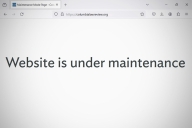
‘Unprecedented Steps’: Board Pulls Plug on Columbia Law Review Website
After student editors published a submitted article Monday accusing Israel of genocide, the journal’s Board of Direct
- Become a Member
- Sign up for Newsletters
- Learning & Assessment
- Diversity & Equity
- Career Development
- Labor & Unionization
- Shared Governance
- Academic Freedom
- Books & Publishing
- Financial Aid
- Residential Life
- Free Speech
- Physical & Mental Health
- Race & Ethnicity
- Sex & Gender
- Socioeconomics
- Traditional-Age
- Adult & Post-Traditional
- Teaching & Learning
- Artificial Intelligence
- Digital Publishing
- Data Analytics
- Administrative Tech
- Alternative Credentials
- Financial Health
- Cost-Cutting
- Revenue Strategies
- Academic Programs
- Physical Campuses
- Mergers & Collaboration
- Fundraising
- Research Universities
- Regional Public Universities
- Community Colleges
- Private Nonprofit Colleges
- Minority-Serving Institutions
- Religious Colleges
- Women's Colleges
- Specialized Colleges
- For-Profit Colleges
- Executive Leadership
- Trustees & Regents
- State Oversight
- Accreditation
- Politics & Elections
- Supreme Court
- Student Aid Policy
- Science & Research Policy
- State Policy
- Colleges & Localities
- Employee Satisfaction
- Remote & Flexible Work
- Staff Issues
- Study Abroad
- International Students in U.S.
- U.S. Colleges in the World
- Intellectual Affairs
- Seeking a Faculty Job
- Advancing in the Faculty
- Seeking an Administrative Job
- Advancing as an Administrator
- Beyond Transfer
- Call to Action
- Confessions of a Community College Dean
- Higher Ed Gamma
- Higher Ed Policy
- Just Explain It to Me!
- Just Visiting
- Law, Policy—and IT?
- Leadership & StratEDgy
- Leadership in Higher Education
- Learning Innovation
- Online: Trending Now
- Resident Scholar
- University of Venus
- Student Voice
- Academic Life
- Health & Wellness
- The College Experience
- Life After College
- Academic Minute
- Weekly Wisdom
- Reports & Data
- Advertising & Marketing
- Consulting Services
- Data & Insights
- Hiring & Jobs
- Event Partnerships
4 /5 Articles remaining this month.
Sign up for a free account or log in.
- Create Free Account
Student-loan borrowers enrolled in Biden's new repayment plan may have gotten a win after a federal judge ruled only 3 states 'just barely' had standing to challenge the plan
- Eleven GOP state attorneys general filed a lawsuit to block the SAVE student-loan repayment plan.
- A district judge in Kansas ruled that only three of those states had standing to sue.
- Even so, the judge said, their case is weak.

Student-loan borrowers enrolled in President Joe Biden's new repayment plan may have just gotten some relief from legal challenges.
In March, 11 Republican state attorneys general filed a lawsuit in Kansas to block the Saving on Valuable Education, or SAVE, income-driven repayment plan , arguing that the plan — which gives borrowers lower monthly payments and a shortened timeline to debt relief — went against the Supreme Court's decision last summer to block Biden's broad debt-cancellation plan .
The states requested that the Kansas district court stop the SAVE plan's implementation. Judge Daniel Crabtree issued his response on June 7, and he said that only three states — South Carolina, Texas, and Alaska — "just barely" had standing to prove the SAVE plan would reduce their states' revenues.
Related stories
To prove standing, plaintiffs had to show that they'd be injured by the policy, that the injury could be traced back to the defendant, and that the relief they were seeking would address those injuries. Crabtree wrote that the three states' standing was "weaker than the one that prevailed" at the Supreme Court.
Crabtree also said that the other eight plaintiffs' argument that the SAVE plan's relief would undermine their recruiting efforts through the Public Service Loan Forgiveness program has not, and will not, hold up in court.
"No court has ever bought into this theory, and this court declines to become the first," he wrote. "These plaintiffs simply have no skin in the game. Their answer to Justice Scalia's colloquial expression of standing — What's it to you? — is this: It's nothing."
Crabtree added that this case is different from Biden v. Nebraska, the case brought before the Supreme Court. In Biden v. Nebraska, he said, the plaintiffs argued that Biden's plan at the time to forgive up to $20,000 in student debt for borrowers making under $125,000 a year would harm the Missouri Higher Education Loan Authority , a student-loan company, because it would no longer be able to collect revenue from servicing forgiven loans.
In the case to block SAVE, Crabtree said the states were not arguing they would lose money from servicing loans. They instead argued that SAVE would cost them interest revenue because borrowers would have an incentive to consolidate privately held loans into direct loans, making the federal government their sole lender.
Biden's student-debt-relief efforts have faced a number of legal challenges. In April, another seven GOP attorneys general filed a separate lawsuit to block SAVE , and in October, the New Civil Liberties Alliance filed a lawsuit on behalf of conservative groups the Cato Institute and Mackinac Center for Public Policy to block the Education Department's one-time account adjustments.
Regarding the latter case, the Sixth Circuit Court of Appeals in May rejected the groups' appeal to block the account adjustments because their argument that the relief would undermine PSLF recruiting was "unconvincing and illogical."
The Education Department has maintained that its relief efforts are in accordance with the law. It's also trying to implement a broader student-loan-forgiveness plan to replace the one the Supreme Court struck down, which is also likely to result in lawsuits .
More from Ayelet Sheffey
Most popular
Watch: why student loans aren't canceled, and what biden's going to do about it.
- Main content

COMMENTS
Create, Download, & Print A Business Plan - Simple Platform - Try Today! Customize Business Plan Templates Online. Print & Download Now!
We Specialize in Business Formation. Best Value Prices & the Fastest Turnaround Time! Starting Your Business Doesn't Need To Be Complicated Or Expensive. Let Us Help.
The primary objectives of the business plan for Cooper's Cup are below: To increase revenues by $36,000 or 5% in Year 2 and $73,000 or 10% by Year 3. Achieve a profit margin of 5.2% in Year 2 and 6.90% by Year 3. Be the Cafe of Choice in the Phoenix area and the recipient of the Best Coffeehouse Award.
In this section, we'll explore 10 types of business plan examples for student entrepreneurship. 1. Traditional Business Plans. These classic business plans, often prepared on paper, provide a comprehensive overview of the business, detailing its identity, goals, and strategies for success. 2.
Create a plan that fits their needs. Whether small or big, LivePlan can build out the right-sized business plan for your classroom projects. In LivePlan, students can develop a simple lean plan that focuses their ideas, or create a full business plan with all the details and steps necessary to persuade investors, attract partners, and turn their idea into a profitable reality.
ClickUp's Business Plan Template for College Students is here to guide you every step of the way! With this template, you can: Clearly define your business goals and strategies for success. Create a comprehensive financial plan and projections to attract investors. Identify potential obstacles and develop contingency plans.
Takeaways for business plan examples for students. The opportunities are endless if you want to set up a business as a student. Let your imagination run wild and look through business plan examples for students if you want to start selling or offering something new to your school's community.
Creating a business plan as a student can be a daunting task, but with the help of ClickUp's Business Plan Template, you can break it down into manageable steps. Follow these six steps to create a comprehensive business plan that sets you up for success: 1. Define your business idea. Start by clearly defining your business idea.
4. Marketing Strategy. A college business plan should also come with a good marketing strategy. A marketing strategy is perhaps the most important of a business plan. It is the strategic part where plans are made on how to achieve a college's goal, especially when it comes to the number of its enrollees.
If you're a university student looking to start your own business venture, using the Business Plan Template in ClickUp can help you get started. Follow these four steps to create a comprehensive business plan: 1. Define your business concept. Begin by clearly defining your business concept.
Write down the list of equipment, tools, raw materials, and materials needed to create your chosen range of products and services. Calculate the optimum production volumes your equipment can handle. Specify which employees and what kind of downloads you will need. Products. List the products, services, and work that you will offer your customers.
Marketing Plan. Traditionally, a marketing plan includes the four P's: Product, Price, Place, and Promotion. For a school business plan, your marketing strategy should include the following: Product: In the product section, you should reiterate the type of school that you documented in your company overview.
A business plan is "a guide—a roadmap for your business that outlines goals and details how you plan to achieve those goals."--Tim Berry from Bplans site. An Introduction to Business Plans Introduction to a tutorial on business plans written by the staff at Entrepreneur magazine.
Don't forget to download our free business plan template (mentioned just above) so you can follow along as we go. How to Write a Business Plan Step 1. Create a Cover Page. The first thing investors will see is the cover page for your business plan. Make sure it looks professional.
Sample Business Plan mindanao state university iligan institute of technology college of business administration and accountancy department of marketing alibata. ... Students also viewed. M6 Explorer project plan; 2nd Quarter Exam Math 8; Table for revised WHT 2018-2022; English 6 Q3 Week 1; Abaigarlessonplan-3 - Grade 9Lesson plan ...
The business model canvas is a one-page template designed to demystify the business planning process. It removes the need for a traditional, copy-heavy business plan, in favor of a single-page outline that can help you and outside parties better explore your business idea. The structure ditches a linear format in favor of a cell-based template.
A complete business plan Unlike other blank templates, our business plan examples are complete business plans with all of the text and financial forecasts already filled out. Edit the text to make the plan your own and save hundreds of hours. A professional business plan template All 550 of our business plans are in the SBA-approved format that ...
Business Glossary. Definitions for common terminology and acronyms that every small business owner should know. Bplans offers free business plan samples and templates, business planning resources, how-to articles, financial calculators, industry reports and entrepreneurship webinars.
8. Panda Doc's Free Business Plan Template. PandaDoc's free business plan template is one of the more detailed and fleshed-out sample business plans on this list. It describes what you should include in each section, so you don't have to come up with everything from scratch.
Click here for the sample business plan. Restaurant Business Plan. A restaurant business plan will be similar to a coffee shop, but is a little more involved. Start-up costs are higher as it requires a larger storefront and a larger variety of equipment. Variable costs are higher as a quality meal costs much more than a cup of coffee.
When looking at business plan template packages for teens, you are looking for business plan templates that will help you transition your business ideas to full-fledged businesses that will help adults see the vision. The 7 parts of a business plan include: Executive Summary; Business Description; Products and Services; Market Analysis
751 templates. Create a blank Business Plan. Beige Aesthetic Modern Business Plan A4 Document. Document by Rise & Roar Design. Green Professional Strategic Business Plan Executive Summary. Document by Antler. Startup Business Plan. Document by Maea Studio. Startup Business Plan in Cream Black and White Modern Sophisticated Style.
Business Plan Example For Students Business Plan or Proposal Sample For Students 1.0 Executive Summary Of Business Plan. BambooS Sdn. Bhd. company was created by a group of 10 students in the Basic Entrepreneurship course. This company is named BambooS. It produces and sells bamboo-based products. The capital S in the company's name stands ...
How to Write a Student Accommodation Business Plan [Sample Template] 1. Industry Overview. Student accommodation business is classified under the real estate industry and the real estate industry is one of the many industries that is a major contributor to the growth of the economy of many nations of the world.
business plan for abm students department of education division of city taneo memorial high school senior high school department pe from the (business plan) Skip to document. University; High School; Books; Discovery. ... This is an image of the sample product. The team will create a heart shape waffle- not like the regular circle-shaped waffle ...
A good business plan is essential to successfully starting your business — and the easiest way to simplify the work of writing a business plan is to start with a business plan template.. You're already investing time and energy in refining your business model and planning your launch—there's no need to reinvent the wheel when it comes to writing a business plan.
On July 1, millions of federal student loan borrowers will see their monthly bills drop — some by as much as half — as the Biden administration's new income-driven payment plan, known as ...
Some student-loan borrowers will soon get cheaper monthly payments through Biden's new repayment plan — but their accounts might be paused in the meantime Ayelet Sheffey 2024-06-13T16:54:22Z
Jun. 20—A new plan aims to change course funding for North Carolina community colleges to better meet local employers' work force needs. The North Carolina Community College System has unveiled Propel NC, which it terms "a new community college business model for the new N.C. economy." Propel NC proposes investing more money in programs that produce workers for high-demand, high-wage jobs in ...
The University of Florida's plan to open a tech- and business-focused graduate campus in Jacksonville is getting closer to becoming a reality. Governor Ron DeSantis last week approved the state's annual budget, which included a $75 million line item for the campus, WJCT News, Jacksonville's NPR affiliate, reported.
Nebraska, he said, the plaintiffs argued that Biden's plan at the time to forgive up to $20,000 in student debt for borrowers making under $125,000 a year would harm the Missouri Higher Education ...